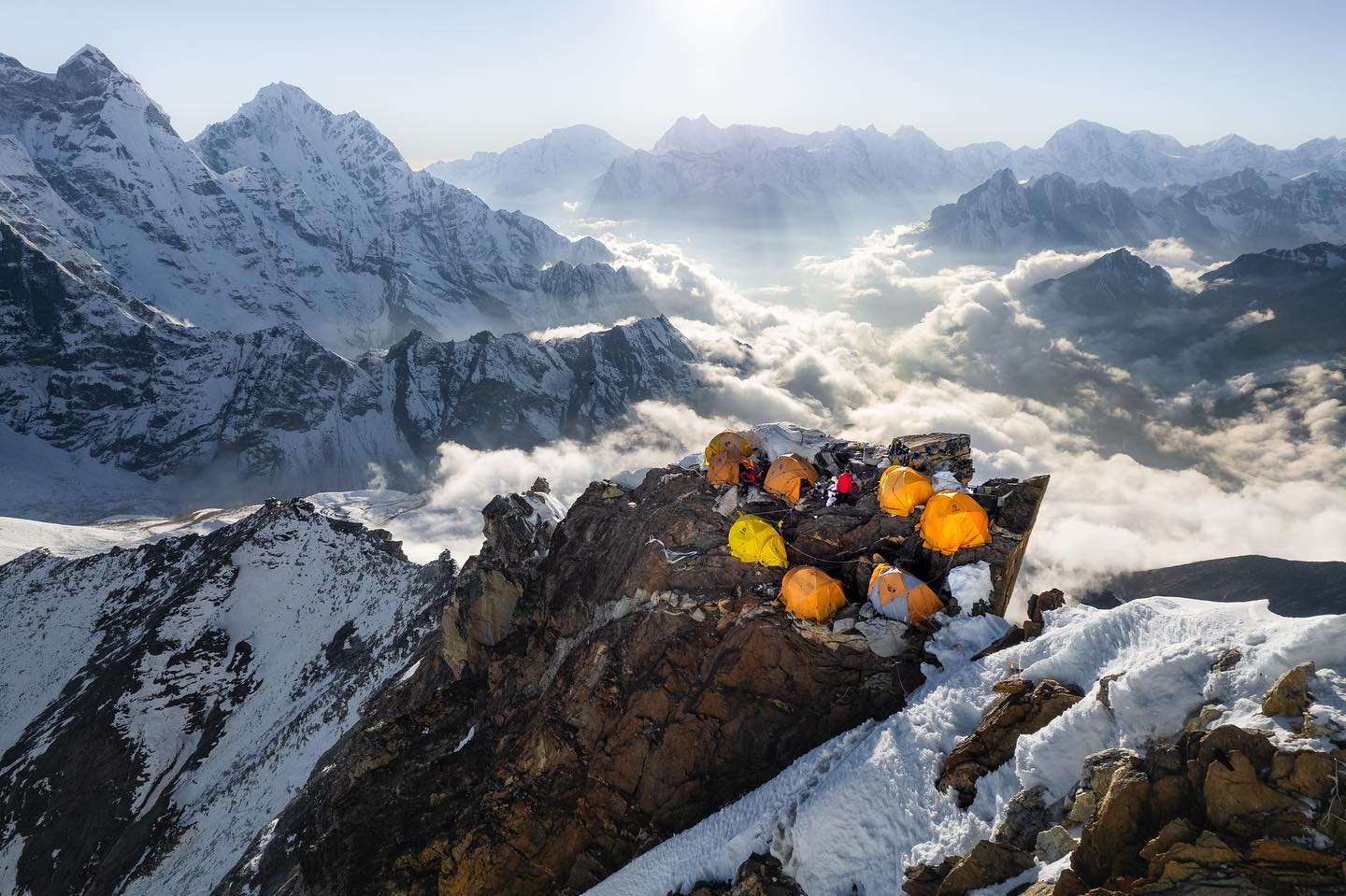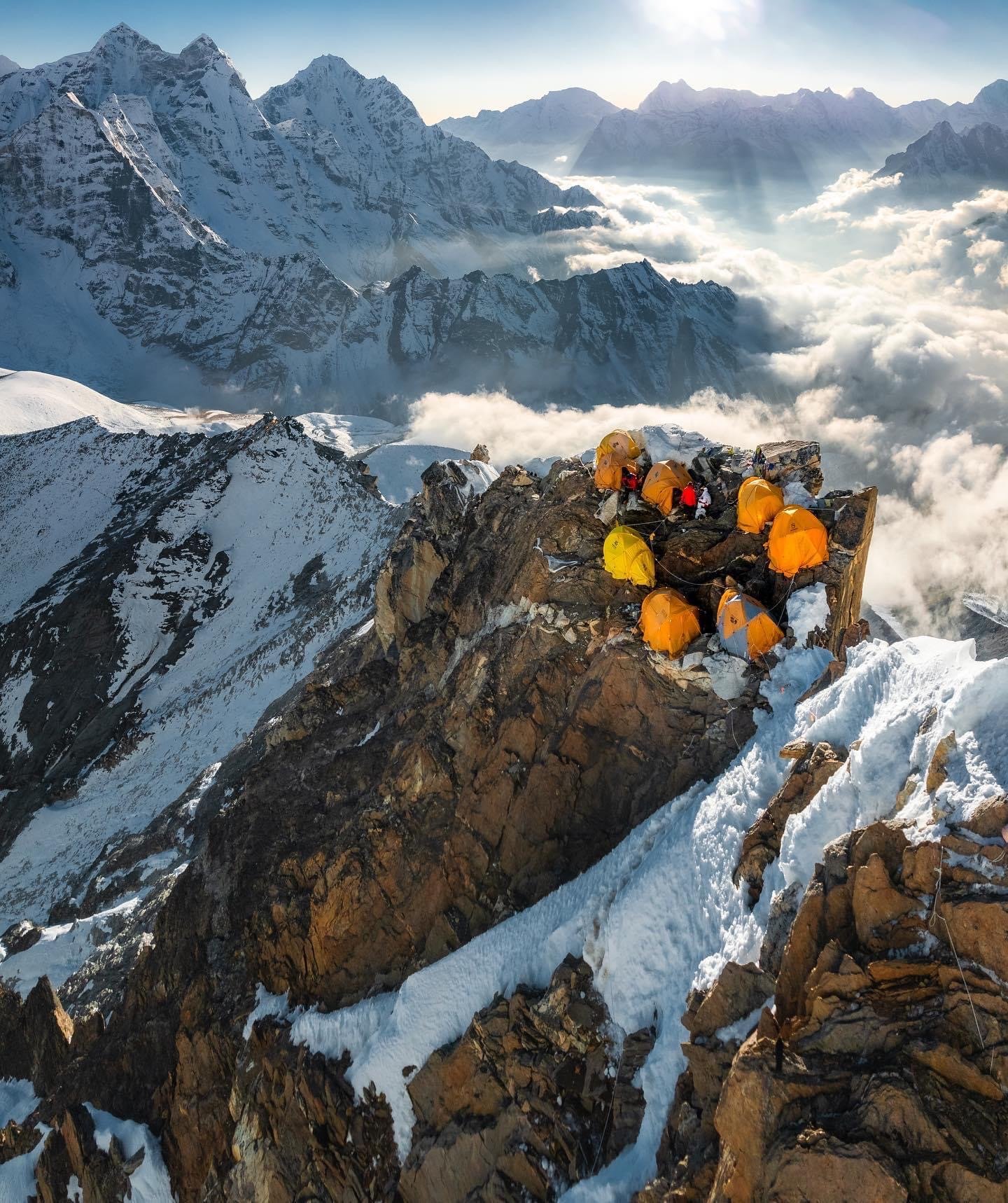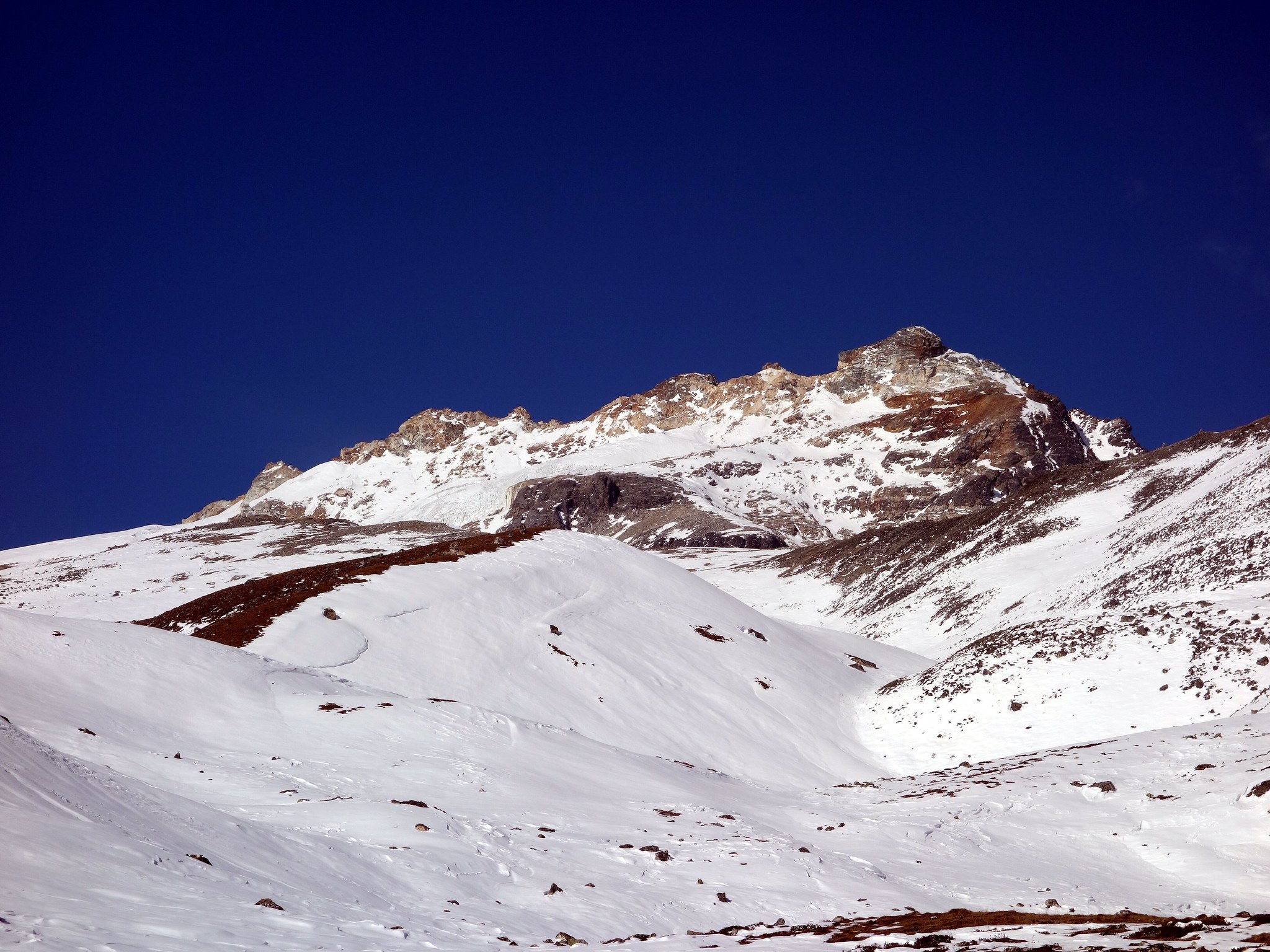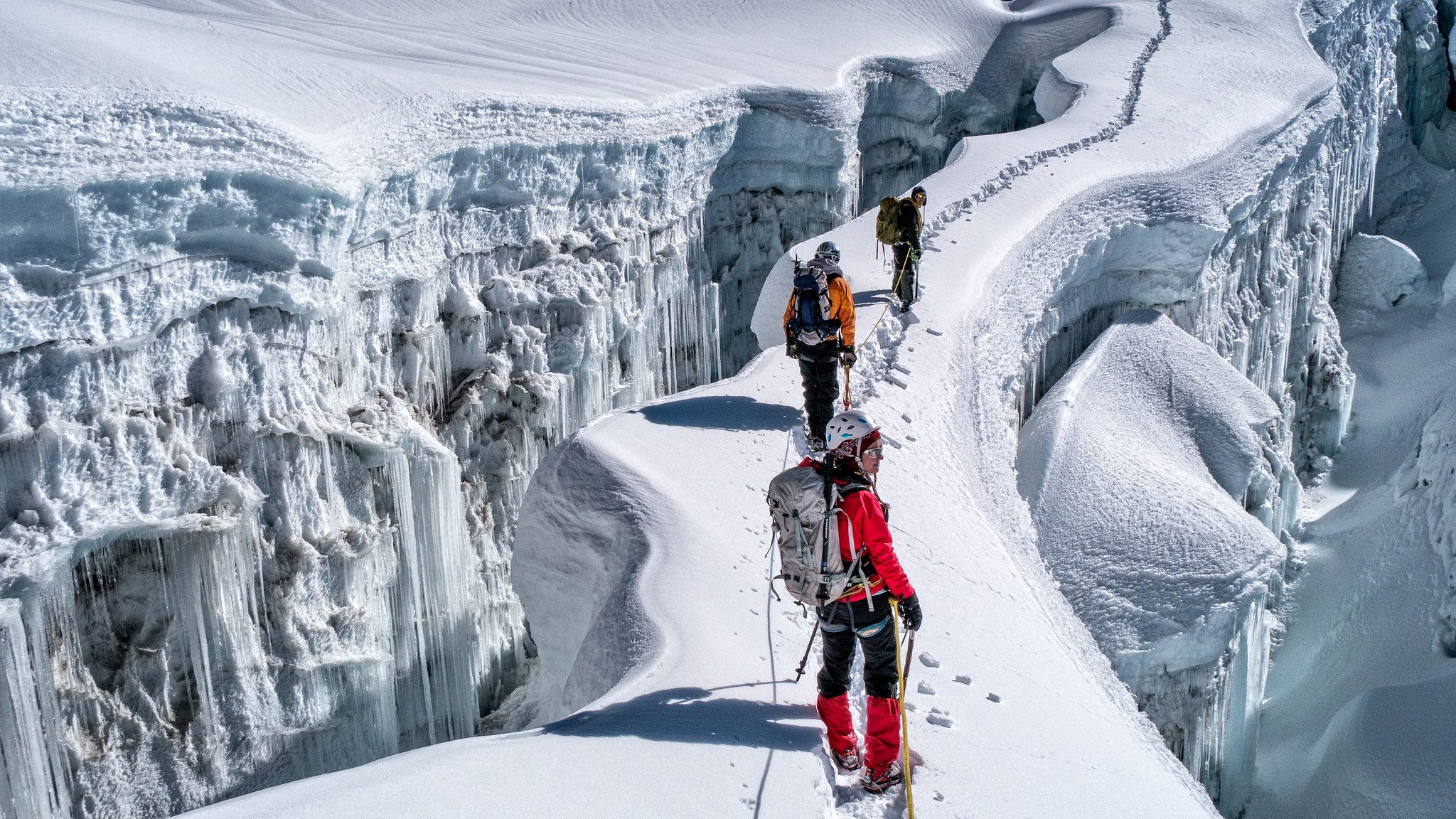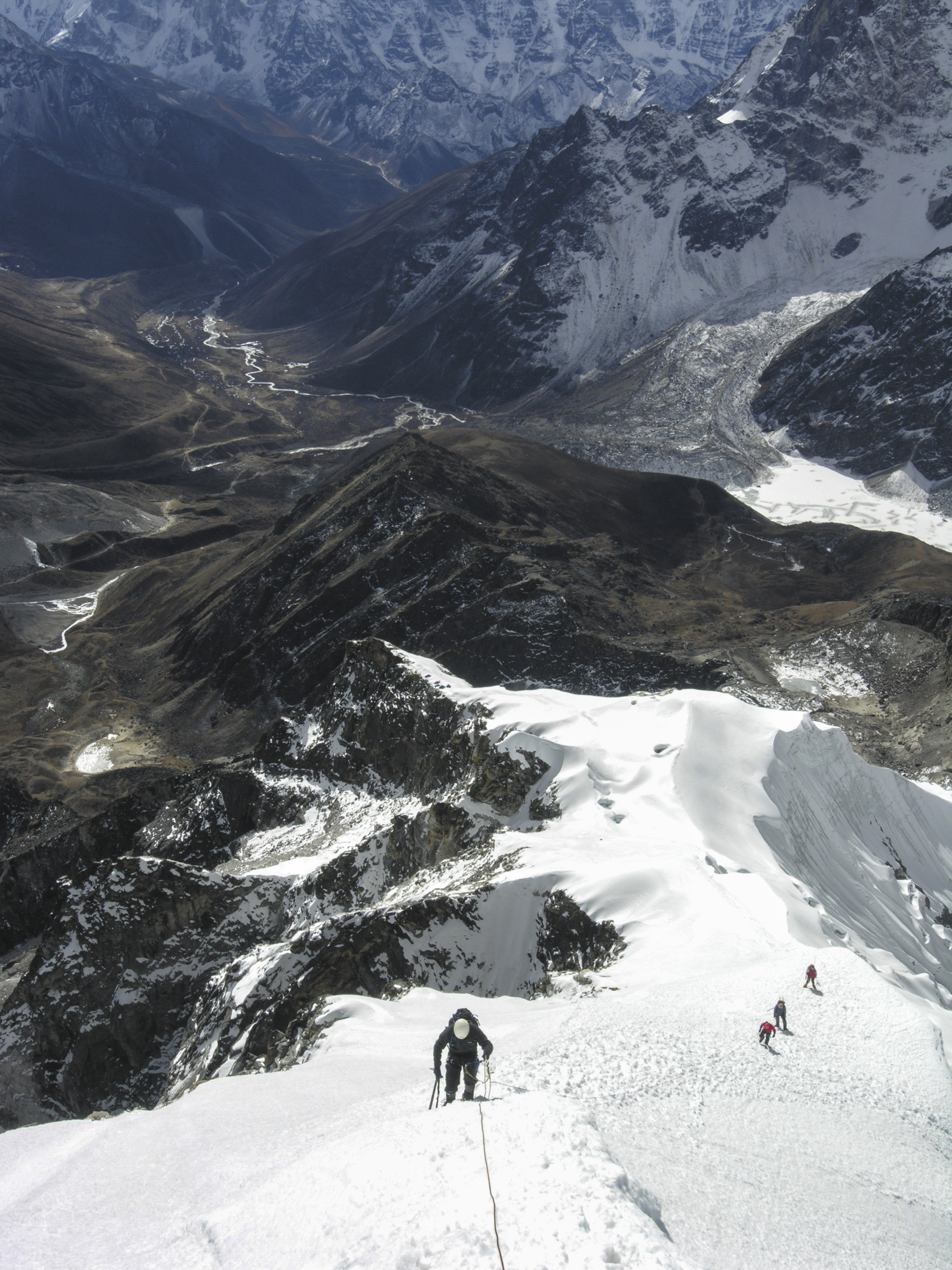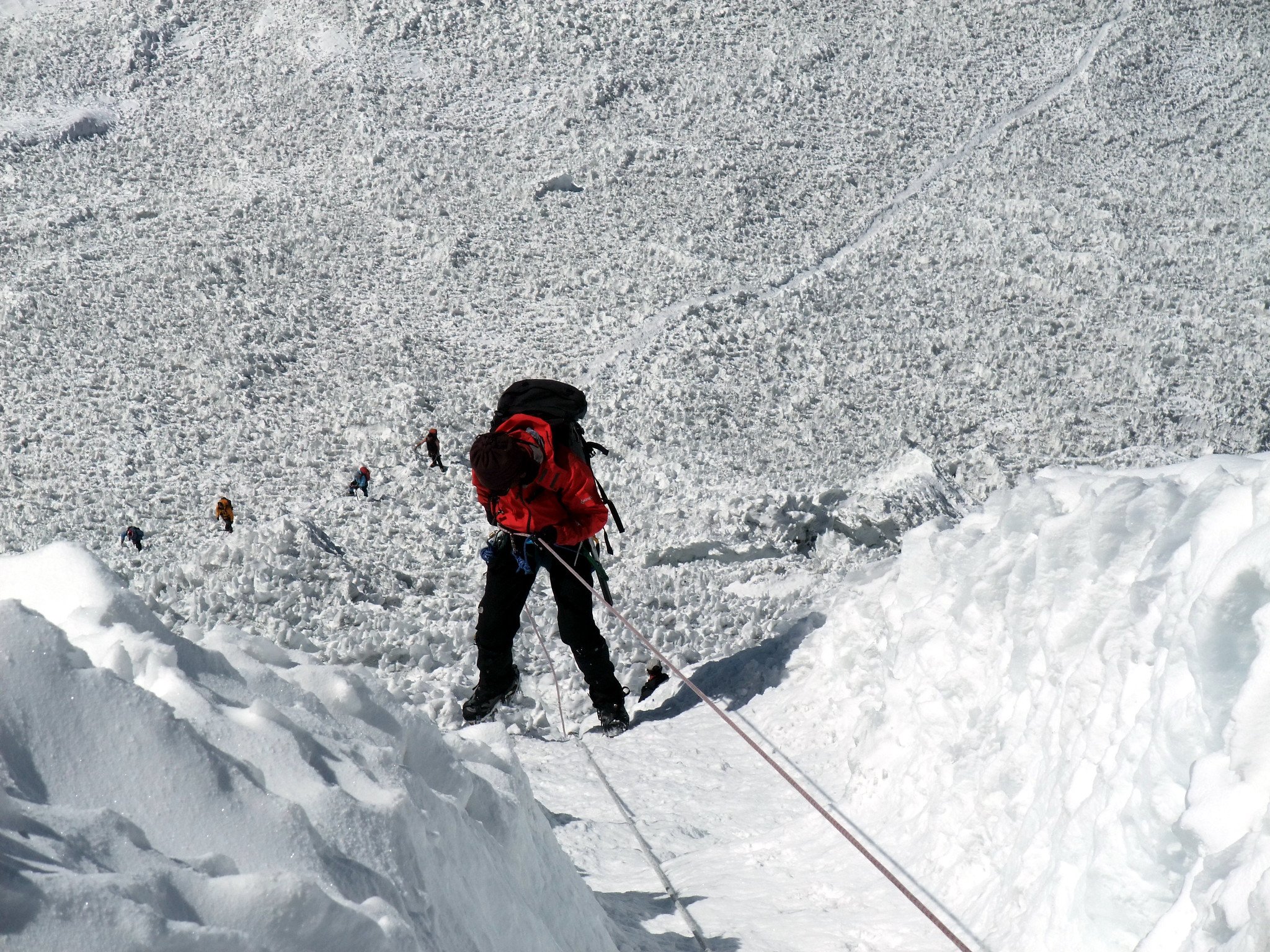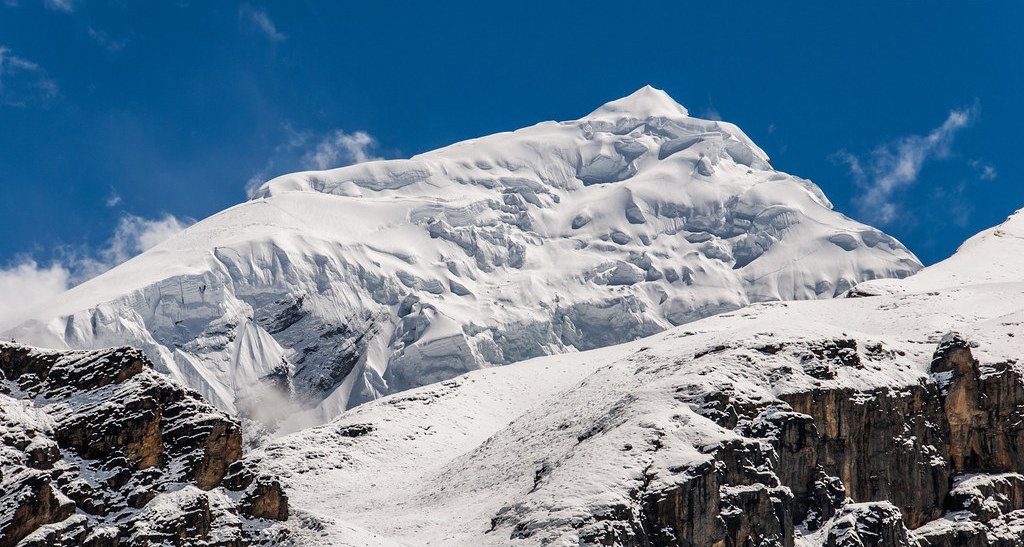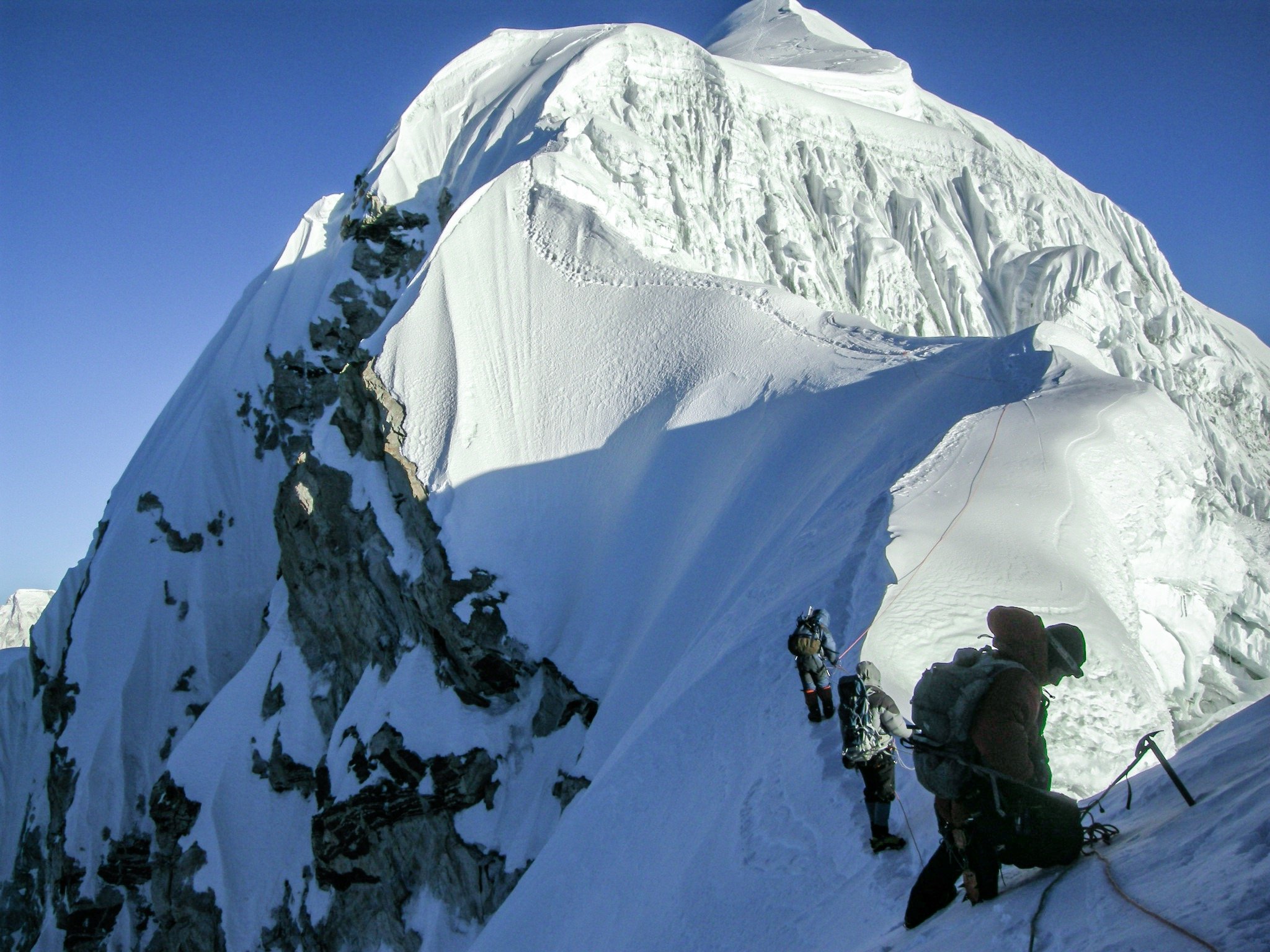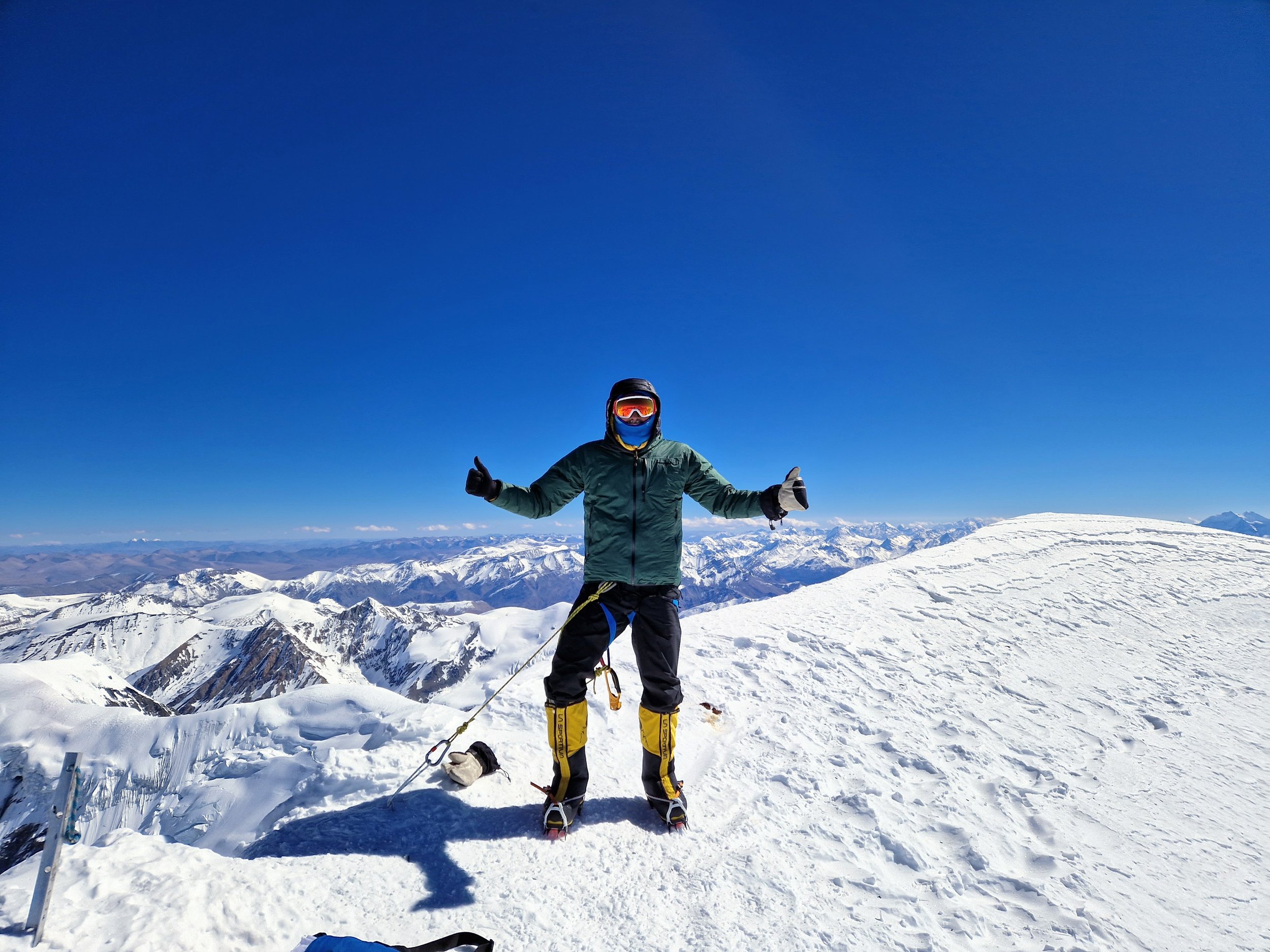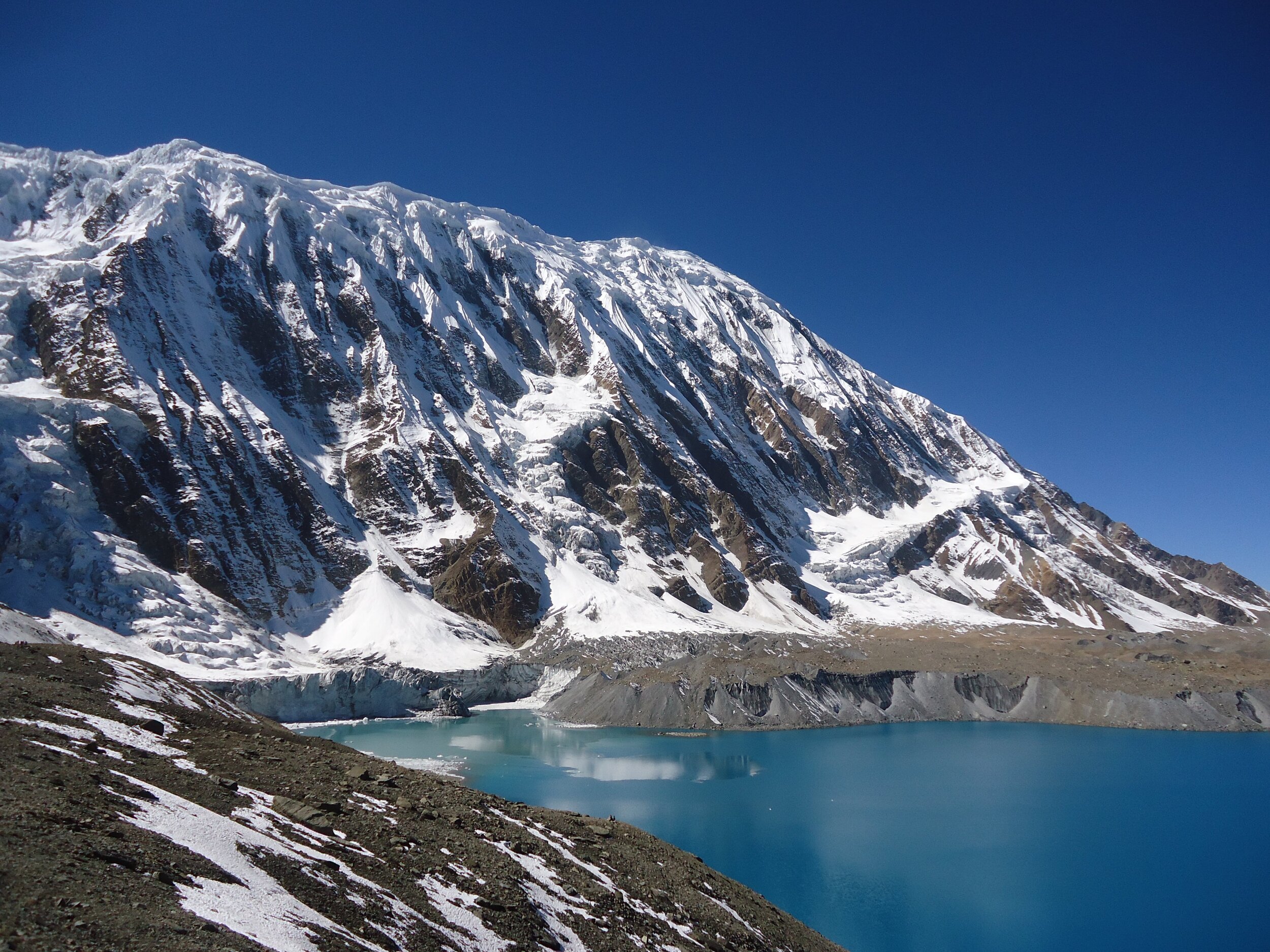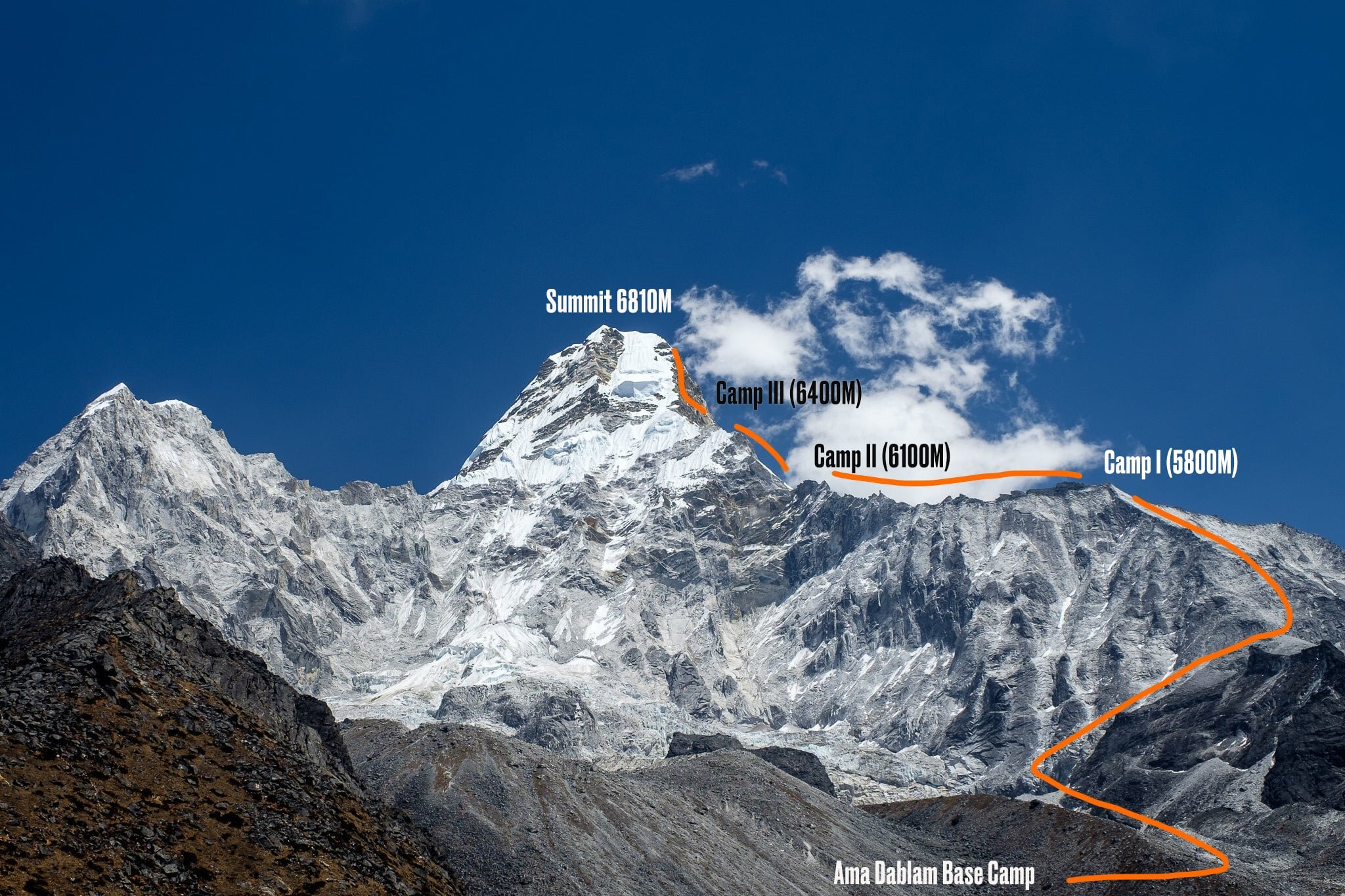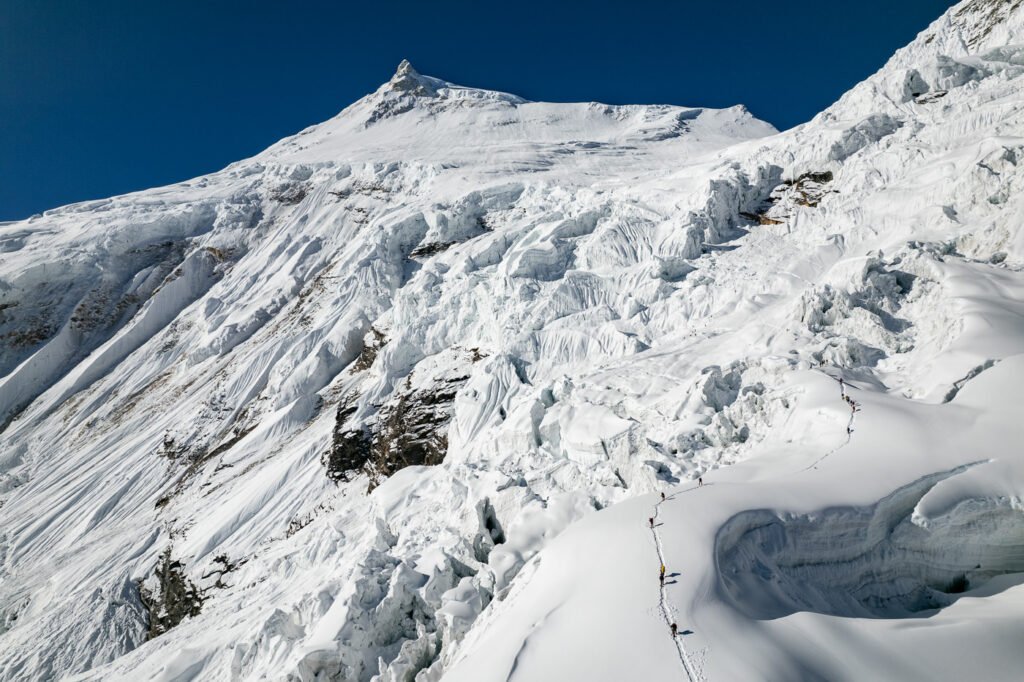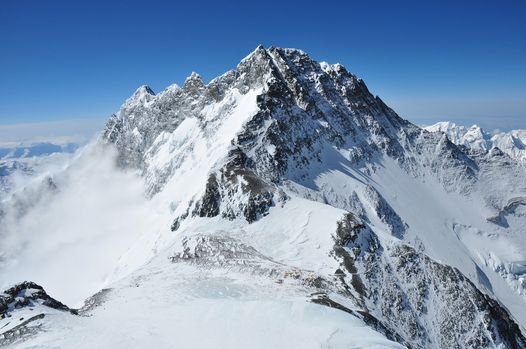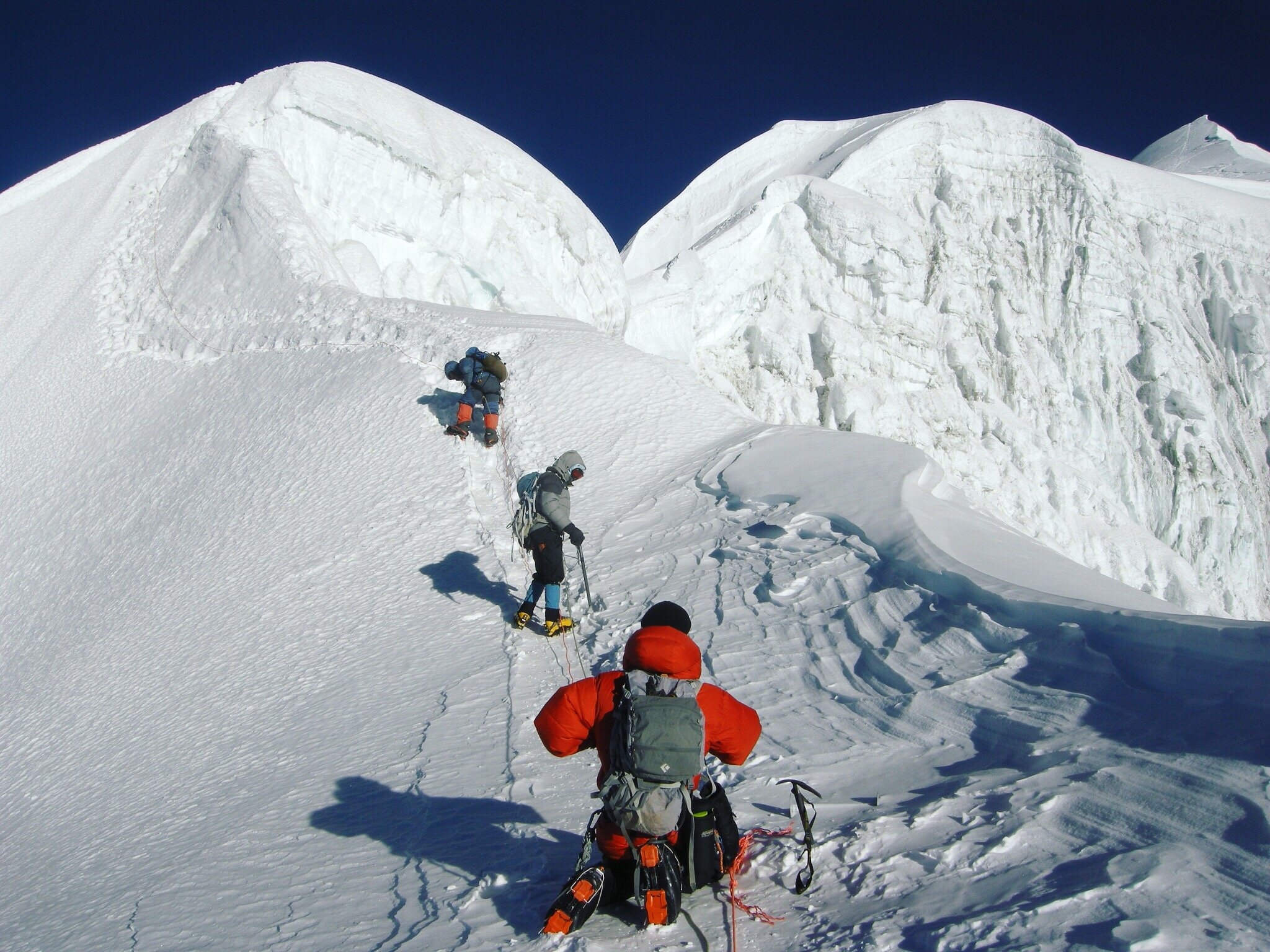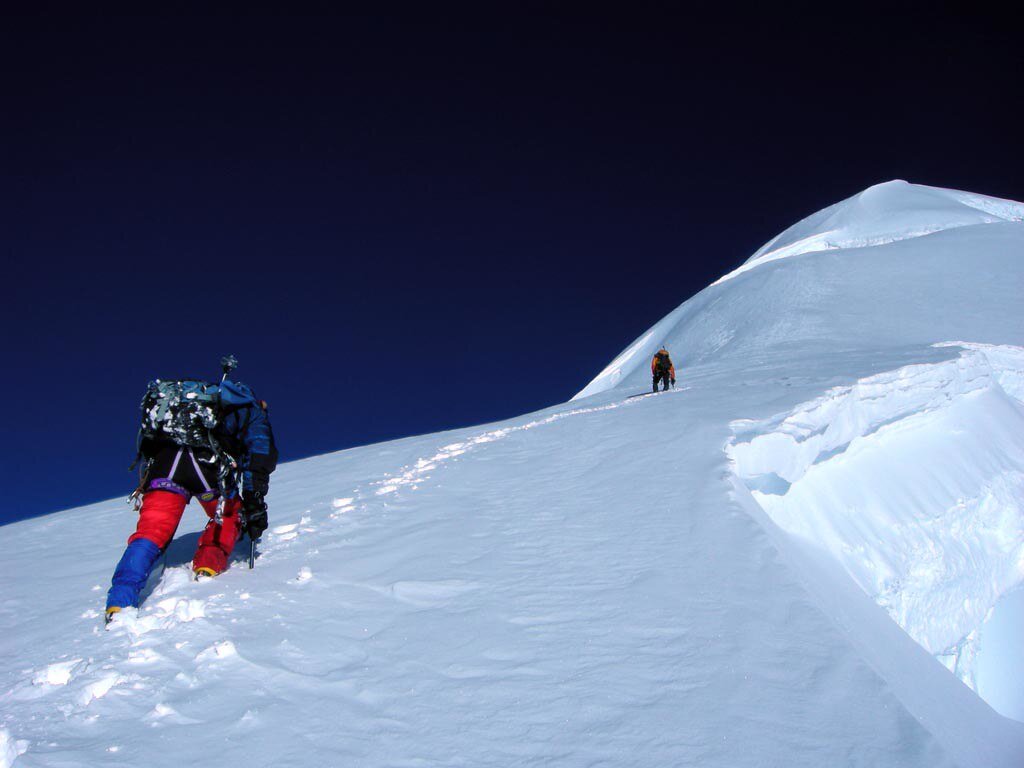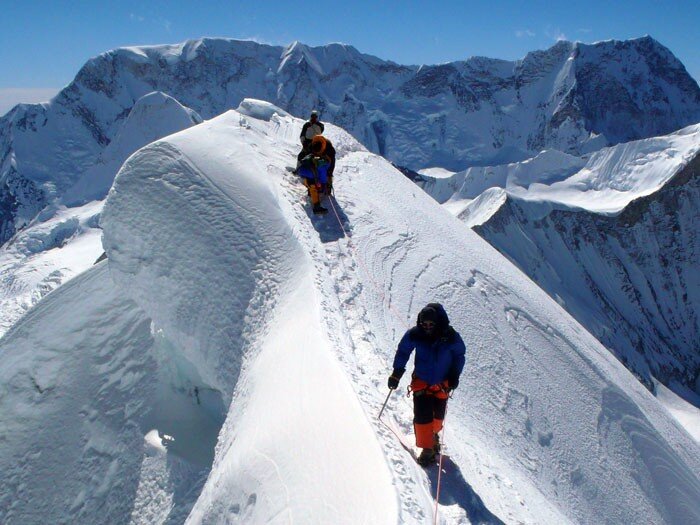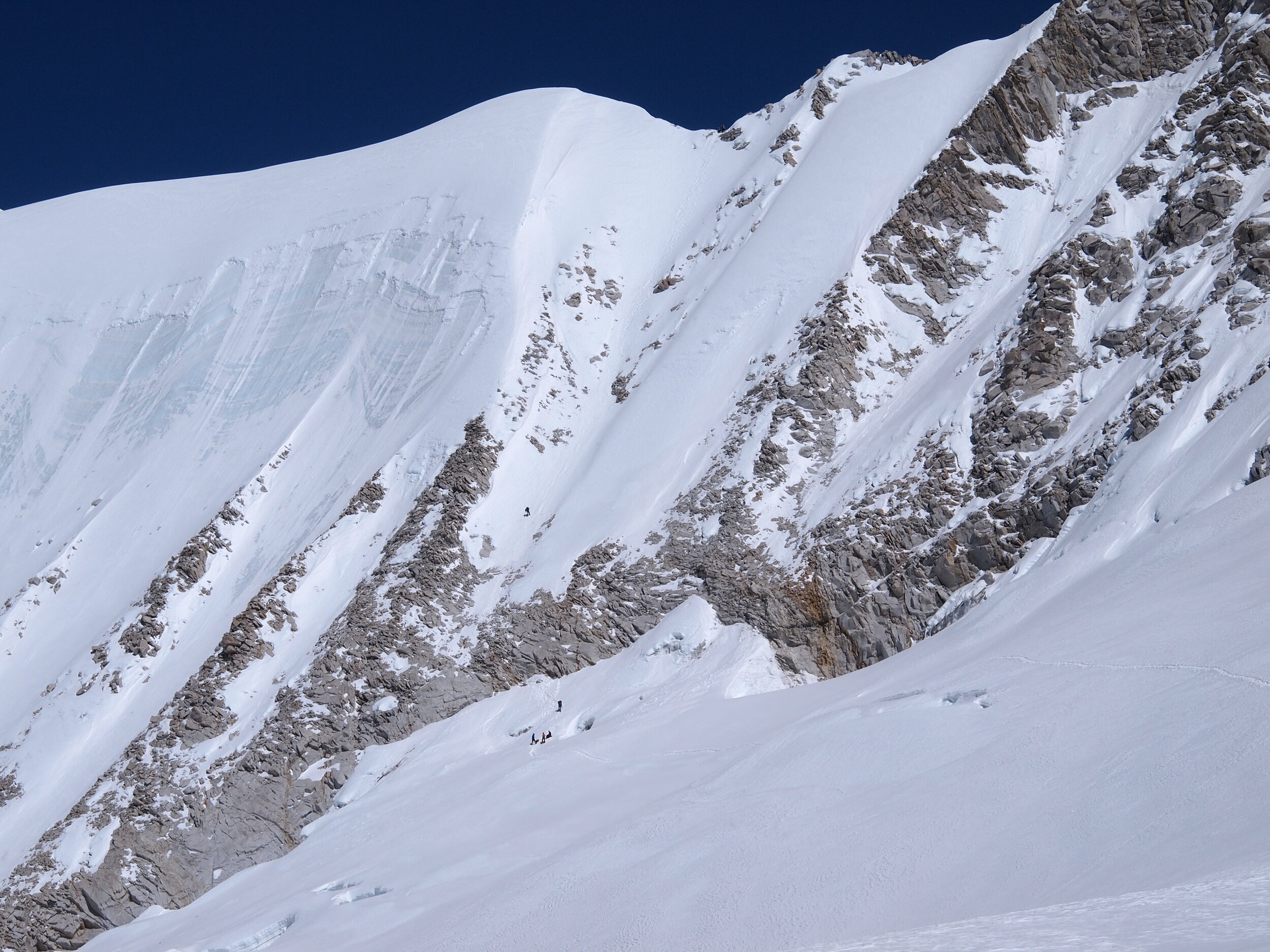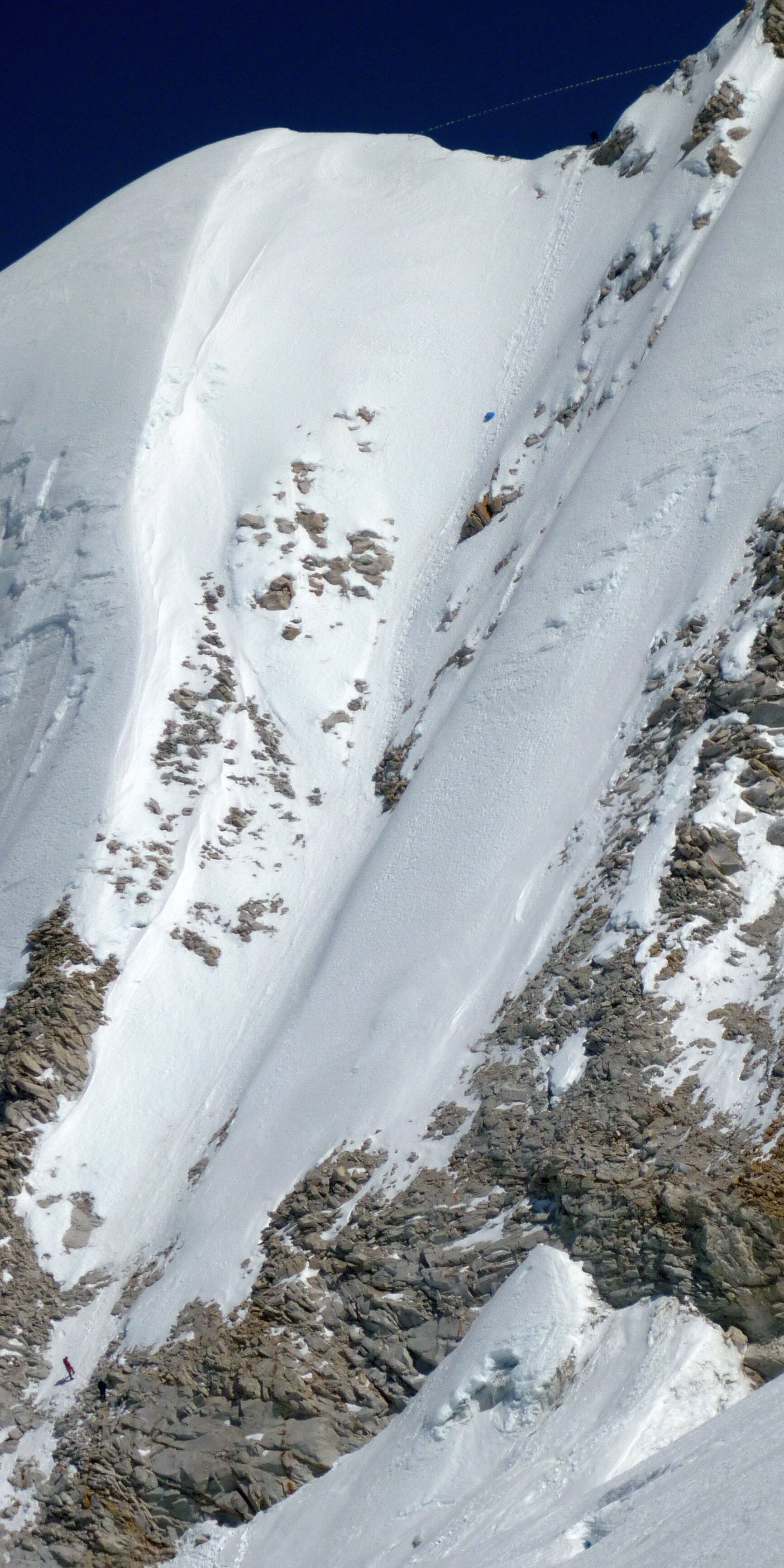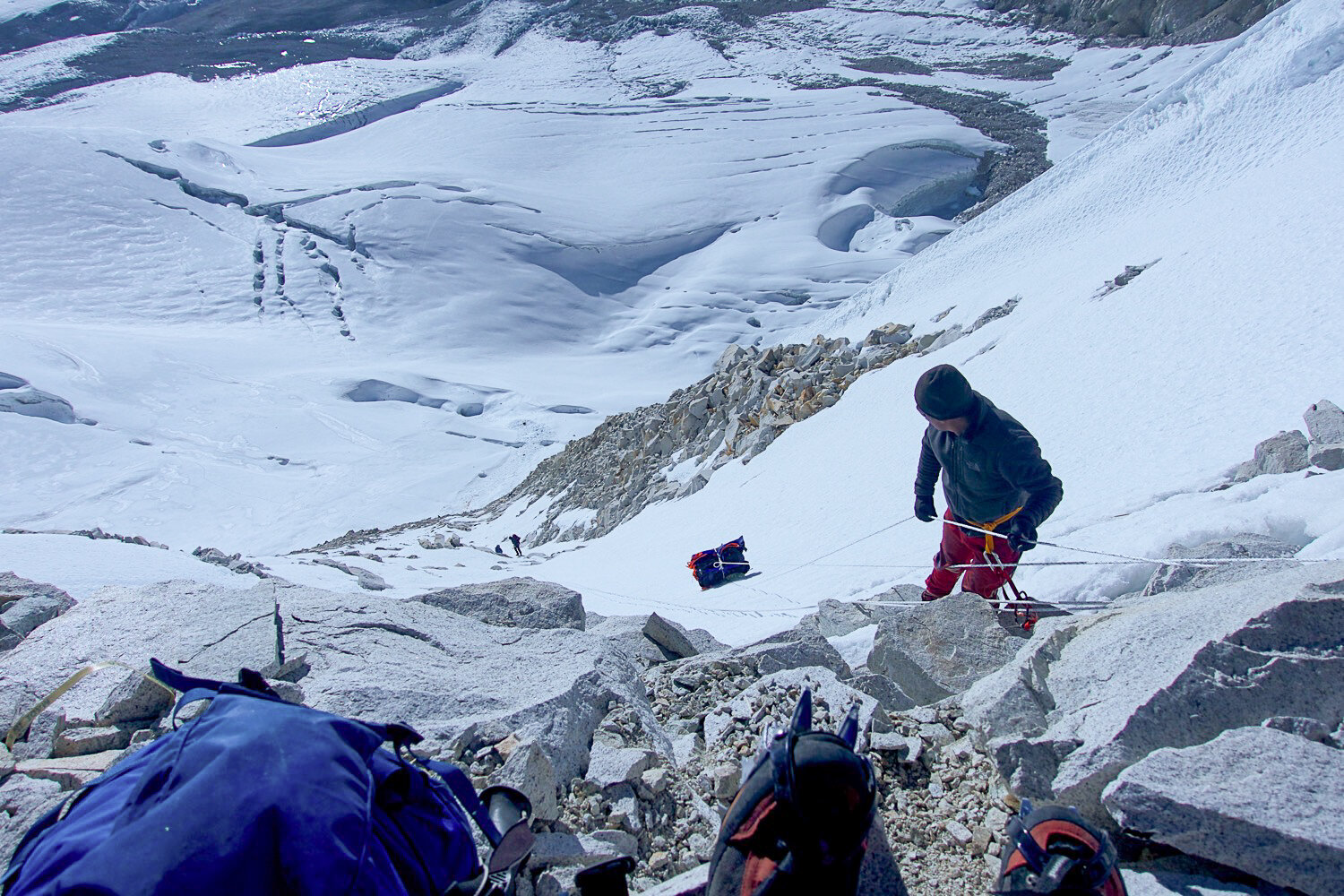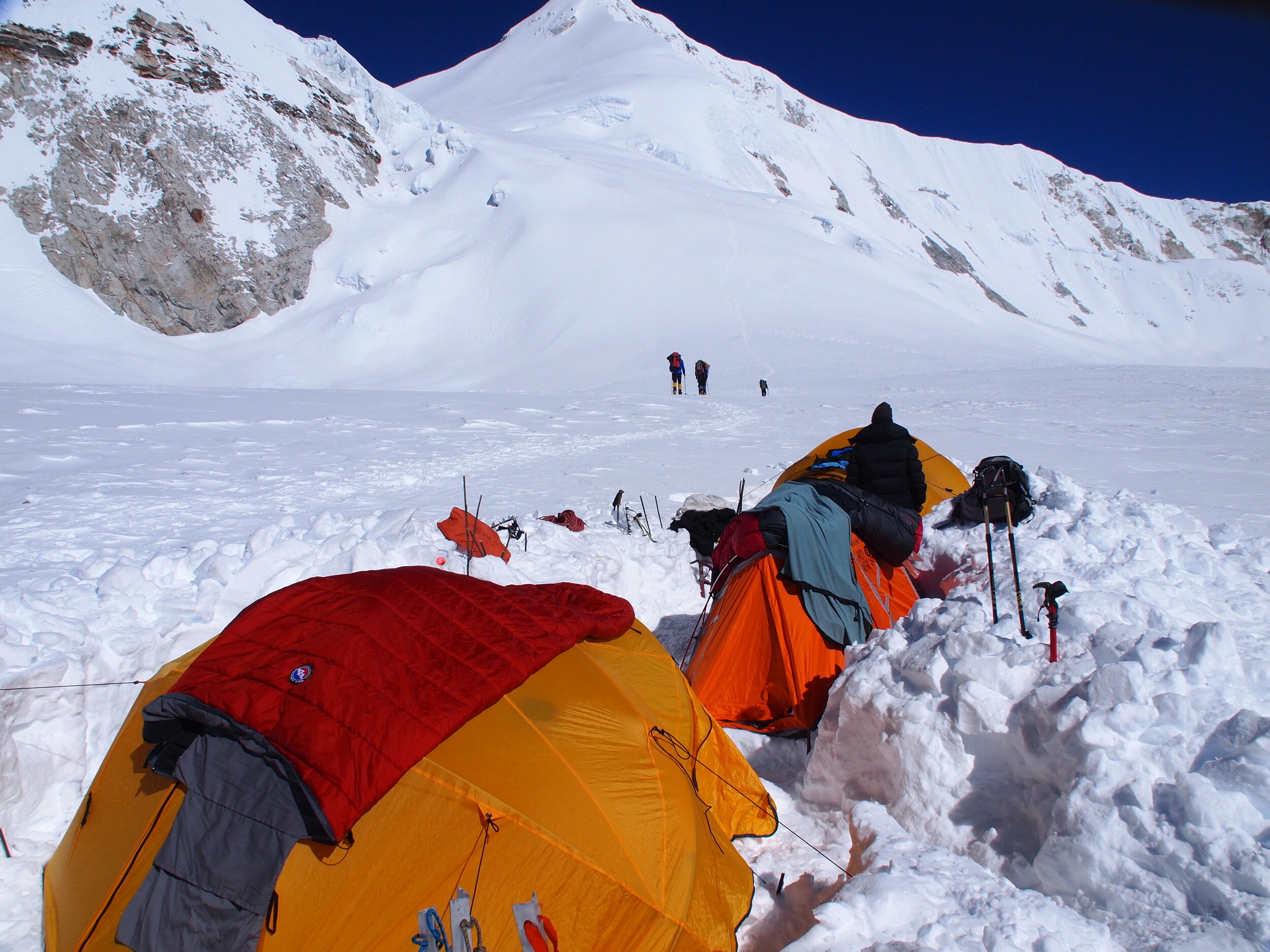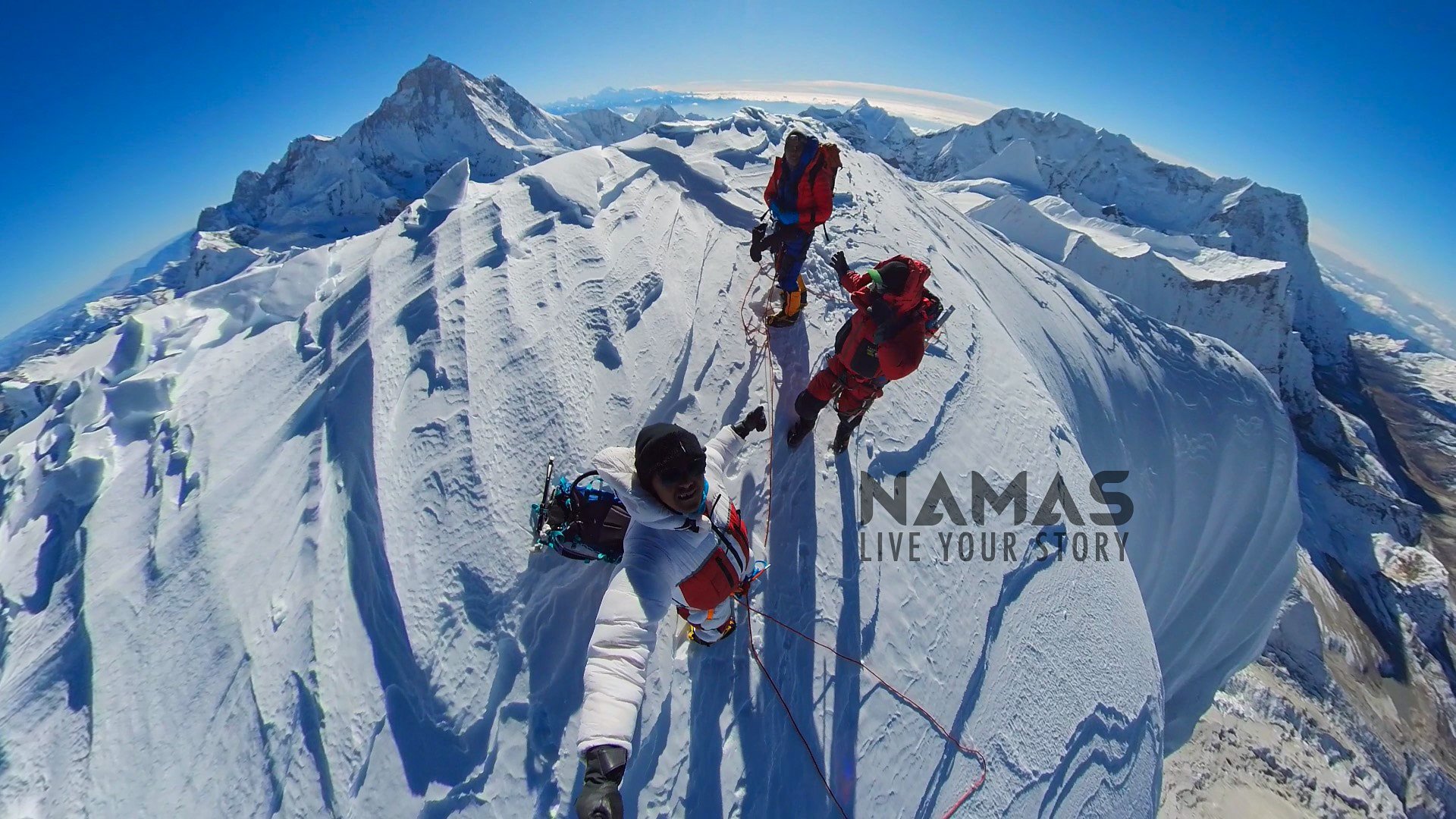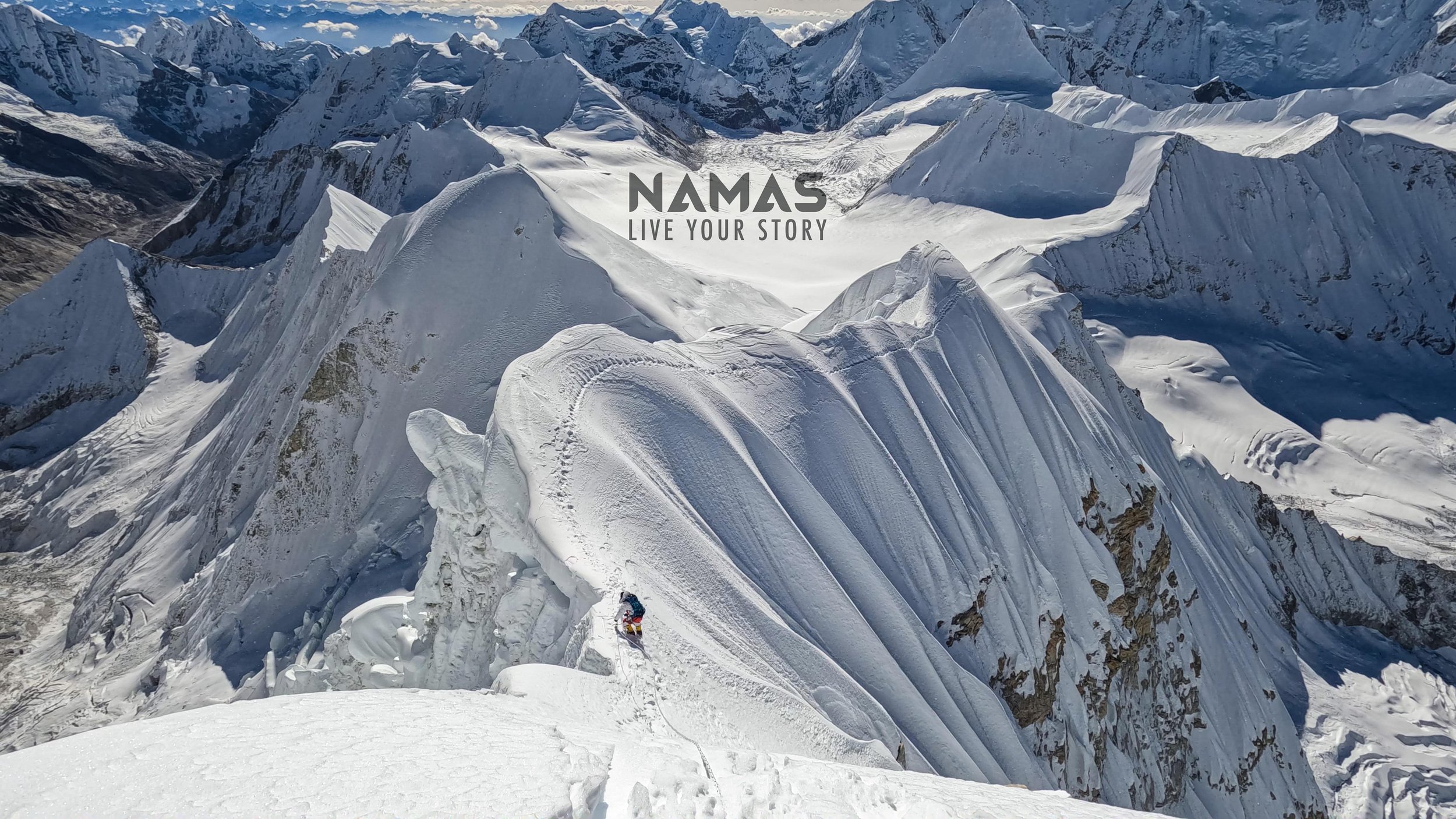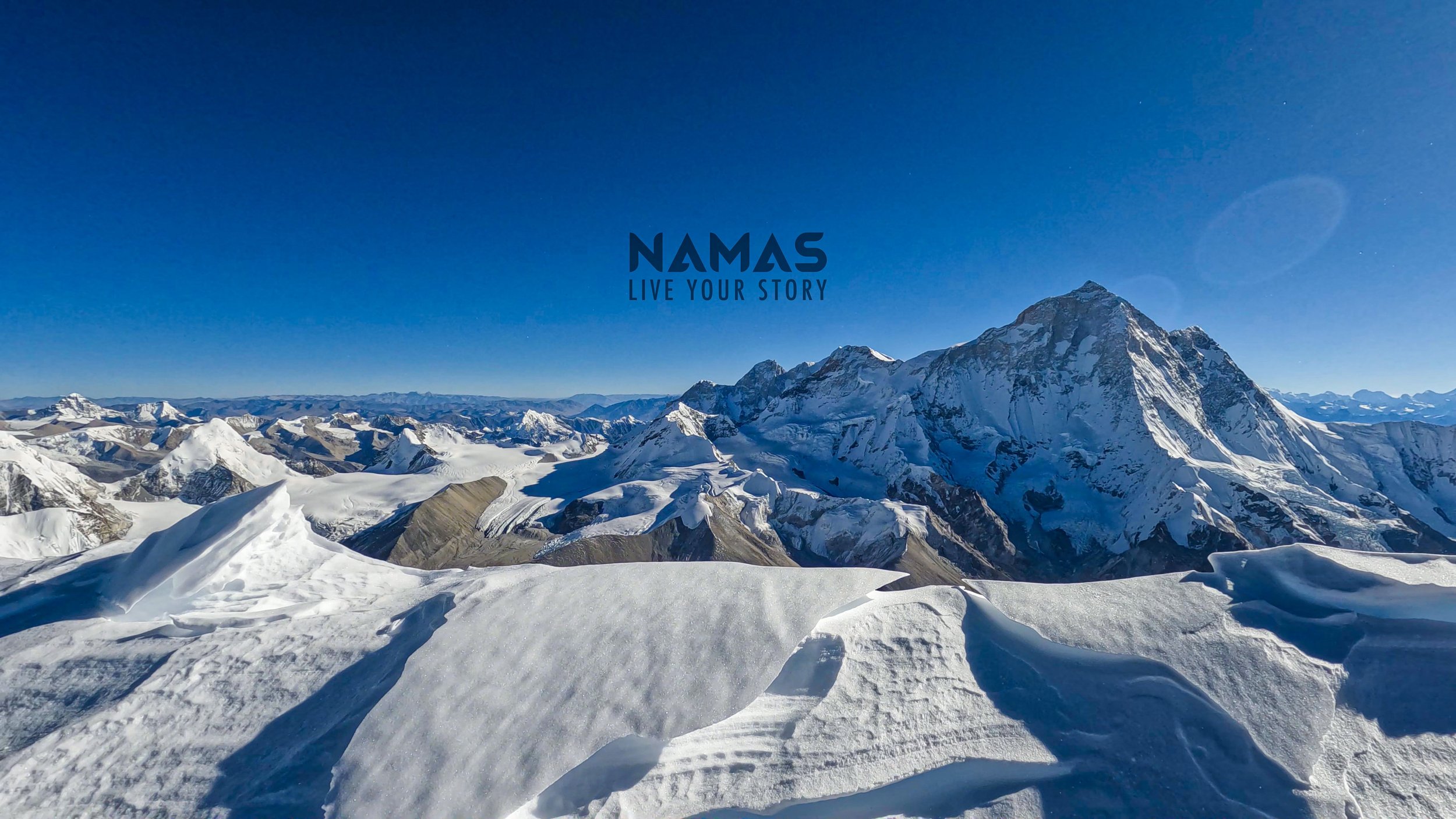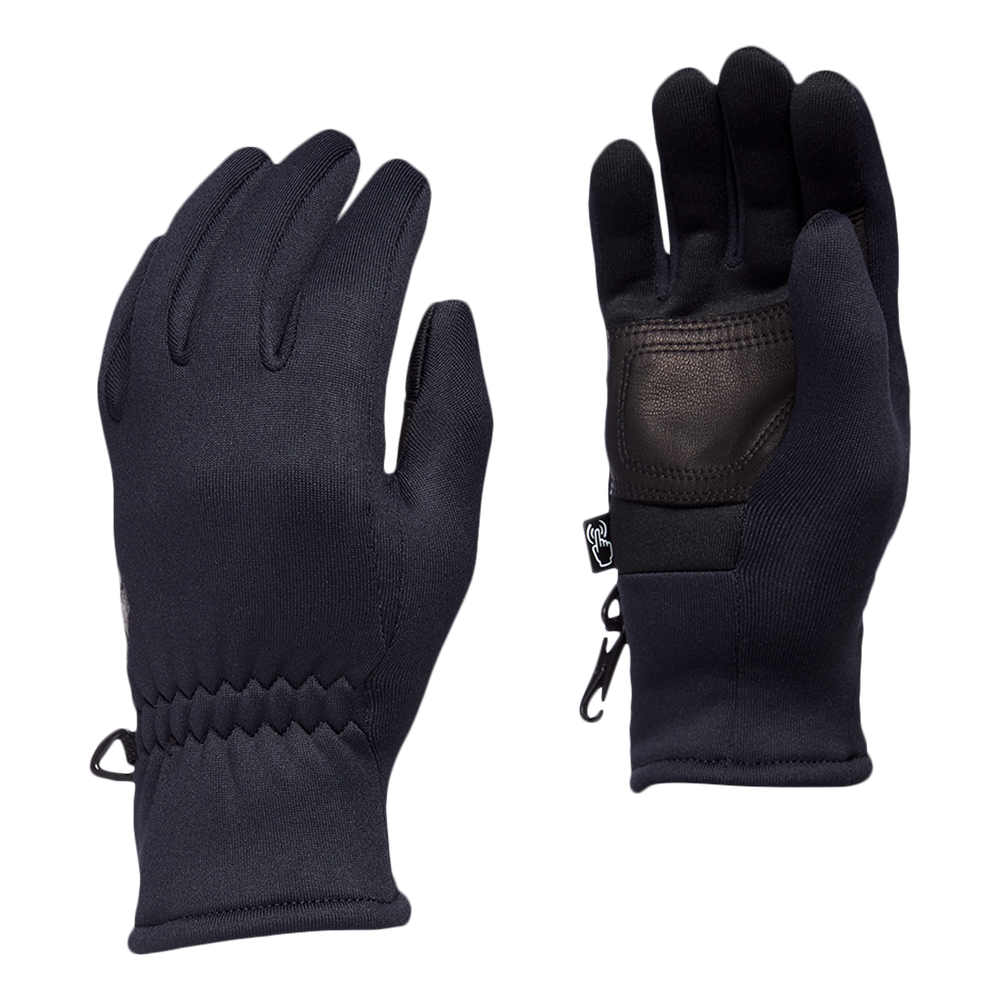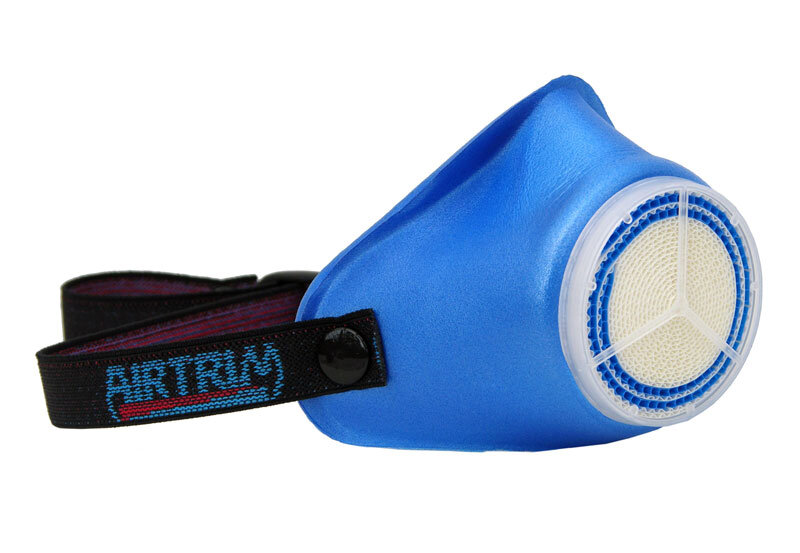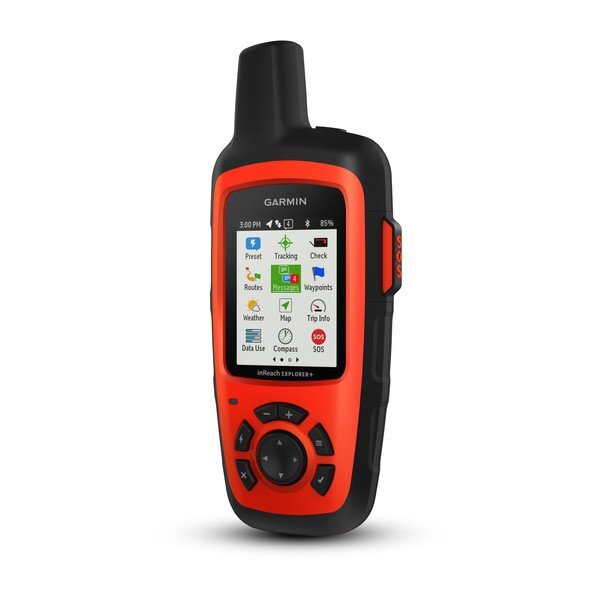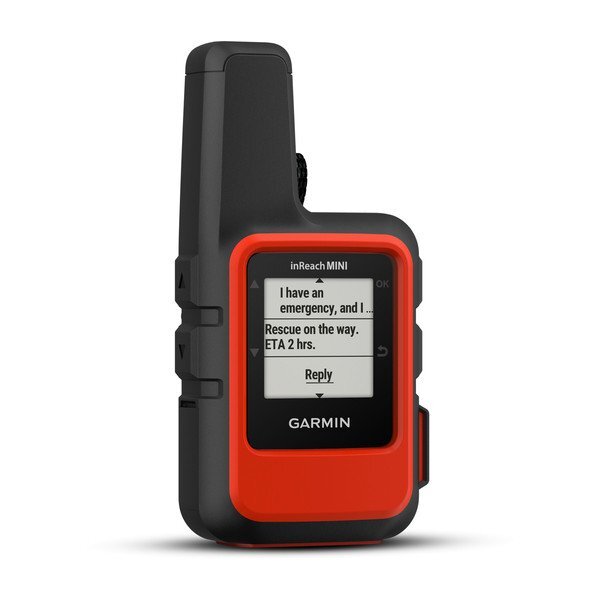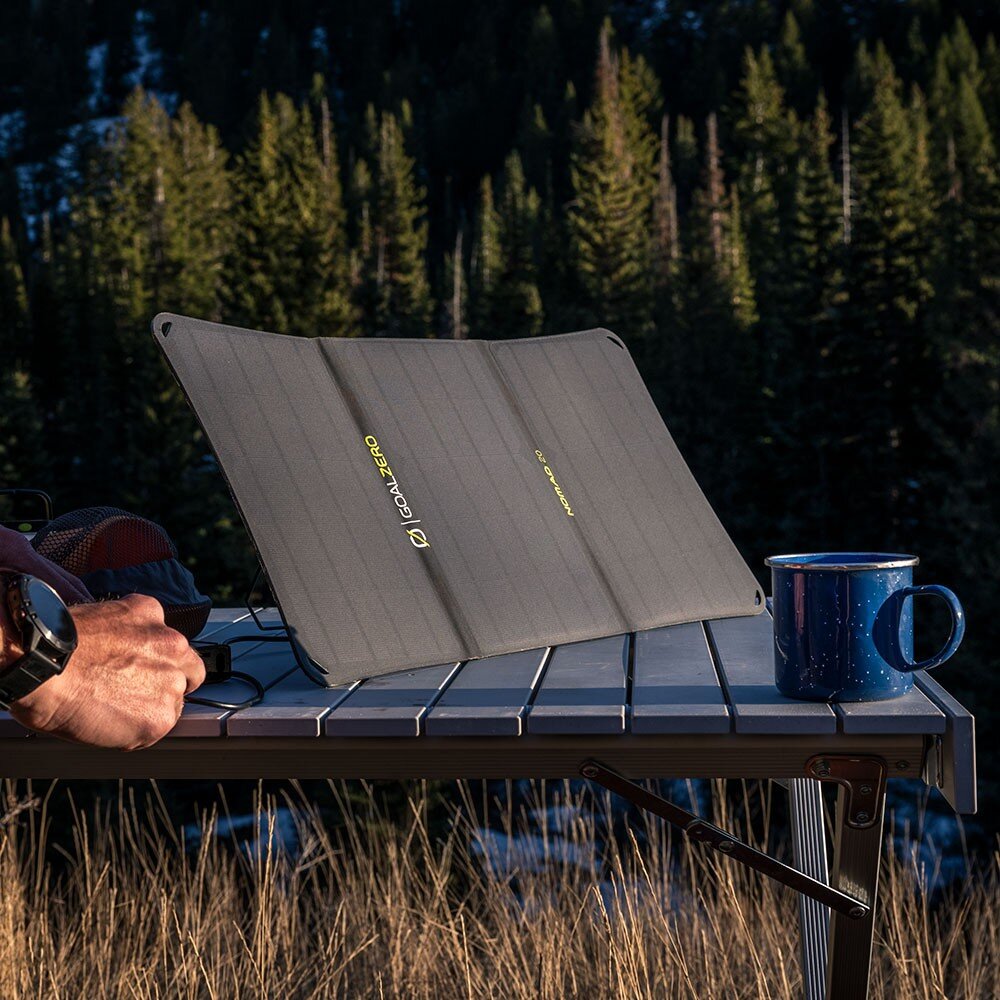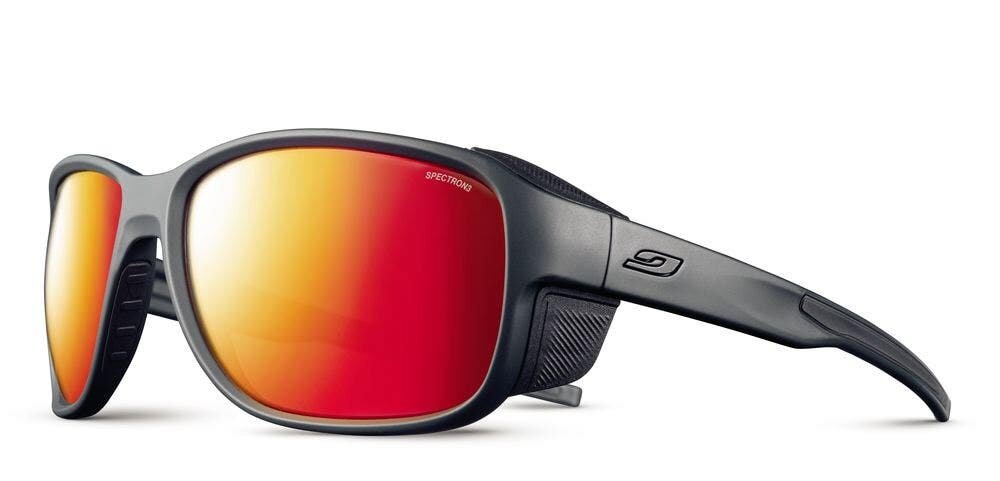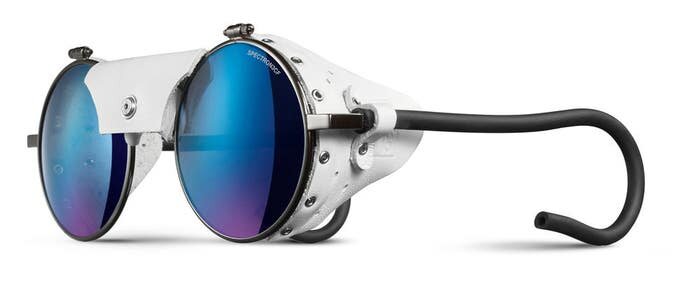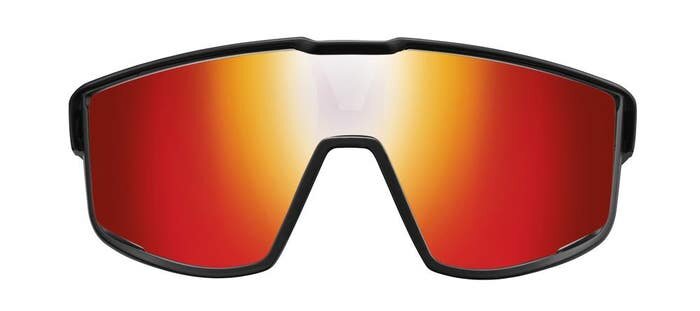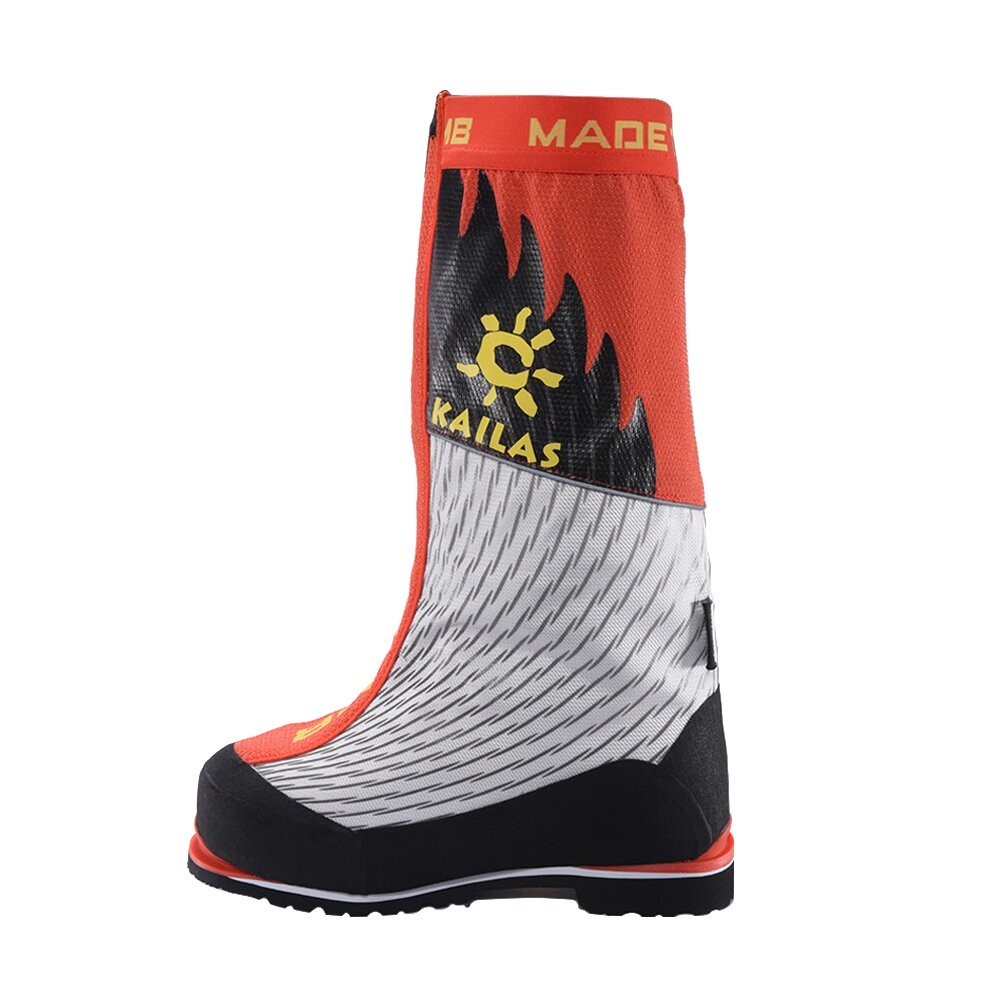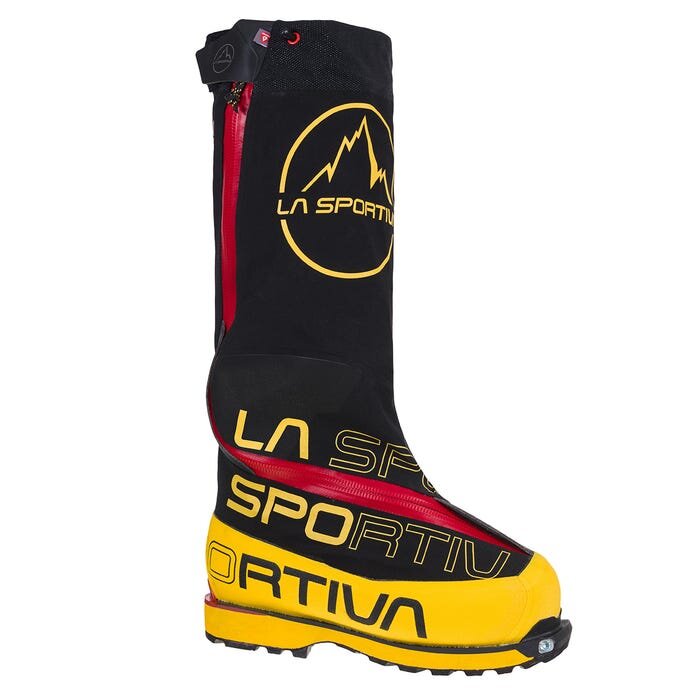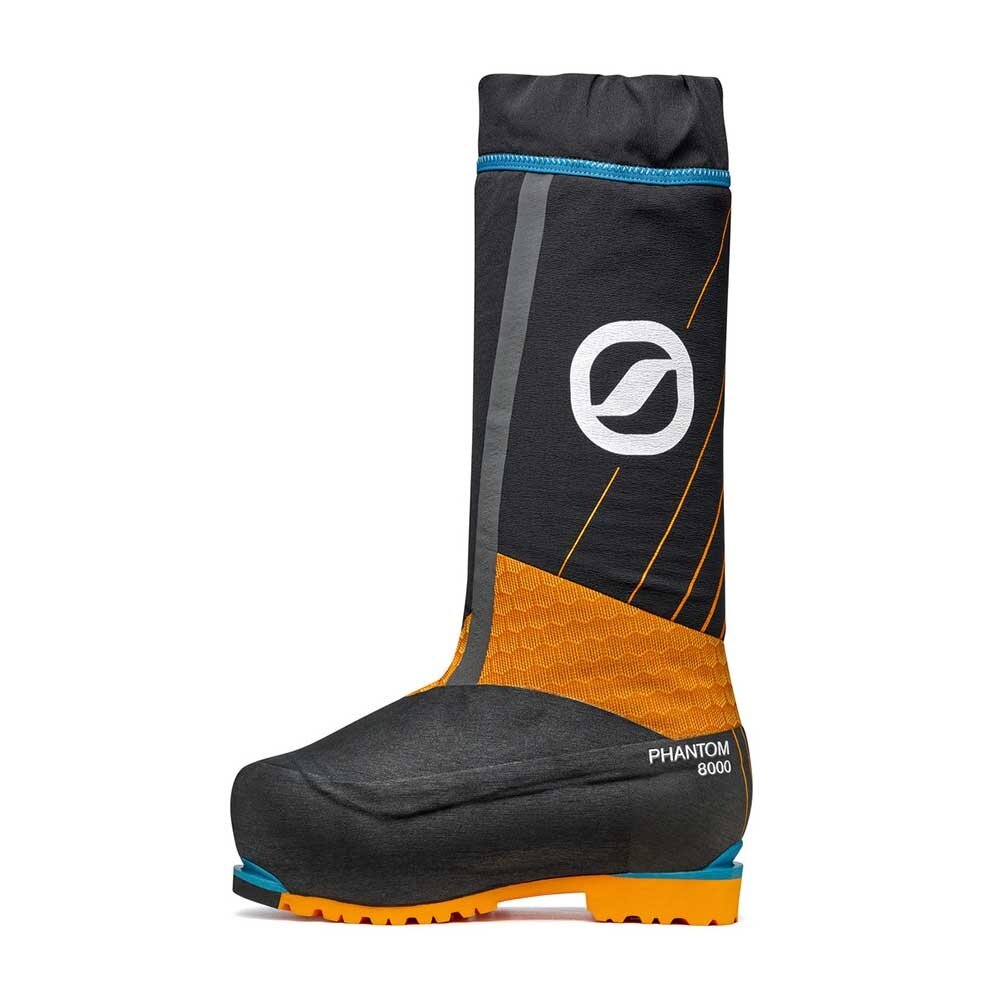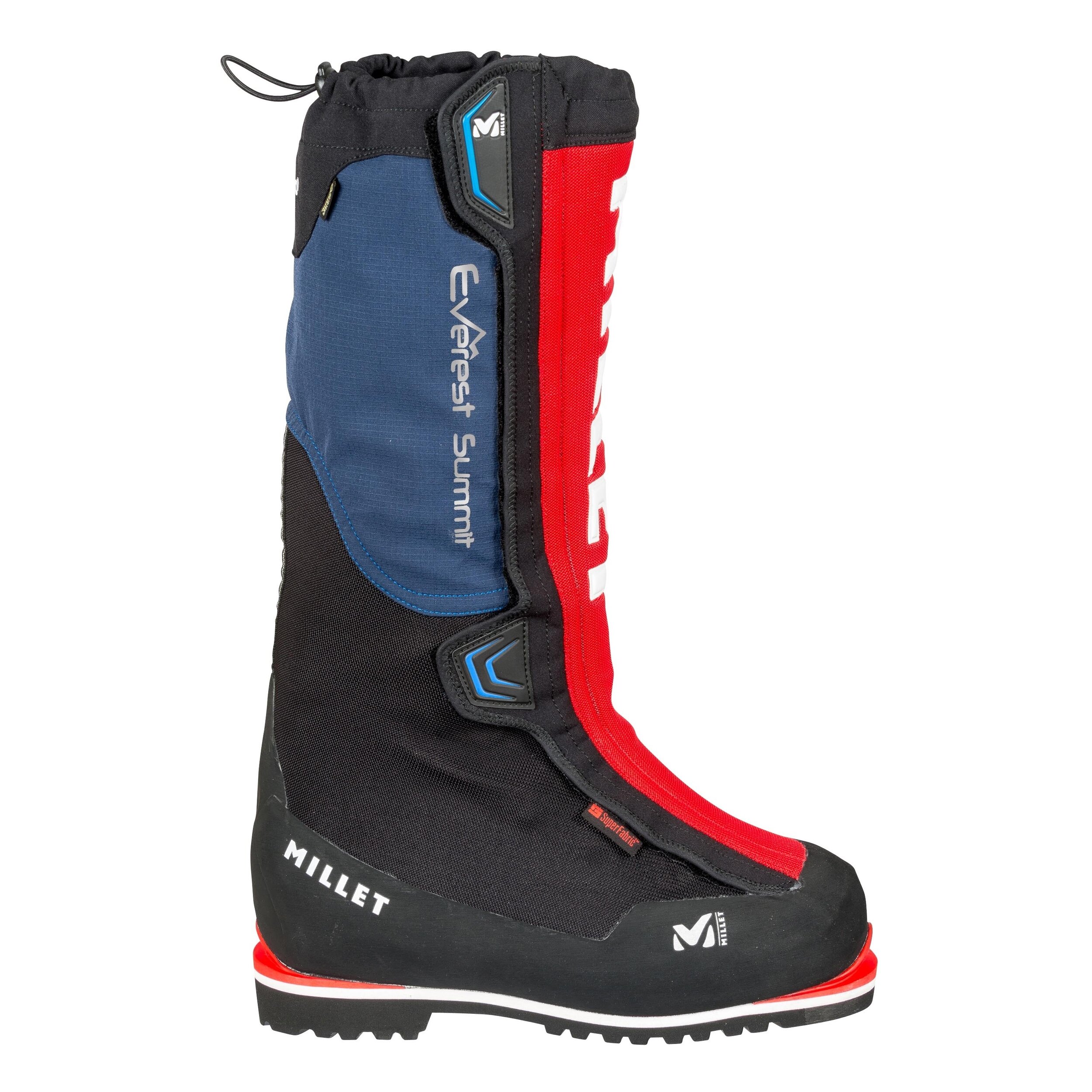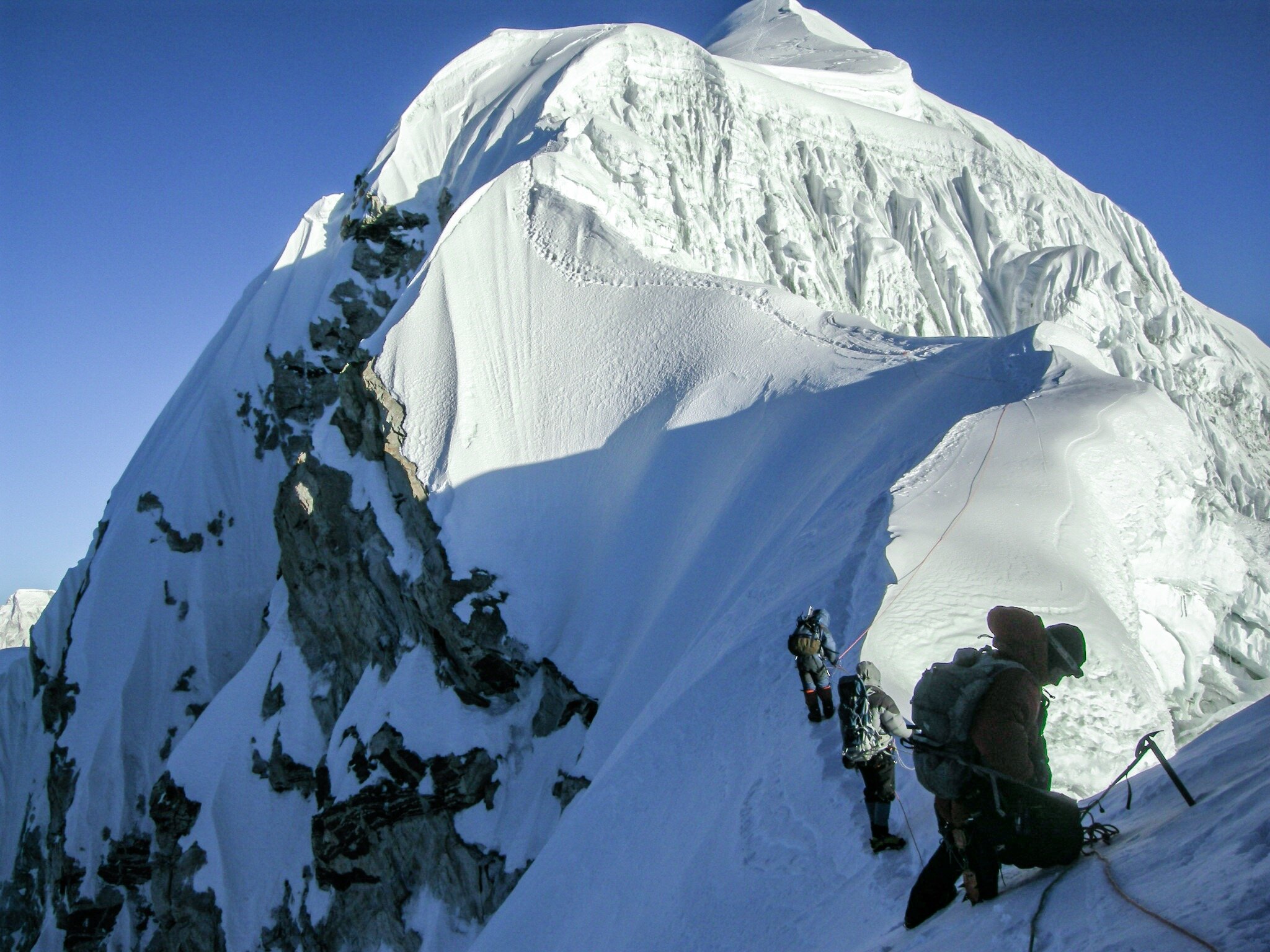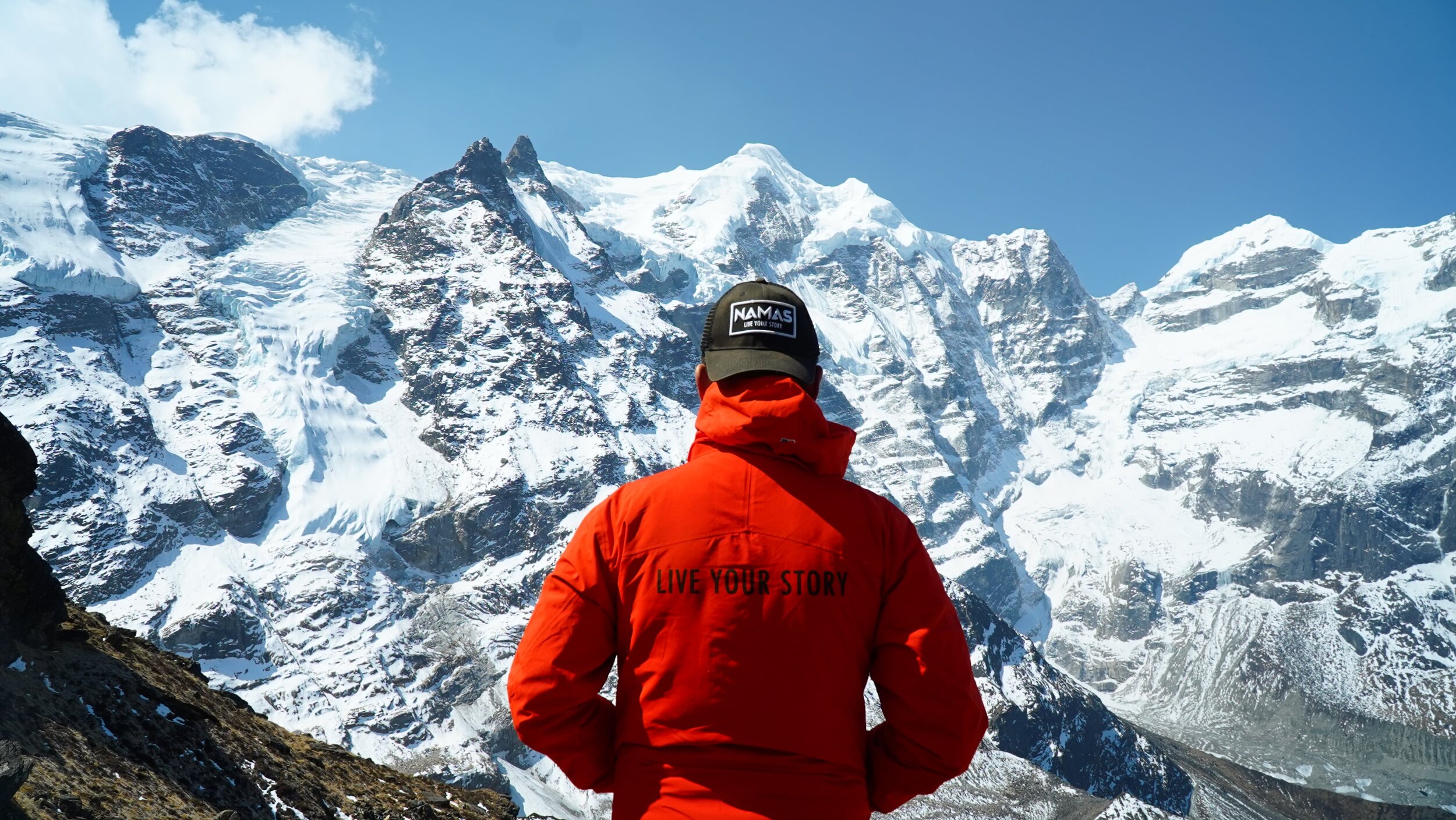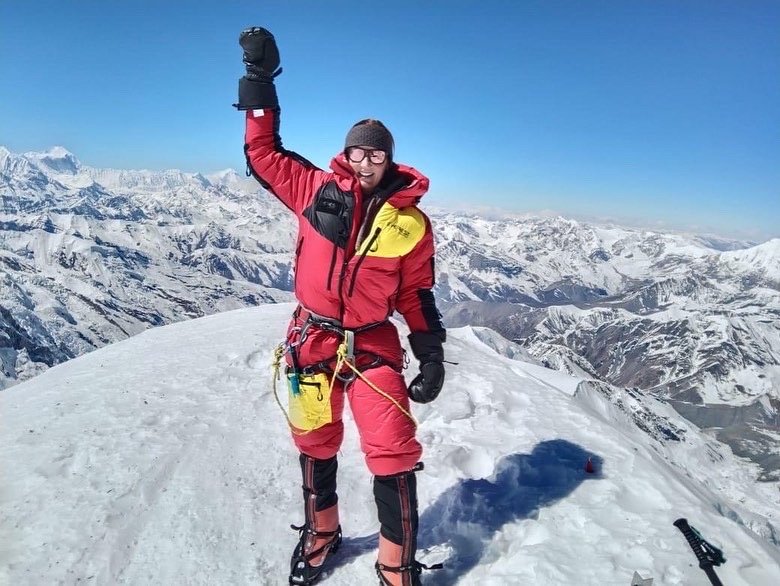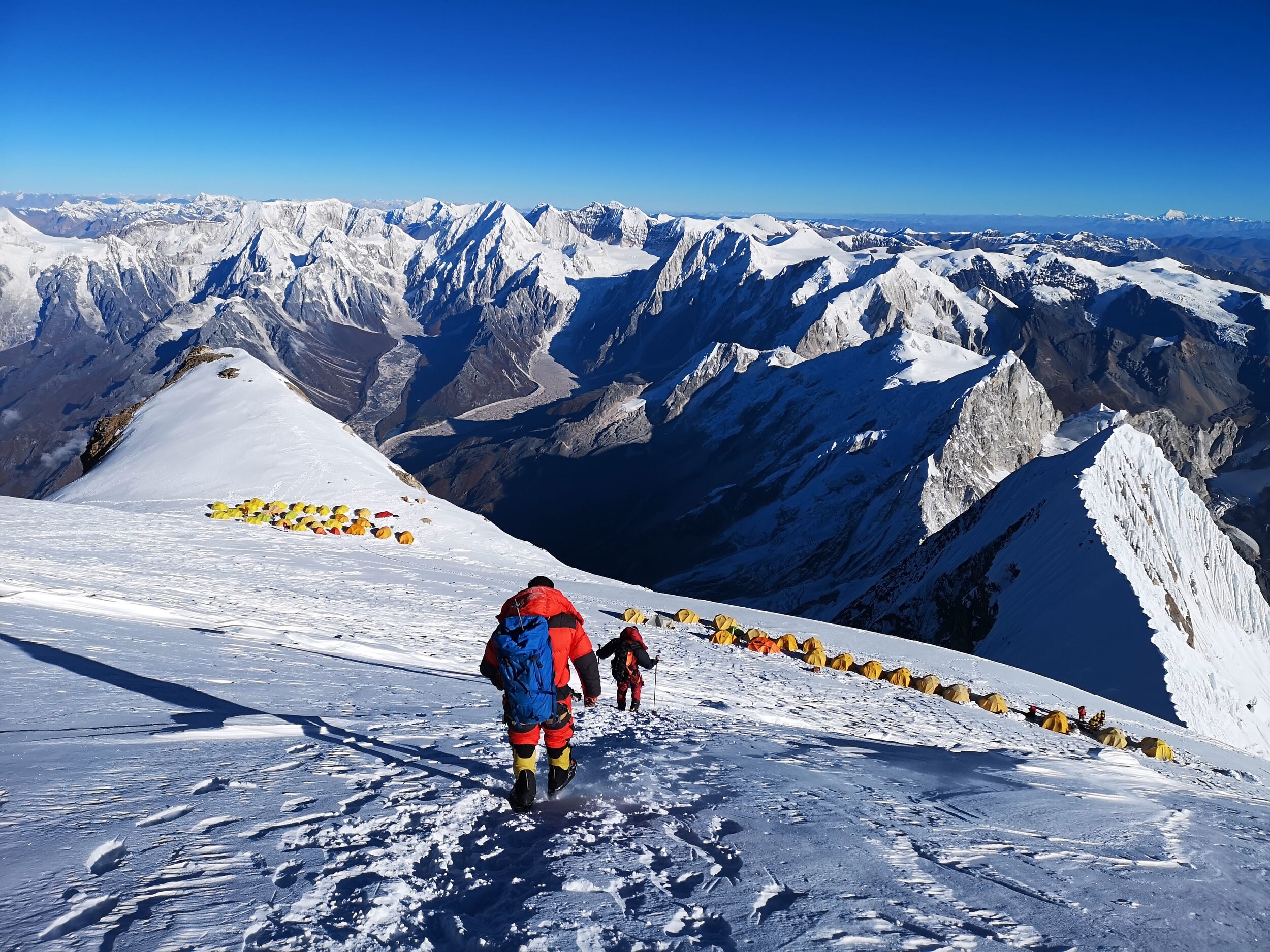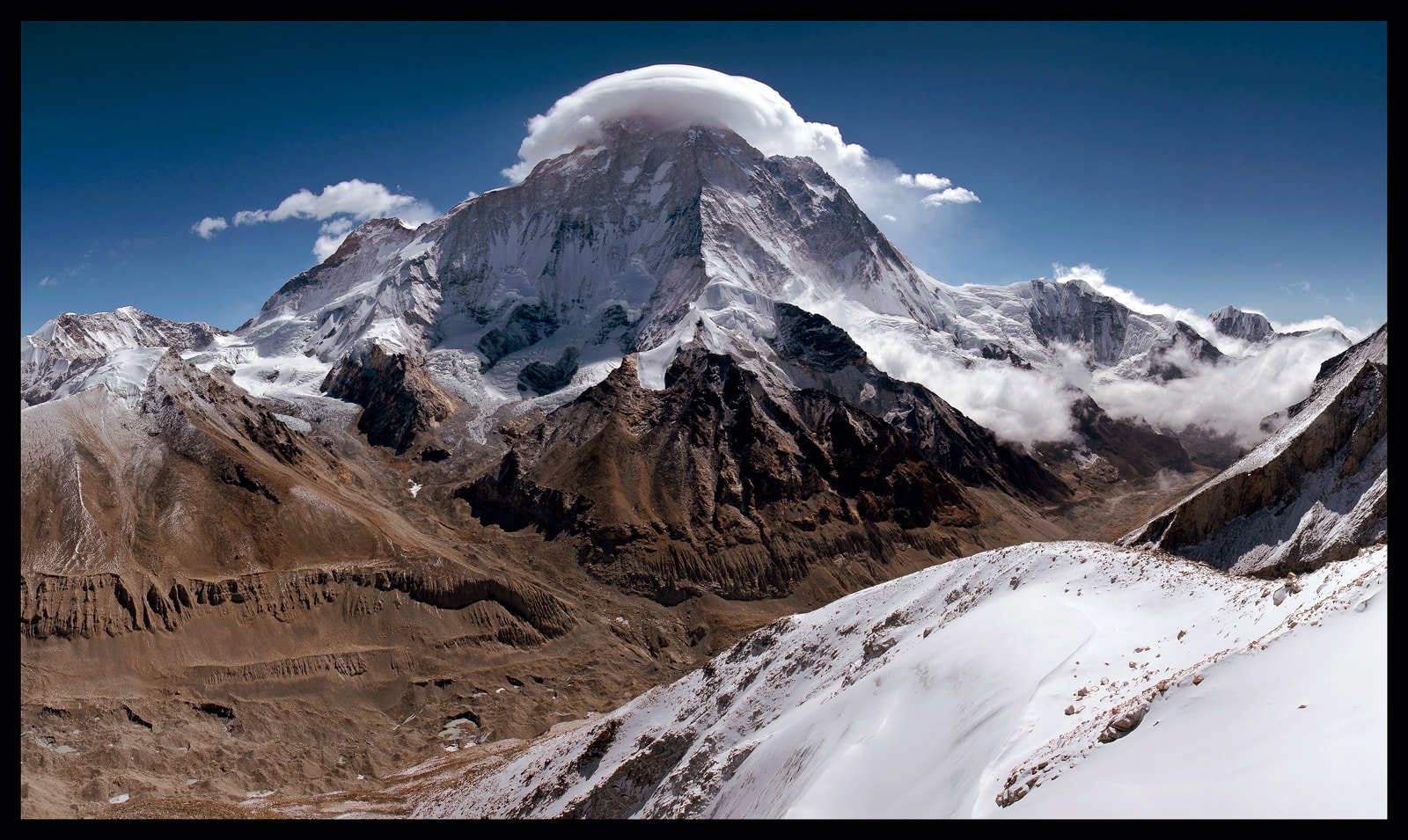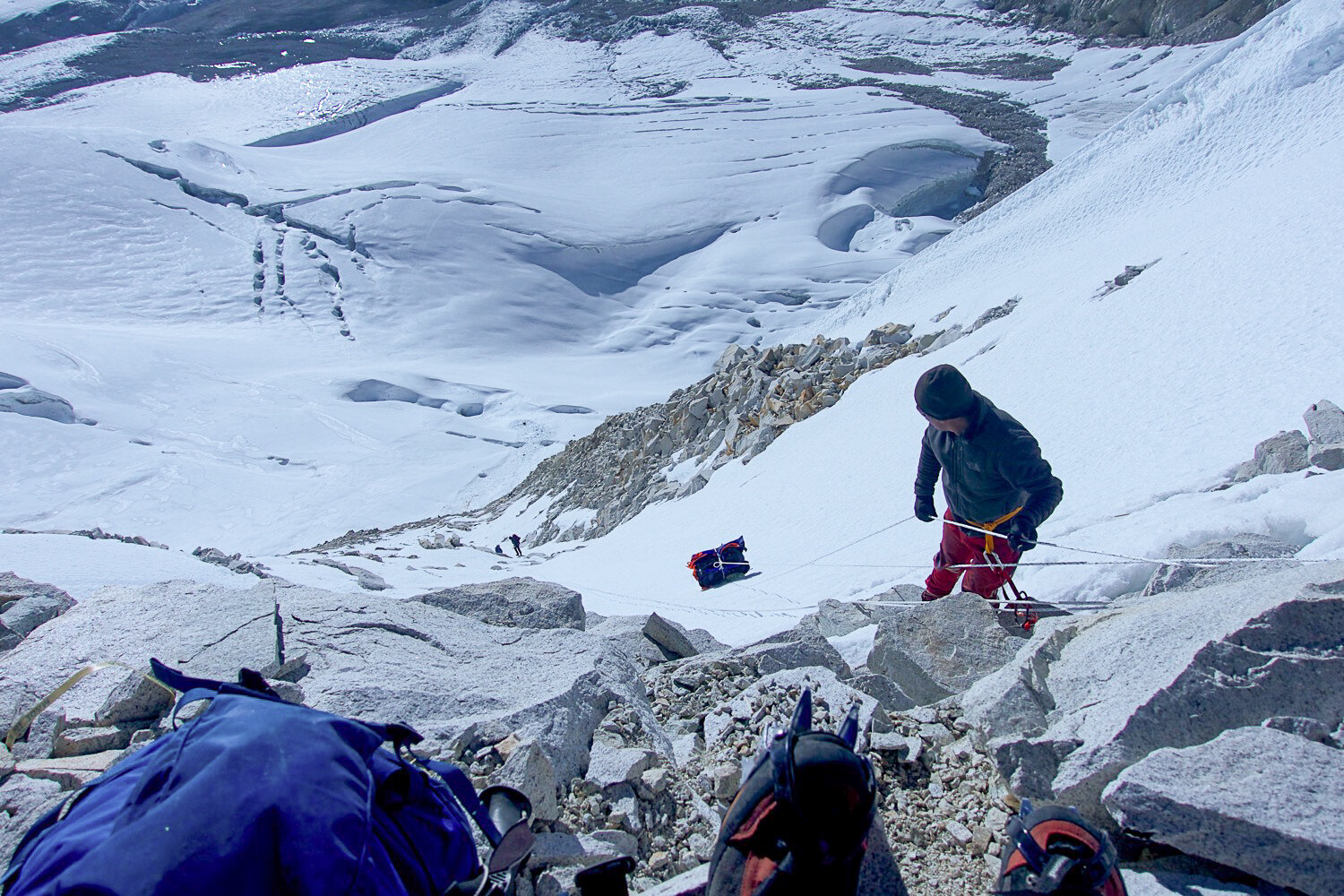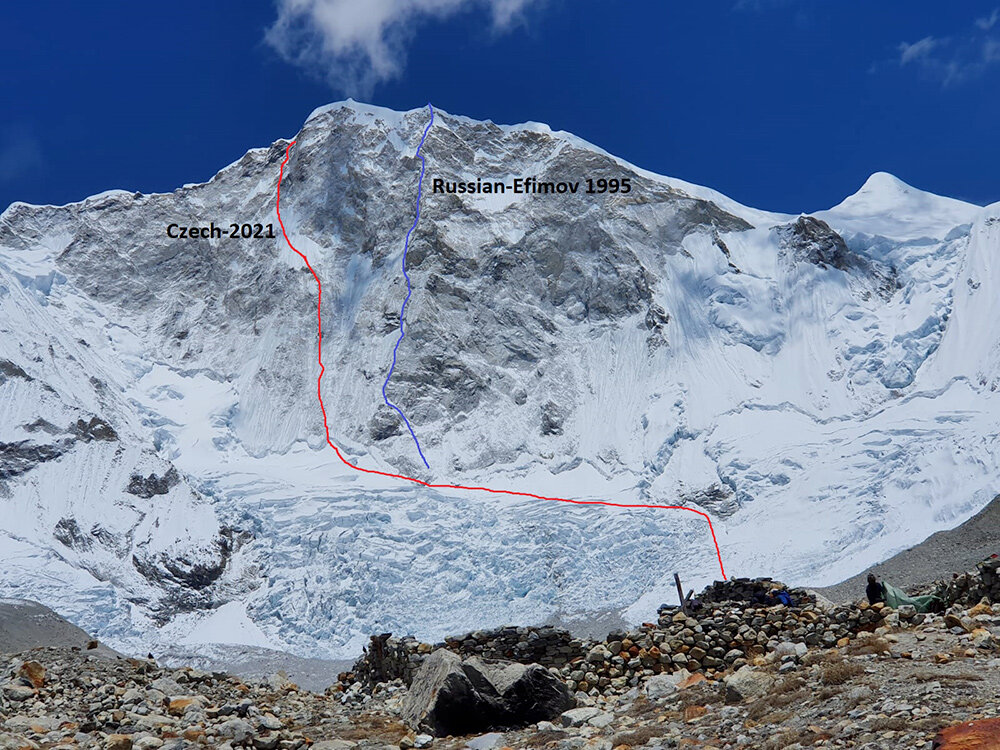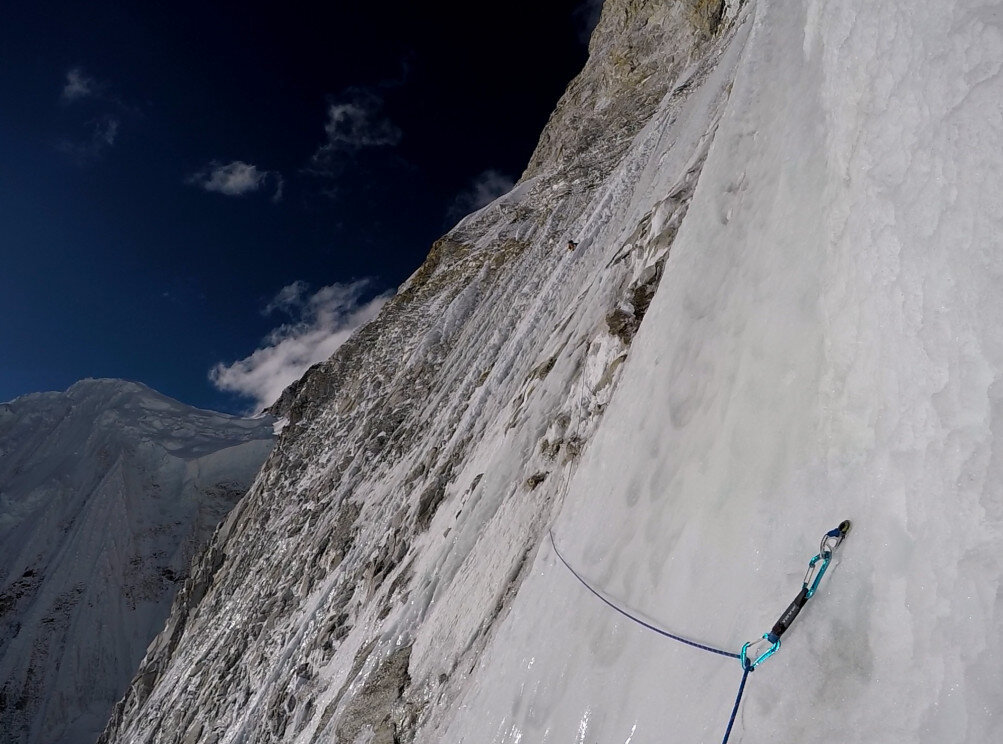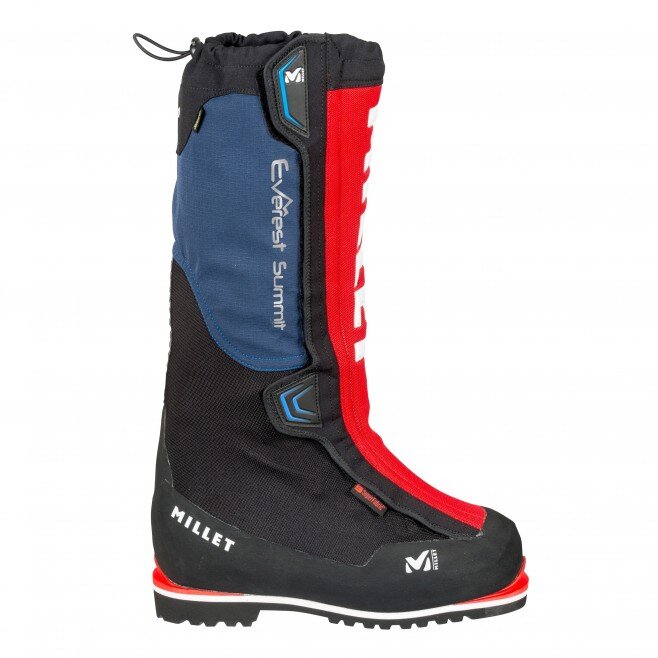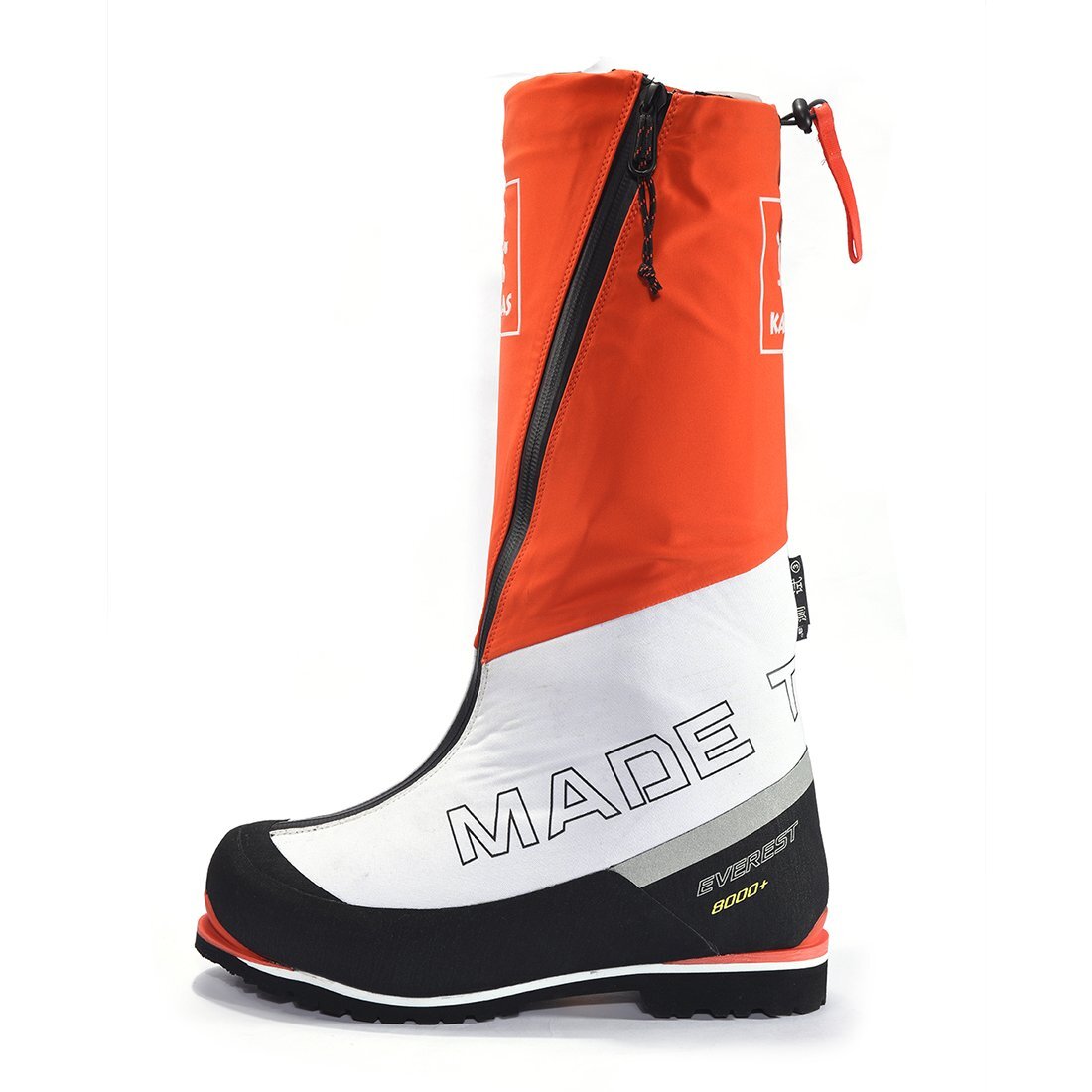Visual Journey of Ama Dablam Expedition - Namas Adventure
VISUAL JOURNEY OF AMA DABLAM EXPEDITION
Ama Dablam's expedition is one of the most thrilling climbs in the Khumbu region. Ama Dablam's view dominates the view during Everest trekking routes. Not only is the climb beautiful and challenging but also physically/mentally demanding. Land in the buzzing historic city of Kathmandu following then to the famous Lukla airport your expedition begins. Your trek follows through the same trail of the iconic Everest base camp trek. The route then splits from the Pangboche village (4529M) to the Ama Dablam base camp 4529M and into the mountain.
Follow along as we describe the entire journey in images, as we take the beautiful yet challenging journey up to the summit of Ama Dablam 6810M.
Lukla Airport
Namche Bazaar
Everest trail and Ama Dablam on the right, Everest/Lhotse on the right background
Trek via the beautiful Gokyo lake 4900M
Dingboche. Island Peak far-left background and Ama Dablam on the right.
Island Peak 6189M. Acclimatization training peak.
Island Peak (Imja-Tse) is one of the most popular 6,000M+ climbing peaks in Nepal. The peak is actually an extension of the ridge coming down off the south end of Lhotse Shar. Imja Tse is a popular mountaineering objective for climbers in Nepal, with its standard climbing route having the difficulty rating of Alpine/fitness PD/2. Our team utilizes Island Peak 6189M or Lobuche East 6119M for training/acclimatization peak before climbing Ama Dablam. The climb in these peaks is an accomplishment on its own and an experience to climb another 6000M peak in the Khumbu region.
Ama Dablam Base Camp 4529M
This will be climbers home for 12-14 days. This will be a full fledge camp with kitchen/dining tent, resting camp where the rest of the crew will be there to support the expeditions.
Ama Dablam Base Camp 4529M
Camp 1 (5800M)
The route to camp 1 is mostly traversing on rocky boulders, a somewhat loose and exposed ridge that is mostly dry during the autumn season and mixed with ice and snow during the spring season. Camp 1, can accommodate about 10 - 12 tents, which are set on the slopes of the rocky boulders and overcrowding can be an issue when all the teams are planning their final summit bid at the same time. The journey from base camp to camp 1 takes about 5 - 6 hours.
Camp 2, 6200M “Yellow Tower”
The duration from camp 1 to camp 2 takes about 4-5 hours. As soon as climbers start off their journey from camp 1 the climb begins through clipping on a fixed-line.
The route is on the steep ridge, exposed on both sides. The routes on the way to camp 2 are stable. After traversing on the boulders and snow the final challenge for the day arrives at the yellow tower. The daunting “Yellow tower” is a straight 80 - 90 degrees vertical wall. Climbing with all the loads can be quite a challenge. So climbers need to be on their game on this part of the climb. Yellow tower climb can be graded at 6a rock climbing grade.
Camp 2 can only house about 7 to 8 tents so during the busy season it is hard to find the ideal spot and when overcrowded other makeshift camps have to be set up on the edges. This camp is not for the faint-hearted climbers but views from camp 2 are just out of this world.
Climbing the Mushroom ridge to Camp 3 (Situational)
The mushroom ridge traverse is one of the most challenging parts of climbing up to camp 3 and when descending down after summit bid. Rock falls can occur if climbers are ahead and climbers will have to traverse through a couloir on thier way to camp 3. This is the final technical section before reaching camp 3 or the summit.
Route to Ama Dablam Camp 3 (6400M)
Camp 3 depends a lot on the condition of snow and ice in the mountain. (Most likely to be set up during spring season than autumn.) The route goes from the back of the tower. Very exposed section and again depending on the season climbers will have to traverse on ice or granite slabs. Rockfalls can occur when there are lots of other climbing teams ahead. Some have even reported rocks the size of a football (soccer). The climb up is 70-80 degrees vertical and upon traversing climbers will reach the uncompromising mushroom ridge.
Lots of new and old fixed ropes can be found on this section. When climbing in the dark make sure to clip onto the right fixed line. Traversing through another super steep couloir on the ridge and steadily heading up climbers will arrive at camp 3 area. By this point, you will already have climbed for 5 hours. Nowadays, most teams do not stop at camp 3 and head straight to the summit. Arriving just beneath the pyramid the summit lies above the Dablam slopes.
Summit 6810M
Summit of Ama Dablam is a broad plateau. An amazing feat to undertake and the achievement of a lifetime. On a clear day Mt. Everest, Lhotse Shar, Baruntse, Makalu, Cholatse, Taboche, and surrounding Himalayan peaks are visible.
AMA DABLAM EXPEDITION
Are you planning the Ama Dablam expedition as your next big mountaineering adventure? We have departures every year (spring/autumn). For more information on our Ama Dablam expedition or any of our other international expeditions check out our website. (Call/WhatsApp) - +44 7446976060 or send us an email at bookings@namasadventure.com
Mount Everest expedition. New route, Nepal South side - Namas Adventure
Legendary French mountaineer, Marc Batard and his team of Nepalese and french climbers have discovered a new route for Everest Expedition. Batard wants to further observe and test this route on his 2022 Spring Everest Expedition (without supplement O2) to see if it is commercially feasible. This alternative new route avoids the most dangerous part of the Nepal side Everest expedition, climbing the Great Khumbu Icefall.
This new route can be started from the village of Gorakshep which is at 5100M and the climbing route falls beneath the Nuptse ridge. The climb starts at an adjacent peak that was unnamed. Batard wanted to pay his homage to his former Sherpa team (Sundari Sherpa), named the peak Sundari Peak 5880M and the route Sundari route. Sundari Sherpa was part of his Everest expedition (1988) member who inspired him to climb Everest and break the speed record of the first ascent in less than 24hrs.
The route then leads to Camp 1 at 6065M, which is above Khumbu Icefall. Batard came up with this new route to find a safer alternative. Avoid the dangers of Khumbu Icefall which is nerve-racking even for experienced climbers. Batard team has fixed new 700M routes with 1000M ropes and 10mm screw blots. The idea is to have via-Ferrata with fixed metal railings, so that Sherpas with a heavy load can use it making it much-much safer compared to the dangerous Khumbu icefall. The team is aiming to fix the remaining 400M to Camp 2 (6400M).
What are your thoughts on this new proposed route which seems much safer, not just for the clients but to Sherpa members too? Please comment below.
We think this is a great alternative and this could even open a possibility for the Autumn Everest expedition. Historically Autumn season is avoided by expedition companies to avoid the dangers of avalanches that come falling from the hanging serac above the icefall.
Even if the Autumn season is not possible, this will give Sherpa’s working in Everest/Lhotse expedition an extra layer of safety when working in the mountains. We wish Batard and his team very best wishes and a safe summit during their 2022 (without supplement O2) expeditions.
God's speed and success. Live Your Story.
Namas Adventure team
How to prepare for Ama Dablam climbing expedition? Step by step recommendations- Namas Adventure
We get this particular question asked a lot. Climbing the famous and exquisitely beautiful Ama Dablam peak has been or will be a dream for many aspiring mountaineers. This prominent and beautiful peak full-fills the thrill of climbing a mountain that combines technical challenges, not at an extremely high altitude but 200M shy below to 7000M level but is not your average peak expedition. Lots of steep climbing, in rock/ice/snow and exposed sections. This climb is definitely a must climb for mountain climbers. How can one go on about climbing this beautiful giant peak in the Himalayas?
In this blog article, we will just share all the prerequisite experiences required. Whether you are a novice climber who happens to see Ama Dablam when trekking the iconic Everest region or in images or you are beginner climbers who want to aim higher technical peaks. If you are an intermediate or pro/advanced level climber, who is just looking for a great mountaineering adventure ideas. We will recommend the necessary prior expeditions to be able to successfully take on this amazing expedition.
Amadablam 6810M climb is not for novice, beginner, or intermediate experience level climbers. You will need to have a good solid experience of previous several 4000M, 6000M, 7000M or even 8000M peak climbing experiences. If you consider your alpine climbing level at advanced or pro level, who have climbed mostly below 4000M then, substantial experience of alpine style and technical climbing experiences are a must. Now you know this is not an easy mountain to climb let’s start with our step-by-step expedition recommendations.
Step 1 (Novice level to Beginner Level)
If you are an absolute beginner who has never been to any previous high altitude adventures trekking or climbing and somehow you are inspired and dream of climbing Ama Dablam one day, then we can suggest these peaks, to begin with. With our team in Nepal, you can participate in our introductory expeditions to Yala Peak 5032M, Mera Peak 6476M, or Mountaineering course - Level 1 to begin your mountaineering journey. This expedition’s objective will be to test/expose yourself to any high-altitude trekking or non-technical peak climbing adventure in Nepal or around the world. You will have to be in a good shape but these introductory peak expeditions will help you learn the basics and fundamentals, giving you that confidence to climb other higher and semi-technical peaks.
Expedition Outcomes
Introduction and learn the basics of mountaineering
High altitude experiences
Fun times in the mountains
Step 1. 1 (Beginner to intermediate level) Lobuche East & Island Peak
At this level, you should have been exposed to climbing in mountains. You understand the fitness/mental level required during mountain expeditions. At the beginner to intermediate level, you will further learn climbing at high altitude with some technical pitch sections. Meaning you will be re-introduced to all the previous basic climbing skills adding further technical climbs. You will learn to navigate mixed rocky/snow/ice sections. Scrambling/traversing on exposed sections and jumaring on the fixed-line rope to take on vertical sections of the mountains.
These skills are very necessary as you progress on your mountaineering journey and expeditions of this type will give you that extra confidence to take on other tougher and technically challenging peaks in the Himalayas or around the world. We recommend peaks such as Island Peak 6189M + Lobuche East 6019M, Khumbu Three Peak Expedition, Chulu West 6419M, Three Peak Peru, expeditions for climbers at this stage. This expedition provides all the technical and physical challenges for climbers looking to progress at the Intermediate/+ level.
Expedition Outcomes
Introduction or Re-introduction to classic mountaineering climbs
Familiratisation with technical climbing gears
Climbing/scrambling/traversing in mixed section. (i.e- rock/ice/snow)
Experience climbing on exposed section. (i.e. Ridge and couliors)
Jumaring in fixed-line to climb vertical sections.
Abseiling/Rappel several hundred feet down on fixed-line
Summits and small-scale expedition environment, tons of climbing fun
Step 2 (Intermediate to Intermediate + level)
At this level, you are now 1 step closer to the Ama Dablam expedition. Although it is tempting to climb Ama Dablam after your one or two 6000M+ semi-technical expeditions, we advise climbers not to rush into climbing Ama Dablam. Ama Dablam's climbing should not be underestimated. The climbing routes on Ama Dablam are super exposed, which requires an extended period on the fixed-line rope, climbing on a vertical-exposed ridge section, and lots of abseiling down. You will have to be mentally/physically ready and your confidence/experience is super key.
So any climbing expedition at 7000M+ level can be strategically fitted into your climbing plans to finally take on Ama Dablam. We highly recommend Baruntse 7129M, Himlung Himal 7126M Expedition, Tilicho Peak 7139M Expedition, Khan Tengri 7001M etc. These long days expeditions are semi-technical to technical climbs in nature with long and proper exposure to full expedition setup. Expedition of this nature will test you fully where all your previous knowledge of climbing/scrambling/traversing in the exposed mixed section will be put into test. There will be additional higher alpine camps and longer days at higher altitudes. You are constantly exposed to the forces of nature and mentally/physically you are challenged for an extended period of time compared to your previous expeditions. These expeditions will be longer, more demanding, tougher, and technically, physically, and mentally challenging. You will also learn about climbing in the team, how to co-operate as a team, assisting the weak links and how a grouped expedition runs, allowing everyone to achieve the same goal of summiting a 7000M peak as well as developing their skills and experiences further, to take on much more technically demanding and together peaks.
Expedition outcomes
Developing climbing skills at 7000M level.
Understanding of full expedition setups
Climbing/scrambling/traversing in mixed section. (i.e- rock/ice/snow) at higher altitudes above 6000M.
Longer exposure to climbing on exposed sections. (i.e. Ridge and steep couloirs)
Jumaring in fixed-line to climb vertical sections.
Abseiling/Rappel in longer and exposed ridge sections.
Testing your physical and mental ability and pure grit at extreme altitudes.
Summits and climbing moments at 7000M level
Step 3 To Ama Dablam 6810M
Finally, you should be ready for Ama Dablam climbing expedition. Our only advice would be not to make the long gap between your last major expedition and Ama Dablam expedition. Try to do Ama Dablam within a year after you have accomplished your Step 2 expedition. Or if you are climbing technically challenging peaks around the world then the advice will be otherwise. In this way, your mind and body are still well attuned to climbing and taking on the tolls of climbing challenging mountains.
With all the experiences you have gained from your last 2+ expeditions you should be now ready with your technical ability, physically and mentally. Of course, as a mountain climber, you are training once you are back home and rested.
Amadablam is a climber’s mountain. Additionally to your minimum experiences which we have recommended above, you will need to be very proficient with the set of skills mentioned below and you will need exceptional physical fit. Clients are responsible to carry their own back pack (5-10kgs) once they leave base camp. Sherpa guide expedition leader will guide and motivate you throughout but a lot of the effort lies within you and your ability to climb. Must have skill sets -
Rock climbing indoors and outdoors - (i) learn the basics of wearing harness and helmets (ii) tying figure 8 knot and stopper knot (iii) basics of using the belaying device correctly (iv) Use ascending and descending devices (iv) basics of using ropes, start/end when climbing (v) learning knowledge of moving while using the gears and being checking the safety features simultaneously.
Regularly rock climbing up to 5.10 a,b,c +. The more experience you have in rock climbing, taking on tougher routes in different types of rock, the better it is for you to get familiar with the climbing style and adjust during the expeditions.
Abseiling. This is the simplest yet, one of the most important skills to master. Some multi-pitch abseiling knowledge/experience is also required. Be prepared to descend down for a long duration from the summit to camp 2 or 1.
Climbing on different terrains. Slab rocks, vertical rocks. Scrambling on steep terrains.
Use of Crampons and Ice axe. Winter ice climbing or mountaineering courses are recommended. If you are particularly keen on climbing during the spring season, ice climbing skills up to WI-3 or WI-4 are required. During the autumn season climb, it is less likely you will be needing ice climbing skills. You should be able to kick step and balance with an ice axe on icy slopes to ascend on the vertical climbs. Ice arrest skills to save yourself in case of slips or falls, being comfortable while descending and abseiling with crampons in all types of terrains.
Understanding how your body adjusts when climbing in Altitude. We will be climbing Island peak as a training/acclimatising peak. Your prior experience in climbing should give you a good understanding of how your body copes at high altitudes. You are responsible to build your fitness up to the best level. Our itineraries are designed to be able to help you with proper acclimatisation. Equally important clients have to be aware of their eating patterns and stay hydrated.
Expedition outcomes
Further developing technical climbing skills at 6200M to 6800M level. Ready to take on higher or technical peaks.
Understanding of full expedition setups
Climbing/scrambling/traversing in mixed section. (i.e- rock/ice/snow) at higher altitudes above 6000M.
Longer exposure to climbing on exposed sections. (i.e. Ridge and steep couloirs)
Jumaring in fixed-line to climb vertical sections.
Abseiling/Rappel in longer and exposed ridge sections.
Testing your physical and mental ability and pure grit at extreme altitudes.
Summits, uncountable memories, and further confidence to take on higher technical peaks.
Bonus - Step 2. 1 even 8000ers or Pro level climbers (Grades TD+)
This is a bonus step. Many experienced climbers are attracted to the beauty of Ama Dablam. Even after completing 8000er peaks like Everest, Manaslu, Makalu, K2 climbers return to enjoy the climb at Ama Dablam. So if you have done 8000M peaks then you are qualified for Ama Dablam expedition. You will already have an understanding of big mountain expeditions and what it takes to climb challenging mountains.
Similarly, if you consider yourself a pro-level climber who can take on vertical 300M - 400M ice walls at higher altitudes then you are already set for Ama Dablam. Probably trying other challenging routes is more for climbers at this level. Why not try new projects and exciting feats in Ama Dablam. This peak has other 10 challenging routes so climbing those routes with your trusted partners is the one to explore. If you similarly want to join our yearly expeditions then please do inquire and join our team during Spring, when there are fewer climbers or during the late autumn then our team can organize an expedition for your group.
Are you planning to climb Ama Dablam Expedition? What is your experience level? Please go through our Alpine /fitness grades (link) to understand the difficulty and climbing grades of Ama Dablam and other peaks. We hope the guidance and suggestion on this blog post have helped you to have an understanding of what it takes to climb Ama Dablam. There are a lot of other factors when climbing any extremely high altitude technical peaks in the Himalayas. Our team can help you prepare in the best way gaining the right experience to complete your dream of climbing Ama Dablam 6810M peak.
Go challenge greater things. Commit and finally take on that dream adventures you have always been planning. Life is too short to live with regrets. See you in the mountains. 🙂🏔🙏🏼
Namas Adventure Team
Live Your Story
Baruntse 7129M expedition, 2021 Mountain status updates - Namas Adventure
2021 wasn’t the year to be for any teams to successfully complete Baruntse Expedition. We had small team expeditions both during Spring and Autumn this year (2021).
Spring was a big risk with uncertainty around COVID 19. Still, we managed to get a small team of 3 members and after summiting Mera Peak, our team had settled at Baruntse Base camp 5460M and was preparing for our climb to camp 1. Soon enough our team and other teams, who have been together with us since Mera Peak learned that the person we came in contact with (a day before Mera peak climb) was evacuated to Kathmandu and tested positive for COVID. After learning this most of the teams decided to call off their expedition, since all the guide members and had been in contact with the sick person’s guiding team members, and any illness and evacuations at 6100M+ or around camp 1 and beyond would have been devastating.
Autumn, our team arrived up to camp 2 at 6400M but could not proceed further as we had a very unexpected storm and heavy snowfall (4ft - 5ft deep) for 4-5 days, our guides could not go past camp two and resorted back to base camp to wait for a clear window. After waiting out for 4 days our team went back to camp 1. Windspeeds were picking up to 60 - 70mph and a high risk of avalanche in the mountain was to follow up soon in the after 2 days. Our lead guide decided to call off the expedition since the client member did not want to add any additional days (5 - 7 days) to the expedition.
The only group or two people to summit Baruntse on (2021) spring was Marek Holecek and his climbing partner Radoslav Groh. They completed a new notorious route, climbing alpine style on the west face naming it “the heavenly trap” read more about their expedition on our blog post below ⬇️
We had previous (2019) reports that there is a huge crevasse opening when leading up to the summit but no one had a concrete certain report from 2020. Since Marek and Radoslav were the only two people to summit Baruntse in 2021 and returned via the southwest (normal expedition route) we approached him asking about any potential dangers and hazards in the mountains. Marek replied back to us with the following email. (Thank you very much Marek 🙏🏼).
Hi,
At about 6500 m there is a large transverse crack over the ridge, which at the time we were there went to overcome, but we had really a lot of snow there. The crack runs across the entire ridge. Now I don't know what it looks like. The second crack was around 6000 m, above the saddle we had to rope down. The crack at 6500 m was very dangerous.
Cheers Marek
_________________
Our expedition team could spot the hole/crack at 6000M.
We will be organizing expeditions to Baruntse during 2022 and 2023 and it is great to learn about these potential dangers and hazards beforehand. Our guiding team can expect these hazards at 6500M and prepare an additional safety line around this particular ridge section. Any teams heading to Baruntse during 2022 or 2023 can use this information for their expedition too, after all, teamwork is key during the expeditions and we would like everyone to be safe in the mountains.
Want to plan your expeditions to Baruntse Peak 7129M or other high-altitude mountaineering expeditions in the Himalayas? Please inquire about your preferred expedition to our teams as we have several 6000M, 7000M, and 8000M expeditions running in the Himalayas every year.
See you in the mountains.
Live Your Story
Manaslu Summit 8163M. True Summit. The debate ends here - Namas Adventure
For years if not decades climbers have been debating about reaching the true summit(4) of Manaslu and where it actually is. Finally this year the drone shot captured by Jackson Groves during his Manaslu expedition made it clear as daylight to the world. His images clear the argument once and for all. Jackson himself mentions in his blog (Journeyera) that he stopped short at the fore summit and did not proceed to the main summit.
Mingma G seen climbing to the main summit. Majority of climbers previously stopped at the fore summit, claiming Manaslu 8163M Summit.
Mingma G, who set up the fix-rope at the pinnacle snow point of the summit (true summit) along with the Himalayan database claimed that this was only achieved only after 45 years (1976). Others argue otherwise but now we can understand why reaching the true summit which is 20m-25m away from the fore summit (Shelf 2) is such a dangerous challenge to overcome at 8100M+ level.
The last section is very technical and exposed which has to be climbed down a few feet, traversed through steep, snow, and rocky slopes with more than a hundred-meter drop, and is clearly not for any inexperienced climbers.
Manaslu 8163M expedition is considered an introductory 8000M+ expedition to see how non-seasoned climbers handle themselves climbing at the death zone but the last section from the fore summit to the true summit is not for the inexperienced climbers. For one the climb is a very dangerous and technical climb this final section which won’t be able to handle any sort of traffic jams and any form of rescue in between is near to impossible. Only very experienced seasoned climbers who want to stamp their name on the elitist group whose aim to hold records or gather as many summits are advised or if you have several previous climbing experiences (not just 2 or 3) then going up to the real summit is advised. Also, bearing in mind now that the true summit is clear to many, most climbers will be attempting the pinnacle point hence traffic might become an issue in such a small section.
Prior to this year (Autumn 2021), Manaslu 8163M summit has been claimed by many but it turns out only a handful of climbers had been to the main summit. The Tolerance zone concept proposed by Stefan Nestler is particularly interesting. His concept suggests two types of summiteers -
The general summit group: Many who have claimed to be at the summit have gone back home believing that they have been to the true summit. This will definitely come as an annoyance to many but the majority of the climbers who do not care about being in the absolute elite list won’t be back to climb Manaslu just to climb the few last meters.
The elitist summit group: Are the absolutes who make no compromises even to the last stone or snow point at the very top to claim the true summit. These climbers will have to come back to update their summit records.
Moving forward climbers who want to climb Manaslu as an introductory 8000M expedition will have to think really hard and make a sensible decision before venturing further away from the fore summit to the true summit. For the ones who want to be on the elite table list, the debate has ended and the true summit is clear. Operators too will have to be clear about the true summit and fore summit plans.
So, as the debate ends, are you planning to climb Manaslu 8163M in near future? Namas Adventure/Expedition team will be planning our expedition strategy to the true summit. However, to the non-seasoned climbers, the option of climbing the fore summit is still possible with our team.
See you in the mountains.
Go. Live Your Story.
Ama Dablam Expedition : A Climbers’ Guide - Namas Adventure
Mountain Overview
Elevation: 6810M / 23389FT
Co-ordinates: 27.8619° N, 86.8612° E
Location: Khumbu Region
Parent Mountain: None
Summits: 1 Main summit
Country: Nepal
About the Mountain
Ama Dablam is well renowned as one of the most beautiful and exposed Himalayan mountains in the Everest region. It is one of the most sought mountains to climb by mountaineering enthusiasts. Ama Dablam is the 3rd highest permit to be issued by NMA. Whether you plan to do it before or after your bigger expedition like Everest, Ama Dablam climb in itself is a mountaineering challenge on its own. Ama Dablam is referred to as the mountaineer’s mountain and is considered "a must-do" for alpinists and mountaineers. Ama Dablam is also referred to as the Matterhorn of Nepal.
History
Ama Dablam was first summited on 13th March 1961, a Silver hut scientific expedition led by Sir Edmund Hillary. Mike Gill (NZ), Barry Bishop (US), Mike Ward (UK), and Wally Romanes (NZ),
How to get here?
There is one main trekking route to get to Ama Dablam base camp.
Via Lukla - Namche Bazzar - Pangboche - Ama Dablam Base Camp (Hiking)
Ama Dablam Routes
Southwest Ridge (Commercial expedition route)
1979 Lowe Route on the South Face (VI AI4 M5 1200m)
1979 North Ridge (VI 5.7 70deg 1600m)
1981 Northeast Spur to North Ridge (VI 5.7 70deg 1500m)
1983 East Ridge (VI 80deg 1500m)
1984 Southwest Ridge
1985 West face (VI 5.7 65deg 1400m)
1985 Northeast Face (VI mixed 90deg 1400m)
1996 Northwest face (VI 5.7 AI5 A2+ 1650m)
1996 North Ridge
2001 Northwest Ridge
Note - Climbers planning to climb this Ama Dablam without guide support or solo projects are advised to take other routes than (Southwest ridge) because it conflicts with the commercial expedition.
Permits
Required. Permit costs $400 (Spring and Autumn) and $200, Winter. Liaison officer charges apply.
When to climb Ama Dablam?
Spring season (April - May) if you prefer to see fewer climbing teams in the mountains.
Autumn (Mid October - November) is more famous and expect to see many teams and traffic during this season.
Winter ( Mid December - Mid February)
Ama Dablam Base Camp 4529M
A few hours away from Pangboche, the Ama Dablam base camp sits at 4529M. This will be the home for many climbers for their entire climbing duration. The base camp is set up on grassy lands just beneath the mountain. A cell tower has been set up close to the Ama Dablam base camp, providing climbers with inconsistent internet access, but still decent service. An old yak hut has been transformed into a tea house, which is a short distance from the base camp. Independent climbers can use this as their permanent base camp or store their gear.
Camp 1, 5800M
It takes about 5-6 hours to reach Camp 1 from the base camp of Ama Dablam. Along the way, climbers will come across Yak Camp, which can also serve as an advanced base camp. However, the availability of water at this campsite is limited, so many teams do not use it or only use it for acclimatization rotations. The route to Camp 1 involves traversing rocky boulders and an exposed, somewhat loose ridge, which is typically dry during the autumn season. Camp 1 can accommodate 10-12 tents, which are set on the slopes of rocky boulders. Overcrowding can be an issue when all teams are planning their final summit bids at the same time.
Camp 2, 6100M (Yellow Tower)
The journey from Camp 1 to Camp 2 can take about 4 to 6 hours. After leaving Camp 1, climbers will have to clip onto the fixed ropes to make their way to the next camp. The route follows a steep ridge, exposed on both sides, with stable routes on the way to Camp 2. As climbers traverse the boulders and snow, they will face the final challenge of the day: the daunting "Yellow Tower," a vertical wall at an 80 to 90-degree angle. Climbing with all the necessary gear can be quite a challenge, so it is important for climbers to be prepared for this part of the ascent. The Yellow Tower climb can be graded at a 5.10 rock climbing level.
During the busy season, finding a spot in Camp 2 can be difficult as it only accommodates 7 to 8 tents. If the camp becomes overcrowded, additional makeshift camps may need to be set up on the edges. While this camp may not be suitable for those who are easily intimidated, it offers breathtaking views.
Camp 3 or 2.9,
Climbing towards camp 3, Ama Dablam
Camp 3 depends a lot on the condition of the snow and ice in the mountain. (It is most likely to be set up during the spring season rather than autumn.) The route goes from the back of the tower and is a very exposed section. Depending on the season, climbers will have to traverse on ice or granite slabs. Rockfalls can occur when there are many other climbing teams ahead. Some climbers have even reported rocks the size of a soccer ball. The climb up is 70-80 degrees vertical, and upon traversing, climbers will reach the uncompromising mushroom ridge.
As you navigate this section of the climb, you will encounter many new and old fixed ropes. It is important to pay attention and make sure you are clipping onto the correct rope, especially when climbing in the dark. After traversing a steep couloir and steadily making your way up the ridge, you will reach the area for Camp 3. After approximately 5 hours of climbing, many teams choose to skip this camp and continue directly to the summit. When you reach the base of the pyramid, the summit will be located above the Dablam slopes.
Camp 3, Ama Dablam. Photo by - Irina Galay
Ama Dablam Summit 6810M
Climbing further up on 55-65 degree slopes will lead to the final stretch before reaching the summit. Expect to climb for more than 10+ hours if you are planning to ascend directly from camp 2. The summit of Ama Dablam is a wide and broad plateau. On a clear day Mt. Everest, Makalu 8463M, and Baruntse 7129M ranges are clearly seen.
Prayer flags at Ama Dablam summit 6810M
Your climb is half done at this point. Abseiling down to camp 3 is straightforward, although some climbers wrap the ropes around their arms and make a speedy descent, which is not recommended. The mushroom ridge and couloir areas can be challenging during the descent, as they can be gnarly and tiring. It's important to stay focused and on top of your climbing skills, as you may already be fatigued from the climb to the summit. Once you've successfully crossed these challenging sections, you will arrive at camp 2.
We usually plan to spend the night at this camp, but very fit climbers may be able to descend further down to Camp 1. However, descending the Yellow Tower is not easy either; it's a 90-degree descent, so be sure to have enough strength left to rappel down and traverse the uncomfortable granite before reaching Camp 1. The descent to Base Camp is straightforward, where your comfortable camp awaits.
Express Itinerary
With the use of helicopters after the summit, the expedition can be shortened up to 21 days. Flying from Ama Dablam BC to Lukla or Kathmandu.
Some climbers arrive in Nepal with hypoxic pre-acclimatization training and do a speed climb on several mountains including Ama Dablam.
Further extensions
(i) Baruntse expedition.
Baruntse 7129M mountain peak can be your further extension going higher into a 7000M altitude zone. Additional 15 days will be required to take on this remote peak in the Makalu/Barun valley.
Continued further down via Amphu Lhabtsa pass, towards Baruntse west col and then finally climbing down via Sherini col to arrive at Makalu base camp to climb. Extra 20 - 25 days required to climb Makalu (with contingency days) We highly recommend spring season if you are to plan Makalu expedition as the weather is more stable during spring than the autumn season.
Are you planning to climb Ama Dablam someday in the near future? If yes then our team specializes in remote mountain peaks in the Himalayan region. We go where few ventures, safely access and navigate these parts of the Himalayas, creating new possibilities in the mountains.
For more information on our Baruntse expedition or Baruntse Express expedition or any of our other international expeditions check out our website. (Call/WhatsApp) - +44 7446976060 or send us an email at bookings@namasadventure.com
Go. Explore more.
Live Your Story
Baruntse Peak: A Climbers’ Guide - Namas Adventure
Mountain Overview
Elevation: 7129M / 23389FT
Co-ordinates: 27°52′18″N 86°58′48″E
Location: Makalu / Barun Valley
Parent Mountain: None
Summits: 3 Fore Summit / 1 Main Summit
Country: Nepal
About the Mountain
Baruntse peak 7129M is located in the Himalayan region of Nepal, just between Lhotse 8516M and Makalu 8463M. Crowned by four peaks and bounded on the south by the Hunku Glacier, on the east by the Barun Glacier flowing north-south from Cho to the north-west by the Imja glacier, and the Hunku glacier forms the south-east boundary. Baruntse mountain stretch has four ridges and four summits. The three main ridges are situated between the glaciers, the fourth main summit lies to the west near Cho Polu peak.
History
Baruntse was first climbed on 30 May 1954, via the south ridge by Colin Todd and Geoff Harrow of a New Zealand expedition led by Sir Edmund Hillary.
How to get here?
There are three main routes to get to Baruntse Base Camp.
Via Mera Peak acclimatisation / route
Via Imja lake route, climbing Amphu Lhabtsa pass 5800
Via Sherpini col 5600M from Makalu route
Baruntse Routes
RED Route (Heavenly trap - 2021) and Blue Route (Russian Efimov 1995)
Southeast Ridge (Normal/safest Expedition route)
West Face (Heavenly trap) route, May 2021 - Two-time Piolet d'Or recipient Marek "Mara" Holecek and fellow Czech climber Radoslav "Radar" Groh completed a new route ascent to Baruntse 7129M in alpine style via the west face route which they named as “Heavenly trap” (ABO+: VI+ M6+ 80°, 1300m).
Russian Efimov Route 1995
East Ridge - 1980 by Lorenzo Ortas, Javier Escartín, Jeronimo Lopez (all Spain) and Carlos Buhler (America) of a Spanish expedition led by Juan José Díaz Ibañez.
Barutnse Base Camp 5640M
Baruntse Base Camp 5460M
Baruntse base camp is at 5640M, a few kilometers further up the glacier at the entrance to the valley which gives access to East Col. From a camp set up immediately below the pass, it is easy to cross East Col to West col and reaching Camp 1 (6,146 M) at a large snowy plateau, on the Lower Barun Glacier.
West Col 5800M
210M high, 45-degree climb on a vertical snow, rock, and ice wall to reach the ridge section. This is the first technical and objective challenge to overcome at the 5800M level.
Camp 1, 6100M
After climbing up the West col, traversing through the ridge, and hiking further down climbers will come across an open area to set up their camp 1. Normally, Baruntse camp 1 sits at 6100M level after climbing the vertical wall and traversing towards the wide-open flowing Barun glacier.
Camp 2, 6400M
Camp 2 is not far from camp 2 rather a gradual steep hill to climb and gain some altitude on the fore mountains of Baruntse. Climbing mostly on ice/snow section camp 2 is established at 6400M elevation just below the steep section which is the path for summit push.
Camp 2, Baruntse 6400M
Summit 7129M
Summit push is where most of the climb is done during the Baruntse climb. Snow and ice conditions differ every year as with most of the mountains. Fixed-line ropes are usually fixed only above camp 2. The climb from camp 2 is mostly a steep uphill climb until climbers reach the ridge/cornice section around 6600M.
The climb from here onwards is the most technical part of the climb. Fixed-line ropes will be been set up by the Sherpa team and the climb is mostly on the exposed and steep, climbing/traversing mostly on the cornice formed on the ridge of the entire Baruntse mountain. Baruntse has 3 false summits with the final summit being the farthest. The summit of Baruntse is only a small surface area on the main summit.
Climbers will have to descend the same way back. Extra caution is required as this will be 4-5 hours of the slow and tiring way back with the goal to reach camp 1.
Express Itinerary
With the use of helicopters after the summit, the expedition can be shortened up to 23 to 24 days. Flying from Baruntse Base camp 5460M to Lukla.
Further extensions
(i) Makalu expedition. Continued further down via Sherpini col and then arrive at Makalu base camp to climb. Extra 20 - 25 days required to climb Makalu (with contingency days) We highly recommend spring season if you are to plan Makalu expedition as the weather is more stable during spring than the autumn season.
(ii) Ama Dablam and Island Peak. Climb the famous and stunningly beautiful Ama Dablam. A technical climbing challenge. Can be planned during both Spring (less climbers) and Autumn (busier many climbers expected) season.
(iii) Island Peak and Lobuche East. Bag some more 6000M+ expedition in the Khumbu valley
Bonus: Amphu Lhabtsa Pass
Amphu Labtsa pass is a glaciated pass located at the head of the Honku valley. The base of the valley is located at 5,000 m (16,400 ft) and contains several glacial lakes. Amphu Lapcha is zigzag glaciers formations with base camps at North and south where we have to stop for a camp night. View from Amphu Labtsa passes Imja valley, Everest, Lhotse, Nuptse, Island peak, Ama Dablam, Baruntse, just awesome.
Are you planning to climb Baruntse 7129M mountain peak someday in the near future? If yes then our team specializes in remote mountain peaks in the Himalayan region. We go where few ventures, safely access and navigate these parts of the Himalayas, creating new possibilities in the mountains.
For more information on our Baruntse expedition or Baruntse Express expedition or any of our other international expeditions check out our website. (Call/WhatsApp) - +44 7446976060 or send us an email at bookings@namasadventure.com
Go. Explore more.
Live Your Story
11 other essentials items for Mountaineering expedition: Easy to forget but super useful in the mountains - Namas Adventure
Mountaineering expeditions are tricky and when it comes to packing our gears it never ends. Pack, unpack, repack, re-check tour list and repack again. Wait for a few days and you feel you have missed something or you are wondering how can I make my pack lighter & smaller. So begins the process of organizing it and repacking it again. Our guess is you will never be satisfied with the process.
In this post, we have listed 11 essential items that may not look handy but are super useful during your mountaineering expedition. These items are not super-must and are easy to miss but having them in your pack can make your life a little bit easier during your expedition. Consider it mountain luxury at your disposal, adding a bit of comfort to your expedition.
Lip guards (Yes, more than one) & Sunscreen cream SPF 50, 70, or 100 (Also more than one)
SPF 50 blocks 98% of UVB rays
SPF 100 blocks 99% of UVB ray
Extra socks and gloves
We highly suggest you pack at least 1-2 pairs of expedition socks and gloves. There are days when you don’t feel like doing your laundry and having that extra socks is comfort on its own. Gloves are tricky, great if you don’t loose one, but if you do having that backup pair is key as you won’t be able to climb without your gloves. That we can guarantee and frostbite is not the ideal situation you want to experience.
Cold/warm air Mask regulator
This is one of the tools that we would consider essential for every climber. I It is amazing that many climbers are now attempting higher expeditions above 8000M+ like Everest, Makalu, Manaslu etc without supplement O2. (Kudos to the human potential and one’s motivation of pushing themselves) Or even climbing at 6000ers to 70000ers like Baruntse, Himlung, etc peaks. The air is so thin, dry, and crip cold that it takes a toll on our nose. Gross, it may sound but climbers know the issue of the clogged up nose and trying to get rid of this booger and breathing in cold air which is a struggle on its own. These air mark regulators are a godsend. It helps retain the moisture and regulate the cold air you breathe in to somewhat tolerable and a little warm. These are slowly becoming a must-have choice for many professional climbers. We can recommend two products which are listed below.
Thermos flask with a cup
Super handy when things are flexible and accessible especially when camping in high camps. That sip of warm water or tea is a god send and a booster. Imagine just having a cup when you want to drink water in your camps, the value of it is immense.
Nose/cheek Shielder
Nothing fancy here the UV rays from the sun and the cold air might be harsh on your cheeks and nose especially. So taping up can protect it from burning up.
Satellite communicator
Want to give peace of mind to your friends and families during your expeditions? Then satellite communicators are your answer. Garmin and other providers allow you to send messages to your loved ones or audience to keep track of your expeditions. (Works in most of the Himalayas Expeditions) You will have to use their subscription plans to be able to connect to the internet and use the features. The great news is you can use their FREEDOM plan when you are in the mountains and cancel it once you are back home.
Extra batteries, power banks and portable solar panels:
Solar technology keeps advancing and that’s great news for everyone. Highly recommend getting portable solar panels that you can just hang on your bag when juicing up your batteries and devices. Especially when you are in the remote corners of the Himalayas or other mountains, the sun is the only source of energy on clear days so you will want to make the best out of it and recharge all those batteries. Goal Zero makes some amazing portable solar panels and other devices that we can highly recommend for expeditions.
Extra Sunglasses
Nothing is more frustrating than losing or breaking your glasses when climbing in the mountains. Reflections from the sun are harsh and strong or even during gloomy days you must have a pair or even impossible to climb without a good visual. So always have an extra glass as a backup option. Plenty of brands out there but we are in love with JULBO pairs 😍.
Pee bottles
One can only understand the comfort of having a pee bottle when you are inside your tent and the temperature outside is freezing below -10C. Having a pee bottle at your reach is always handy when you do not have to keep getting out into the cold and dark to just your little business. That’s why we consider this, one of the musts.
Pro tip: Comes super handy when you are driving and you don’t have a place to make you wee stop 😅.
Nuts, Bars and Energy gels
You will always need that constant supply of nutrients in any form. Be it in solid-food form or liquid through the water. So having nuts, bars, or energy gels is always handy which are pocketable and easier to carry and just reach out when climbing or just resting. There’s plenty of amazing brands out there in the market. Cliff bars, High5 nutrition, SIS, etc
Wet wipes
Showers are a luxury during expeditions and it’s hard to maintain a constant flow of water at some locations or even non-existent. Wet wipes are your answers then. For the most part during the long mountain expedition, climbers understand that they may not be able to take shower for an extended period of time but we can adapt. Take a wet wipe shower (at least that’s what we call it) is a perfect alternative.
Do you have an item that you think is a must, on long expeditions that makes your life a little bit comfortable in the mountains? Please comment below.
And if you are planning mountain adventure in the Himalayas then our team is here at your service. We have yearly 6000M peak expeditions like Mera peak or Chulu West peak for beginners and experienced level climbers. 7000ers such as Baruntse 7129M Peak or Himlung Himal 7134M peak for the explorers or challenge seekers who want to climb higher peaks. 8000ers such as Manaslu 8163M or Makalu 8485M for the ones that want to get into the death zone and summit the Big E, Mt. Everest.
Explore More. Go.
Live Your Story
Namas Adventure team
Everything you need to know about Tilicho Peak 7134M Expedition - Namas Adventure
Tilicho base camp is set on the east side of the Mountain at 4900M
1. When is the best time to climb Tilicho peak?
Autumn (September - Mid November) is the best time to organise Tilcho Peak 7134M expedition.
2. How much does Tilicho 7134M Expedition cost? What does it include? How is Namas operating the expedition differently?
With Namas Adventure/Expedition team, please check our website (link). We provide premium high-quality all-inclusive peak climbing services. Our team’s focus is your safety, successful summit, experiencing the local culture having fun. As a company, we are focused on our core values of being a responsible, ethical, and sustainable mountain adventure brand. Climbers do not have to worry about anything with our team and totally focus on their climbing holiday and fun times ahead. We explore the least climbed and remote peaks in the Himalayas and around the globe.
List of what’s included in your booking.
IFMGA/NNMGA certified Guide leader
$500 Individual tip pool. Tip pool will be fairly distributed among all Namas staff members. (Guides, porters, drivers, hotel security, and staff). Guest may personally hand in extra tips to our guides and porters)
Namas Branded merchandise (800 or 900 Fill Down Jacket, Cap, Buff)
1:1 Sherpa/client ratio. (Additional 1:1 Sherpa can be arranged, extra charges apply)
Head chef and kitchen helpers (Helpers increase with the numbers in climbing team members)
Arrival hotel in Kathmandu
All trekking and climbing permits (ACAP region Permit and TIMS)
All internal-local transportation to and from the trekking trailhead
Expedition tents (2 or 1 person tents) Brands Salewa, Mountain Hardwear, Samaya equipment, Kailas
40 kgs personal weight
Freezed dried meals during camping days (Chicken, mushroom, vegan options etc)
Chocolate, energy bars, hydration pills, biscuits, canned foods, nuts
Burners and expedition equipment
Walkie talkie/ Satellite phone
Breakfast, Lunch, and Dinner on trek and expedition days.
Lodge accommodation during the trek
Porters per guest
Arrival pick up and departure
Internal flights
Basic First aid kit
Welcome/Farewell leave Dinner
3. The first ascent of Tilicho peak 7134M.
Tilicho Peak was first climbed by a French expedition led by Emanuel Schmutz in 1978 via the North West Shoulder.
4. How many climbing routes are there to climb Tilicho Peak?
Officially Tilicho peak has only been summited via the northwest shoulder.
5. What experience do climbers need to climb Tilicho Peak expedition? Are guides necessary?
Experiences - Previous high altitude climb of at least 1 X 6000M and several technical peaks of with alpine/mountaineering climbing experiences are absolutely necessary in order to climb Tilicho peak mountain. It necessarily doesn’t have to be in Nepal but can be anywhere else in the world, although climbing in Nepal does help you get a wider understanding of climbing in Nepal. I.e.- local way of doing things, cultural perspective, bonding with local climbing leaders, their perspective on climbing big mountains etc.
Climbers need to have good knowledge and experience of hiking/climbing using crampons on snow, ice, and steep surfaces. Be comfortable and proficient using a fixed rope to climb on steep and exposed sections, traversing on mountain slopes and climbing through spurs on the routes. Climbers must be highly efficient with the use of climbing gears, basic rope techniques like tying safety knots, and abseiling when coming down from the mountains, and have the mental toughness to climb in cold and windy conditions.
This expedition is not for intermediate experience level climbers.
Local Guides - By Nepalese law, when issuing permits for high altitude peaks above 6000M+ guides are a must. To issue a permit for Mt. Everest expedition process will have to go through a registered local company. However, if you are one of the experienced climbers with tons of climbing routes under your belt then there can be several routes that even local guides may not be able to climb. So even if you climbers want to explore new routes then taking a guide as a backup option would be a wise choice.
6. How many high camps are there on this expedition?
Strategically on Tilicho peak expedition, we will have 2 to 3 high-altitude camps.
Camp 1 (5800M)
Camp 2 (6200M)
Camp 3 (6600M) - possibility after assessing the weather, snow/ice and other objective dangers in the mountains.
7. What is the best-acclimated itinerary for climbing Tilicho peak expedition?
Going slow and steady is the game when climbing extreme high-altitude peaks. On extreme high altitude climbing expeditions, it is imperative that climbers acclimatize properly so that the body is well-rested, adapted, and stronger to climb even higher. When we want to commit to climbing adventure at a high altitude, slow and steady is the right way. Our itineraries have been refined and designed by our guides with years of climbing and guiding experiences.
During the expedition, our team will do a couple of rotations between camps 1 and 2 to acclimatize and get familiar with the routes. This gives our body to acclimatize at the extreme altitude and drop supplies at higher camps.
Note - If you want to shorten your Tilicho Peak (Express) itinerary to 24-25 days Namas team can make those arrangements.
8. What training is required/experience for Tilicho Peak expedition climb? Can you suggest to me a training plan?
Tilicho peak is graded at D+ (Fitness level) and by no means should this expedition be taken lightly and we require interested climbers to have a previous high altitude of at least 1X 7000M or 8000M+ climbing anywhere in the world. Mountains are graded based on their technical and physical difficulties. To keep it short you will have to be at your absolute best physical fitness shape. For your training, past climbing experiences, knowledge all play a vital role in order to successfully complete this expedition.
We highly recommend focusing on endurance, core, and strength training. Any type of aerobic exercise, like long-distance running (20km+) 3 to 4 times a week, cycling (1 hour - 2 hours), hiking gaining elevation with 15-20kgs weights on are some of the suggested training. Another aspect you will want to focus is on strength building and muscle endurance training. Kettlebell routines are one of the best workout we can recommend. And nothing beats the good old ways of climbing other smaller peaks and testing yourself before your main expedition. We advise you to schedule your training at least 6 - 12 months before your climbing departure. More on our training mountain expedition blog.
9. How hard is Tilicho Peak climbing expedition?
Tilicho Peak expedition is graded at D+/ 4 in difficulty. (Alpine/Fitness grading link).
We cannot stress enough but it’s very important climbers are mountain fit and strong before starting the expedition. In total, we will have 14 days of alpine climbing days and the climb will demand every ounce of your will, fitness, and awareness.
When we depart from Tilicho base camp 4900M our first objective challenge is to reach camp 1 navigating the ridge of North shoulder climbing through. spurs and steep 70 to 90 degree climbs to reach camps 1 and 2. Mostly climbing on steep ice, jumaring, and traversing on exposed ridges.
Summit day climb starts early with the goal to reach the summit or near to the summit before sunrise. and the wind starts to pick up. This will be another challenging day mixed with a day of accomplishment as we climb to gain 500+M to reach the summit and descend down back to camp 1. You can expect to climb for around 16+ hours as you will have to summit and then descend as any normal climbs. Our base camp team members meanwhile will be waiting for your arrival. All your previous training of endurance and strength training should have prepared your body and mind to face these challenges.
10. What are the clothing and gears - boots required for Tilicho Peak climb (trekking and mountaineering)? Can I rent gears for this expedition climb?
Choosing the right gear is very important. We advise climbers not to make compromises on the quality of gears and clothing, and to pay attention to layer up comfortably as well. You will depend highly on your clothes to keep you warm enough for the dropping temperatures at nighttime which can go down to -20c /-40c. Please check our equipment blog for recommended clothing and gear.
Renting your gears in Nepal? The simple answer is NO. This is one of the most frequently asked questions mainly by beginner climbers. We have tested and tried several gears in Nepal and frankly, we do not recommend hiring here. We know it might seem like a huge amount of expenses to buy all the gears, but they are well worth it. You can even hire from the city you live in. Make sure they are the original products from well-known adventure gear companies. (North face, Mountain hardware, Kailas, etc.)
Boots for Mount Tilicho peak 7134M Expedition
With better technologies, climbing shoes have improved every year. We highly recommend double-layered boots like Kailas Everest 8000M, La Sportiva Olympus Mons Cube, Scarpa 8000 phantom, Millet Everest summit GTX. It is wise to spend on good mountaineering boots, as so with all the gears that we have mentioned in this post above.
More 8000M boots link here (other media article)
11. What types of foods are available during Tilicho Peak Expedition? Is clean water available and how much water intake is recommended? Hydration and nutrition
On your hike to the base camp, most of the foods are prepared in the tea houses. Once we reach base camp we will have our own base camp station. Our tilicho base camp kitchen will be the best, where our amazing chef will prepare foods that will surprise you with what you can find at that altitude. Throughout your climbing period foods are prepared by our base camp kitchen staff members.
In the high altitudes, as the weather is extremely cold, your body will naturally want to reject food or avoid using energy on anything, which includes eating too. You might have to force yourself with the first few couple of bites and then eventually your body will start accepting the food. We also provide packed dried meals, so that clients have other options should they not want to eat what’s being cooked and served to them. We suggest all our clients to drink 4-6 l of water every day. Staying hydrated will also help you with acclimatizing properly. It’s best to take hydration tablets or filtration bottles with you.
Remember to avoid smoking and any alcohol intake. You might see our guiding leaders smoking or drinking but remember they are professionals and they have adapted very well to these environments compared to the climbers who go there just for adventure holidays.
12. What trip insurance will I need for this Expedition? Do I need helicopter evacuation to be included in my insurance cover?
No matter how prepared you are, you never know when or how things might go wrong. You might be sick suddenly or not that we wish but there might be some incident, you might suffer from altitude sickness or anything we can’t imagine yet. So, for these reasons, it is always good to have insurance cover. Our recommended Insurance companies (link)
We highly recommend Global Rescue as your insurance provider. Helicopter evacuation is our final emergency option and we do recommend you have one in your insurance, as it is the only means of transport in the Everest region. Our guides will assess your condition and examine if it is a major issue. If not, they will use their experience to motivate and push you through your trip. However, in case of emergency, helicopter evacuation will be called upon.
There is a procedure to follow when calling for emergency evacuation. We will call the insurance company hotline, get approval with your insurance reference number, and only then helicopters are sent to the distress call location. You will have to pay for the evacuation in Nepal from your own pocket but once you are back home you can claim your money back. Make sure you collect helicopter evacuation receipts, certified doctor’s approval letter. The insurance company will ask for this evidence to back up your claim. There was a huge helicopter scam in Nepal during 2018, so insurance companies are taking extra measures to stop this from happening. Our guides and staff members in Kathmandu will also remind you of this process during briefings.
13. Next climbing goals after Tilicho Peak Expedition climbing
Once you complete your objective of climbing Tilicho Peak you can start to plan further into other technical high altitude peaks that satisfy your climbing objective.
1. Ama Dablam 6819M and Island Peak 6189M climbing expedition
Technically difficult and climbing goal for many mountaineers. Ama Dablam is well renowned as one of the most beautiful and exposed Himalayan mountain in the Everest region. It is one of the most sought mountains to climb by mountaineering enthusiasts. Plan to do it before or after your bigger expedition like Everest as Ama Dablam climb in itself is a mountaineering challenge on its own. Ama Dablam is considered "a must-do" for alpinist and mountaineers.
2. Mera, Baruntse and Makalu (Triple Combo) or Baruntse with Mera Peak
Makalu Triple combo climbing expedition is one of the exciting mountain climbing expedition we organise at Namas Adventure. Climb the 5th highest peak in the world which is technically challenging but with a mix of climbing Mera Peak 6476M as your acclimatisation peak and Baruntse 7129M as your training peak. Mera Peak will be the most comfortable climbing peak helping you acclimatise and then we proceed onto the next 7000M peak objective of climbing Baruntse. The idea is to summit a 6000M+ peaks then to 7000M+ peak and then finally a 8000M peak.
Baruntse peak 7129M is one of the most remote peak sitting between Makalu and Everest/Lhotse. We will use this expedition to acclimatise further and also to train/refresh our climbing skills at higher altitude. Climbing Baruntse peak should further prepare us for taking on our final objective of climbing Makalu. After summiting Baruntse we then proceed towards Makalu base camp descending down via Sherpani col route.
Makalu 8463M will be the ultimate goal for this expedition. A mix of technical climb and extreme altitude this climb does not come easy. This expedition challenge is perfect after Everest expedition. You will need a serious endurance and strength in your fitness tank. Make this part of your climbing how ever it suits you. Some climbers want to climb all 14 X 8000M peaks or just another 8000M peak climbing achievement. What ever your goal Makalu is one of the best expedition to take on before or after Everest expedition.
We hope the information we have provided above will help you decide/prepare in the best way before you embark on your ultiamate dream of climbing Mt. Everest. If you are looking for a great climbing team and want to have an amazing time in Nepal then we would love to have you onboard for our Mt. Everest Expedition. You can be assured that you are provided quality services with our fun-loving yet professional guides who have 5 - 10+ years of taking clients on Everest summit successfully. After all we do aim to be the best adventure specialist in the world and you having a great time, being safe and summiting will always be our priority.
3. Manaslu 8163M Expedition
Want to experience 8000M+ a death zone altitude and gain the right experience for Everest or other higher extreme altitude climb? Manaslu Expedition is for any aspiring mountaineers who are considering climbing an 8,000m peak or higher. Manaslu has to be one of the preferred options if you are looking to climb the 8000M peaks and is also a necessary option to get that 8000M experience before attempting to climb Mount Everest. The expedition begins with trek to Manaslu trails passing through the village at the foot of the mountain where then arrive at Manaslu Base Camp to begin the climb.
4. Mt. Everest 8848M Expedition, Nepal
Your ultiamte expedition climbing to the Roof of the world. Mt. Everest Expedition.
If you do have any more questions, please ask us below in the comment section or you can email us at bookings@namasadventure.com and our team will get back to you as soon as they can. Stay well. Challenge yourself. Dare great things and live your story.
Other related articles:
Himlung Himal Expedition (Experience, fitness level and skills) requirements - Namas Adventure
What previous experience is required to climb Himlung Himal?
When planning a Himlung Himal expedition, it is important to consider your previous climbing experience. This 7000M+ peak presents a number of challenges, including the need for comfort and experience with ropes, climbing gear, and fixed-line techniques, as well as the ability to withstand cold and potentially adverse weather conditions.
While Himlung Himal may not be the most technically demanding of the 7000M peaks in Nepal, it is still a significant undertaking that requires a strong level of skill and preparedness. If you have limited climbing experience, this peak may be a good option to start your journey into 7000M+ expeditions. Its relatively high success rate and the fact that it requires the use of gear and fixed lines make it a suitable choice for those looking to build their skills and confidence. Regardless of your level of experience, it is crucial to be physically and mentally prepared for the demands of this expedition.
Preferred Previous mountaineering experiences
Anywhere above 4000M - 6500M+ peaks with semi-technical to technical climbs around the world. For example Alpamayo, Huscaran, Aconcagua, Kilimanjaro, Mt. Kenya, Denali, Mt. Blanc, Mt lenin, Ebrus. The general term is any semi-technical to technical peaks that are higher and have longer ascend and descend sections. These experiences do qualify you to take on Baruntse and other 7000M peaks in the Himalayas.
Fitness level - 4
We have graded fitness level 4 for Mount Himlung. An exceptional level of all-around fitness will be required to cope with the exceptionally strenuous nature of these expeditions. An exceptional level of endurance and strength fitness level is required. The mental toughness aspect is equally required. Experience is required to be able to take on tours of this physical grading.
The difficult issue is how you train for such exceptional conditions. Hard work will be required to get to that fitness level. For a General fitness indication, climbers should be able to run a half marathon or be able to cycle for 2 -3 hours. If you prefer hiking, you should be able to carry a load of 20 kilograms and hike for 3 to 4 hours.
Good strength and muscle endurance training routines can be implemented with a variety of approaches such as taking part in cross-fit sessions and kettlebell training.
Skills to be learned.
Guides in Nepal will advise you to keep it real simple. So there are four basic things you must - must know.
Figure 8 knot and how to tie a stopper knot at the end of the rope.
Ascending/jumaring on fixed-line and abseiling with super 8 belay device or ATC descender in multi-pitch sections. You will have to be very very careful and well-rehearsed on abseiling since there is no room for errors when descending. You only get that one chance when coming down so you will have to be super careful. And for safety backup have ‘prusik knot’ tied on the main rope.
Climbing, traversing, and hiking with crampons on for long-duration on ice, rock, and snow surface.
Performing snow arrest and safely getting back up if by any chance climbers slip and slide.
As climbers joining Himlung Himal expedition will already have previous experiences, we recommend climbers to have extra essential skills in their climbing arsenal. If you cant find mountains to climb near your place, rock climbing indoors and outdoors is one of the best ways to keep refreshing your rope skills and staying in climbing shape.
With all commercial expeditions, the majority of your expedition is handled and taken care of by your expedition company. Having competent members from operational management to guiding leaders on the field is key for any successful expedition. Once you are signed up and you’ve got the necessary skills and experience all you need to be is physically and mentally prepared that is your commitment to fitness training.
Challenge yourself.
Go. Live Your Story
Are you planning to climb a remote, rugged, and challenging 7000M+ peak with substantially less objective danger? Whether your goal is simply to climb an extremely high altitude peak, explore and climb remote peaks in Nepal, or progress to higher 8000M+ peaks then our team at Namas Adventure/Expedition is set for your next adventure. Email - bookings@namasadventure.com or Call/Whatsapp us at +447446976060 and our team will be there to answer your inquiry and instruct you with any questions regarding the expedition.
Manaslu expedition (Experiences, fitness and skills) - Namas Adventure
What experiences do I need to have to climb Manaslu?
Climbing any 8000M peak is no joke and climbing at those heights should definitely give you chills and excitement. At this level, there is no such thing as an easy climb. Manaslu is no different. Although this is considered one of the most accessible 8000M+ peaks, climbing via a standard route does not come easy and previous high-altitude climbing experiences are a must. This peak does come with a substantial set of challenges and objective dangers such as bergschrund, steep vertical climb, avalanche-prone, etc. Like any other big mountaineering project you must be very-very comfortable scrambling, traversing, and climbing on steep rocky (or icy, during spring) sections, jumaring on fixed-line ropes, climbing with gears, descending on fixed-line, and bearing crisp cold climbing conditions.
Preferred Previous mountaineering experiences
At least 1 X 7000M+ peak expedition and several 4000M - 6000M+ expeditions with semi-technical to technical climbs around the world. Consider yourself ready and prepared to step into 8000M peaks with Manaslu as your starting 8000M+ peak. Manaslu Expedition is considered an essential experience before embarking higher on to Everest or K2 expeditions. Manaslu expedition attracts a lot of high-altitude climbing lovers. The general term is any semi-technical to technical peaks that are higher and have longer ascending, scrambling, traversing, and descending sections. These experiences do qualify you to take on Manaslu.
Fitness Level - 5
We have graded fitness level 5 for the Mt. Manalsu expedition. Exceptional level of all-round fitness coupled with the ability to cope and resist at the highest altitude. An exceptional level of endurance and strength fitness level is required with a high degree of mental toughness. A resistance to extreme weather conditions over extended periods of time. Heavy loads over multiple days may need to be carried. Previous experience is highly crucial in order to prepare your body to endure a high level of mental and physical toughness from both altitude and terrain.
The difficult issue is how you train for such exceptional conditions. Hard work will be required to get to that fitness level. For a General fitness indication, climbers should be able to run half marathon to marathon or be able to cycle for 4 -5 hours. If you prefer hiking, you should be able to carry a load of 25 - 30 kilograms and hike for 3 to 4 hours. Being able to complete a triathlon is a great indication that you are physically at your optimum best.
Good strength and muscle endurance training routine can be implemented with a variety of approaches such as taking part in cross-fit sessions and kettlebell training.
Skills to be learned
Guides in Nepal will advise you to keep it real simple. So there are four basic things you must - must know. These fundamental skills listed below should be of second nature to you when climbing.
Figure 8 knot and how to tie a stopper knot at the end of the rope.
Ascending/jumaring on fixed-line and abseiling with super 8 belay device or ATC descender in multi-pitch sections. You will have to be very very careful and well-rehearsed on abseiling since there is no room for errors when descending. You only get that one chance when coming down so you will have to be super careful. And for safety backup have ‘prusik knot’ tied on the main rope.
Climbing, scrambling, and traversing with crampons on for long-duration on ice, rock, and snow surface.
Performing snow arrest and safely getting back up if by any chance climbers slip and slide.
Ice climbing WI-3 to WI-4. (See our - Alpine grading for reference)
Thrill of climbing Manaslu
Climbers joining Manaslu 8163M expedition must have previous high altitude experiences and solid knowledge of various climbing skills. We recommend climbers have extra essential skills in their climbing arsenal. If you cant find mountains to climb near your place, rock climbing indoors and outdoors is one of the best ways to keep refreshing your rope skills and staying in climbing shape.
With all commercial expeditions, the majority of your expedition is handled and taken care of by your expedition company. Manaslu now more than ever is now an achievable objective with a higher success rate for climbers who don’t consider themselves pros. Thanks to the effective guidance of Sherpa leaders of Nepal. Some of our IFMGA Nepalese guides consider this peak one of their favorite climb. Having competent members from operational management to guiding leaders on the field is key for any successful expedition. Once you are signed up and you’ve got the necessary skills and experience, you will also need to commit to your physical training like any other expeditions.
Challenge yourself.
Go. Live Your Story
Are you planning to climb 🏔Manaslu 8163M in Nepal? If your dream is to climb this extremely beautiful and challenging peak in Nepal and progress to higher 7000M to 8000M+ mountains then our team at Namas Adventure/Expedition is set for your next adventure expeditions. Email - bookings@namasadventure.com or Call/Whatsapp us at +447446976060 and our team will be there to answer your inquiry and instruct you with any questions regarding the expedition.
Manaslu 8163M Expedition strategy. Base Camp to Summit - Namas Adventure
Manaslu 8163M expedition is one of the most thrilling and accessible mountain to climb at 8000M+ level. Manaslu and Cho Oyu are the two most climbed 8000M mountains. A perfect mountain to climb before embarking on the ultimate dream of summiting Everest.
Base Camp 4800M to Camp 1 (5600M - 5700M)
Our expedition begins with 🚁 helicopter flight from Kathmandu to Sama Gaun 3690M on the third day of the expedition. After acclimatising for a day in the village we begin our hike to Manaslu base camp 4800M where our camps will already have been set up by our expedition management, Sherpa & porter teams. Preparations will have already be done months before and base camp teams will be ready to welcome clients where they will enjoy, eat, rest, relax have fun. This will be the home for next 25-28 days. We will ascend by the North-East Face, utilizing 4 camps along the way. Next, after few days of acclimatisation, puja ceremony and training day our group will head to camp 1. Climbers will hike through rugged uphill path, that takes them through moraine and crevassed glacier and finally to camp 1. The views from base camp is breathtaking with Himalayas dominating the views all around.
Camp 1 (5600M - 5700M) - Camp 2 (6300M - 6400M)
The climbing route from Camp 1 to Camp 2 is a strenuous and hard climb where the team ascends moderate-angled snow slopes on the lower reaches, with a short steep slope above Camp 1. Climbing through steep slopes requires your full focus and it is expected to take anywhere from 5 - 7 hours or more until you arrive at camp 2 at 6300M -6400M. Camp 2 treats with you with another breathtaking surrounding Himalayan peaks. From here you could feel the surrounding mountains are really close to you.
Camp 2 (6300M - 6400M) - Camp 3 (6900M)
The route from camp 2 to camp 3 is mountain straight forward, requiring steady progress on a vast some snowy slopes, and one short but steep section just before arriving at camp 3. This day, we will be climbing for 4 - 5 hours.
Camp 3 (6900M) - Camp 4 (7300M)
Camp 3 to camp 4 is another steep vertical slope climbing day. Relying on the fixed ropes and your crampons to get you up to 7300M. Expect to climb for around 6 - 7 hours on this part of the climb. We will be doing a frequent rotation of higher camps to lower camps to get well acclimatized before making the final push to the summit.
Camp 4 (7300M) - Summit 8163M to Camp 2 (6300M - 6400M)
The move from camp 4 to the summit is not as technical between the camps, but longer and requires more steady progress over the flowing snowy/icy slope. The views all around on this section are as incredible as climbers will be heading towards the 8000M altitude. After around 6 - 8 hours of climb, climbers will arrive at the ‘false summit’ where a lot of the operators end their summit bid but Namas Expedition Sherpa team will always aim to fix the rope to the “true summit” which is the highest point for Manaslu 8163M. This requires meticulous planning and decision making due to the unstable nature of the ice/snow surface at the summit.
Descending the mountain is quick and straight forward but equal care is required as clients will be super tired after the summit. Making it to the summit is halfway, so our objective will be to reach camp 2 safely by afternoon or early evening hours. The very next day, we then descend from camp 2 to basecamp, which should take 3 - 4 hours. Our base camp team will be ready to welcome us there with summit achievement cheers and joy. After resting for a bit we can enjoy our much deserved warm meal prepared by our chef. The way back home involves the same trek back down into Sama Gaun, followed by a night at the village before catching the helicopter back to Kathmandu. After arriving in Kathmandu climbers will have another two nights for well-deserved celebrations, showers and rest before departing back to their home.
As climbers joining Manaslu expedition will already (must) have previous experiences, we recommend climbers to have extra essential skills in their climbing arsenal. If you cant find mountains to climb near your place, rock climbing indoors and outdoors is one of the best ways to keep refreshing your rope skills and staying in climbing shape.
With all commercial expeditions, the majority of your expedition is handled and taken care of by your expedition company. Having competent members from operational management to guiding leaders on the field is key for any successful expedition. Once you are signed up, you’ve got the necessary skills and experience all you need to be is physically and mentally prepared that is your commitment to fitness training.
Challenge yourself.
Go. Live Your Story
Are you planning to climb a remote, rugged, and challenging 8000M+ peak with substantially less objective danger? Whether your goal is simply to climb an extremely high altitude peak, explore and climb remote peaks in Nepal, or progress to higher 8000M+ peaks then our team at Namas Adventure/Expedition is set for your next adventure. Email - bookings@namasadventure.com or Call/Whatsapp us at +447446976060 and our team will be there to answer your inquiry and instruct you with any questions regarding the expedition.
Everything you need to know about Manaslu 8163M Expedition - Namas Adventure
Everything you need to know about Manaslu 8163M Expedition
Manaslu Expedition is considered a must climb for anyone seeking to climb Everest or other challenging 8000M+ peaks in the world. Crowning itself the eighth highest peak in the world, this mountaineering expedition is suitable for anyone with 6000M - 7000M+ climbing experience. This is a perfect expedition to experience not only the challenges of climbing an extreme altitude peak but also experience the death zone altitude climb. The climbing route is technical and strenuous with fixed rope line support available to reach the summit. We expect all climbers to be extremely fit for any 7000M - 8000M+ expedition.
During climbing days, Sherpa guides leaders from several groups work together to set up the ropes. The climbing route is mostly on ice and snowy surfaces with an exposed section past 6600M+ all the way to the summit. Be ready for long duration of climbing on steep vertical section, crossing through crevasse and jumar/climbing/walking on steep sections for long hours. This is definitely a must climb for any climbers seeking high altitude climbing adventure if you particularly dream to climb Mt.Everest.
*History: Manaslu was first climbed on May 9, 1956 by Toshio Imanishi and Gyalzen Norbu, members of a Japanese expedition.
We have listed 10 useful pieces of information that will help you prepare for your Manaslu 8163M climbing expedition.
1. When is the best time to climb Manaslu?
Manaslu is best suited to climb at the end of Monsoon season in Nepal. (3rd week of August to October)
Note - Manaslu is one of the most popular climbs at 8000M+ level in Nepal after Everest. You can expect several teams to attempt the climb in any given year.
2. How much does the Manaslu expedition cost? What does it include?
With Namas Adventure team, the Manaslu expedition costs $18250 P/P (Heli charter Ktm - Samagaon - Ktm) and $17500 P/P (trek to Samagaon and back via helicopter to Ktm from Samagoan). We provide premium high-quality all-inclusive peak climbing services. Our team’s focus is your safety, successful summit, experiencing the local culture having fun. As a company, we are focused on our core values of being a responsible, ethical, and sustainable mountain adventure brand. Climbers do not have to worry about anything with our team and totally focus on their expedition and fun times ahead.
List of what’s included in your booking.
IMFGA/NMA certified Guide leader
$1000 Individual tip pool. Tip pool will be fairly distributed among all Namas staff members. (Guides, porters, drivers, hotel security, and staff). Guest may personally hand in extra tips to our guides and porters)
Namas Branded merchandise (Down Jacket, Cap, Buff)
🚁 Helicopter charter to Nearest village (Sama Gaon) from Base camp and 🚁 helicopter charter back to Kathmandu after you summit and return to base camp. (clients who choose this option)
1:1 Sherpa/client ratio. ( Additional Sherpa can be arranged, extra charges apply)
Head chef and kitchen helpers ( Helpers increase with the number of climbing team members )
2 X Oxygen cylinder (Additional Cylinder $500 per O2 cylinder)
2 nights before the expedition and 1 day after the expedition. Hotel in Kathmandu. (Should clients return early from their expedition, clients will be responsible for their extra Kathmandu hotel bookings)
All trekking and climbing permits (Khumbu Region Permit and TIMS)
All internal-local transportation to and from the trekking trailhead
Expedition tents (2 or 1-person tents ) Brands Salewa, Mountain Hardwear, Samaya equipment, Kailas
60 kgs personal weight
Meals at higher camps
Chocolate, energy bars, hydration pills, biscuits, canned foods, nuts
Burners and expedition equipment
Walkie-talkie/ Satellite phone/GPS tracking system
Breakfast, Lunch, and Dinner on trek and expedition days.
Lodge accommodation during the trek
Porters per guest
Arrival pick-up and departure
Internal flights
Basic First aid kit
Welcome/Farewell leave Dinner
3. What experience do climbers need to climb Manaslu? Are guides necessary to climb Manaslu?
Experiences - Previous high altitude (6000M - 7000M+) alpine/mountaineering climbing experiences are absolutely necessary in order to climb Manaslu. If you have climbed peaks above 6000M+ such as Chulu West 6419M, Lobuche East & Island Peak and 7000er peaks such as Baruntse Peak 7129M, Himlung Himal 7126M,and Mt. Nun 7135M sets you up perfectly for the Manaslu expedition. It necessarily doesn’t have to be in Nepal and can be anywhere else in the world. Climbers need to have good knowledge and experience in hiking/climbing/traversing using crampons on snow, ice, and steep surfaces. Must be comfortable and proficient in using a fixed rope to climb on steep and exposed sections. You should be familiar with the use of climbing gears, and basic rope techniques like tying safety knots, and abseiling when coming down from the mountains and have the mental toughness to climb in cold and windy conditions.
On most major expeditions in Nepal for the majority of the time, climbers will have to rely on their jumaring skill and strength (ascending) and rappeling/abseiling skills to safely descend down the mountains. Your strength and endurance to continue for a long duration are very key for any climbers to complete this expedition.
Local Guides - By Nepalese law, when issuing permits for high altitude peaks above 6000M+ guides are a must. To issue a permit for Manaslu Expedition, you will have to go through a registered local company. For intermediate-level or even professional experience-level climbers, we highly suggest climbing the peak with guides. The standard climbing route does have several objective dangers/challenges and there are chances of avalanche, there for local knowledge and guidance is super key on any major expeditions.
If you are one of the experienced climbers with tons of climbing routes under your belt then there can be several routes that even local guides may not be able to climb. So even if you want to explore new routes then taking a guide as a backup option would be a wise choice.
4. What is the best-acclimated itinerary for the climbing Manaslu expedition?
On high-altitude climbing trips it’s imperative that climbers acclimatize properly so that the body is well-rested, adapted, and stronger to climb even higher. When we want to commit to climbing adventure at high altitude, slow and steady is the right way. Our itineraries have been refined and designed by our guides with years of climbing and guiding experiences.
On the Manaslu expedition, we have strategized our itinerary with 4 high camps and several rotations between camps 1, 2, and 3 so that climbers are well acclimatized, recovered, and stronger to complete the expedition successfully.
More details are on our Manaslu climbing strategy.
5. What training is required/experience for Manaslu climb? Can you suggest to me a training plan?
Manaslu climbing is by no means an easy climb and we require interested climbers to have a previous high altitude of at least 6000M - 7000M+ climbing anywhere in the world. Mountains are graded based on their technical and physical difficulties. For your training, it is very hard to mimic walking on ladders like the ones you will come across when crossing the crevasse in the mountains. We highly recommend focusing on endurance, core, and strength training. Any type of aerobic exercise, like long-distance running (10-20km) 3 to 4 times a week, cycling (1 hour - 2 hours), hiking gaining elevation with 15-20kgs weights on are some of the suggested training. Kettle bell strength + endurance training twice or three times a week are also recommended to build muscular endurance. We advise you to schedule your training at least 5-6 months before your climbing departure. More on our training mountain expedition blog.
6. How hard is Manaslu climbing expedition?
Manaslu expedition is graded at 4E in difficulty. (Alpine grading link).
We cannot stress enough but it’s very important climbers are mountain fit and strong before starting the expedition. In total, we will have 35 days of alpine climbing days with contingency days in case of bad weather. The climb will demand every ounce of your fitness and awareness. Breathing will be challenging but with proper acclimatization done ahead of time and by staying well hydrated and consuming enough nutrition, you should be able to cope with the altitude.
When we depart from the base camp the real alpine challenge begins, mostly climbing on steep ice and snow surfaces. Once staged up and set up at base camp the climbers prepare here for the next 35 days of climbing and summiting Manaslu. Once setting off from camps to camps Manaslu has some of the longest and uphill steep climbs. Climbing route is in a very exposed area and there are significant dangers of crevasses opening and avalanches. Ladders are set up by guide members from several expedition team and it is best to always follow the instructions of your guide when climbing.
All your previous training of endurance and strength training should have prepared your body to face those challenges.
7. What are the clothing and gears - boots required for Manaslu climb (trekking and mountaineering)? Can I rent gears for Manaslu expedition climb?
Choosing the right gear is very important. We advise climbers not to make compromises on the quality of gears and clothing, and to pay attention to layer up comfortably as well. You will depend highly on your clothes to keep you warm enough for the dropping temperatures at nighttime which can go down to -20c /-30c. Please check our equipment blog for recommended clothing and gear.
Renting your gears in Nepal? The simple answer is NO. This is one of the most frequently asked questions mainly by beginner climbers. We have tested and tried several gears in Nepal and frankly, we do not recommend hiring here. We know it might seem like a huge amount of expenses to buy all the gears, but they are well worth it. You can even hire from the city you live in. Make sure they are the original products from well-known adventure gear companies. (North face, Mountain hardware, Kailas, etc.)
Mountaineering Boots for Manaslu Expedition
With better technologies, climbing shoes have improved every year. We highly recommend double-layered boots like Kailas Everest 8000M, La Sportiva Olympus Mons Cube, Scarpa 8000 phantom, Millet Everest summit GTX. It is wise to spend on good mountaineering boots, as so with all the gears that we have mentioned in this post above.
More 8000M boots link here (other media article)
8. What types of foods are available during Manaslu Expedition? Is clean water available and how much water intake is recommended? Hydration and nutrition
We suggest all our clients drink 4-6 l of water every day. Staying hydrated will also help you with acclimatizing properly. It’s best to take hydration tablets or filtration bottles with you.
Most of the foods are prepared in the Base camp and during your climbing days foods are carried up by our Sherpa teams. You do not need to worry about food as our chef will prepare energy-dense delicacies in our base camp kitchen and all you have to do is enjoy your meal, recover and get stronger. In the high altitudes, although the weather is extremely cold, your body will naturally want to reject food or avoid using energy on anything, which includes eating too. You might have to force yourself with the first few couple of bites and then eventually your body will start accepting the food. We also provide packed dried meals, so that clients have other options should they not want to eat what’s being cooked in the tents.
Remember to avoid smoking and any alcohol intake. You might see our guiding leaders smoking or drinking but remember they are professionals and they have adapted very well to these environments compared to the climbers who go there just for adventure holidays.
9. What trip insurance will I need for Manaslu Expedition? Do I need helicopter evacuation to be included in my insurance cover?
No matter how prepared you are, you never know when or how things might go wrong. You might be sick suddenly or not that we wish but there might be some incident, you might suffer from altitude sickness or anything we can’t imagine yet. So, for these reasons, it is always good to have insurance cover. Our recommended Insurance companies (link)
Helicopter evacuation is our final emergency option and we do recommend you have one in your insurance, as it is the only means of transport in the Manaslu region. Our guides will assess your condition and examine if it is a major issue. If not, they will use their experience to motivate and push you through your trip. However, in case of emergency, helicopter evacuation will be called upon.
There is a procedure to follow when calling for emergency evacuation. We will call the insurance company hotline, get approval with your insurance, and only then helicopters are sent to the distress call location. You will have to pay for the evacuation in Nepal from your own pocket but once you are back home you can claim your money back. Make sure you collect helicopter evacuation receipts and a certified doctor’s approval letter. The insurance company will ask for this evidence to back up your claim.
There was a huge helicopter scam in Nepal in 2018, so insurance companies are taking extra measures to stop this from happening. Our guides and staff members in Kathmandu will also remind you of this process during briefings.
10. Next climbing goals after Manaslu Expedition climbing
If you want to extend your trip and combine other 6000 M peaks along with Mera peak, then we would like to recommend the following two other itineraries.
1. Ama Dablam 6819M and Island Peak 6189M climbing expedition - Click here
Technically difficult and climbing goal for many mountaineers. Ama Dablam is well renowned as one of the most beautiful and exposed Himalayan mountain in the Everest region. It is one of the most sought mountains to climb by mountaineering enthusiasts. Whether you plan to do it before or after your bigger expedition like Everest, Ama Dablam climb in itself is a mountaineering challenge on its own. Ama Dablam is considered "a must-do" for alpinist and mountaineers.
2. Mt. Everest 8848M Expedition, Nepal
3. Makalu 8463M, Nepal
Manaslu Expedition is one of the exciting 8000M mountain climbing expedition in Nepal. We hope the information we have provided above will help you decide/prepare in the best way before you embark on your Manaslu climbing journey. If you are looking for a great climbing trip and have an amazing time in Nepal then we would love to have you onboard for our Manaslu Expedition. You can be assured that you are provided quality services with our fun-loving yet professional guides who have 5 - 10+ years of taking clients on such peak climbing trips. After all we do aim to be the best adventure specialist in the world and you having a great time, being safe and summiting will always be our priority.
If you do have any more questions, please ask us below in the comment section or you can email us at bookings@namasadventure.com and our team will get back to you as soon as they can. Stay well.
Challenge yourself. Dare great things and live your story.
Experiences, fitness level and skills required to climb Ama Dablam expedition - Namas Adventure
Ama Dablam Summit push
What type of background and experience should one have before attempting Ama Dablam? What kind of climbing experience is considered sufficient for climbing Ama Dablam?
In order to successfully ascend Ama Dablam, it is essential for individuals to possess a strong foundation in high-altitude mountaineering and alpine-style climbing techniques. This includes proficiency in scrambling, traversing, and navigating steep rocky or icy terrain, as well as the ability to safely utilize fixed-line ropes and climbing gear. Additionally, it is important to be acclimatized to and comfortable with cold conditions. It is strongly recommended that individuals have prior experience climbing peaks of 6000 meters or higher in order to adequately prepare for this expedition. It should also be noted that Ama Dablam presents its own unique set of challenges and potential hazards, thus, it is imperative that individuals are thoroughly prepared and confident in their abilities to handle the aforementioned skills and conditions.
What are the prerequisites for climbing Ama Dablam?
Lobuche East & Island Peak, Chulu West, Khumbu 3 Peak expeditions, Aconcagua, Mt, Blanc (Similar 4000M - 6000M peaks or higher), and multi-pitch climb (rock or ice), rock climbing grade up to 5-9+/- to 5.10 a,b,c.
Individuals contemplating an ascent of Ama Dablam should possess a strong background in high-altitude climbing, specifically by having successfully climbed several peaks ranging from 4000 to 6000 meters that require semi-technical to technical climbing techniques. For those seeking additional challenges, many climbers choose to tackle Ama Dablam following their successful expeditions on peaks such as Mount Everest or K2. Ama Dablam is a popular destination among those who thrive on the demands of alpine climbing. Some notable examples of such peaks include Alpamayo, Mount Kenya, Denali, Mount Everest, Baruntse, and Manaslu. These peaks generally require significant technical expertise, particularly in the areas of ascending, scrambling, traversing, and descending. Having experience climbing such peaks would qualify one to undertake the challenging ascent of Ama Dablam.
Fitness level - 5
For our Ama Dablam mountain expedition, we have established a fitness level of 5. This signifies an exceptional level of overall fitness, including the ability to cope with and acclimatize to high-altitude environments. It also requires a high degree of endurance, strength, and mental toughness, as well as the ability to withstand extreme weather conditions for extended periods of time. Participants should also be prepared for the physical demands of carrying 8-12kgs of loads over multiple days. Given the challenging nature of this expedition, previous experience in high-altitude climbing is highly recommended in order to prepare both mentally and physically for the demands of altitude and terrain.
Preparing for the exceptional conditions of an expedition such as Ama Dablam requires a significant level of dedication and effort. To achieve the required fitness level, individuals should strive to achieve high levels of endurance and strength.
To provide a general indication of the level of fitness required, it is recommended that individuals be able to run a half marathon to a marathon distance, or cycle for 5-6 hours. For those who prefer hiking, being able to carry a load of 25 to 30 kilograms and hike for 6 hours+ is a good benchmark. Additionally, being able to complete a triathlon is a strong indicator that an individual is at their physical peak.
Additionally, a good strength and muscle endurance training routine can be implemented through a variety of approaches, such as participating in cross-fit sessions and kettlebell training. It is important to note that this training should be done under the guidance of a professional trainer or coach to ensure that it is tailored to an individual's specific needs and goals.
Skills to be learned.
Guides in Nepal will advise you to keep it really simple. So there are four basic things you must - must know.
Figure 8 knot and how to tie a stopper knot at the end of the rope.
Ascending/jumaring on fixed-line and abseiling with super 8 belay device or ATC descender in multi-pitch sections. You will have to be very very careful and well-rehearsed on abseiling since there is no room for errors when descending. You only get that one chance when coming down so you will have to be super careful. And for safety backup have ‘prusik knot’ tied on the main rope.
Climbing, scrambling, and traversing with crampons on for long-duration on ice, rock, and snow surface.
Multi-pitch climb (rock or ice), rock climbing grade up to 5-9+/- to 5.10 a,b,c. Indoors or outdoors. (For reference check out our - Alpine grading)
Performing snow arrest and safely getting back up if by any chance climbers slip and slide.
Ice climbing WI-3 to WI-4 (required for Spring Ama Dablam expedition)
Participating in an Ama Dablam expedition requires a solid foundation of previous high-altitude climbing experience and a strong understanding of various climbing techniques. Additionally, having additional essential skills such as rope techniques, rock climbing, and ice climbing can greatly enhance your chances of success. If you are unable to find mountains to climb in your area, a deeper level of indoor and outdoor rock climbing can help you maintain your skills and fitness levels.
While most commercial expeditions take care of the logistics, it is still important to be prepared and to have a good understanding of the technical aspects of the climb. Thanks to the expertise and competence of the Sherpa guide leaders in Nepal, summit attempts on Ama Dablam are now more accessible than ever. Some of our Nepalese guides even consider this peak to be their favorite climb, and it can serve as a great training ground for higher and more challenging peaks.
It is important to note that the success of an expedition depends on the competence of all team members, from operational management to field guides. Once you have signed up and have the necessary skills and experience, it is critical to commit to a physical training regimen in order to be fully prepared for the demands of the expedition.
Challenge yourself. Go. Live Your Story
Are you considering an ascent of Ama Dablam in Nepal? If you are eager to tackle this stunning and challenging peak and progress to even higher mountains, the team at Namas Adventure/Expedition is here to help make your dream a reality. We would be happy to assist you with any questions you may have regarding the expedition. To contact us, please email us at bookings@namasadventure.com or give us a call/WhatsApp at +447446976060 and one of our team members will be happy to assist you.
When to climb Ama Dablam? (Spring or Autumn) - Namas Adventure
When planning an expedition to climb Ama Dablam in Nepal, you may be wondering what the best time to tackle this peak is. With years of experience leading expeditions and local knowledge from our guides, we can say that it really depends on your preference for climbing in different conditions. Luckily, Ama Dablam is accessible for climbing in both spring and autumn. In this article, we will outline the conditions you can expect during each season, so you can choose the one that best fits your style and preferences.
What’s the difference between Spring & Autumn climb? 🧗
There are fewer climbers during the spring season (70% fewer climbers) compared to the autumn season.
More snow/Ice on the mountain during the spring season result.
The spring season sees a longer daylight duration compared to the autumn season.
Spring climbing days are colder & more snow showers are to be expected.
Autumn sees more stable weather compared to the spring season.
More Avalanche prone (Camp 3) during Autumn.
Spring (Mid March - End May) sees a lot more snow compared to autumn. The spring season on Ama Dablam is a true test of adventure and endurance. With fewer crowds and the added challenge of fresh, deep snow, it's the perfect opportunity for thrill-seekers to test their mettle. The chance to stake a claim on the notorious Yellow Tower is a rare and coveted opportunity, and the chance to tackle the mountain's vertical and exposed sections with minimal traffic is an experience not to be missed. Spring tests your patience, especially when things don't go according to plan, and teams may need to improvise a lot. That's why spring sees fewer climbers on other peaks (excluding Everest and Lhotse) compared to autumn. However, when spring does offer clear weather, it is one of the best times to climb in Nepal.
Irina Galay - Ama Dablam Spring Expedition
Autumn (Mid-September - End of November) attracts many climbers to most of the peaks in Nepal. The snow and ice melt during spring and monsoon, revealing granite rock formations that are visible while climbing. The post-monsoon air brings clean and crisp conditions, and the snow in the Himalayan peaks has melted and settled significantly compared to the deep, snowy conditions of spring. This makes the climbing conditions more favorable for all climbers. The season starts earlier, with shorter days and stable weather conditions. The autumn season begins in September and typically sees snowfall towards the end of November, with heavy falls expected as winter approaches. Ama Dablam is particularly popular with climbers during this season, and is probably the most famous peak to climb in autumn."
Conclusion
As you stand at the base of Ama Dablam, the icy peak towering above you, you can't help but feel a surge of excitement and nerves. This is a mountain that demands respect, with its steep, technical routes and high altitudes. But you are ready for the challenge.
Whether you choose to brave the snowy conditions of spring or the crisp, stable autumn weather, one thing is certain: this will be an adventure you'll never forget. With fewer climbers on the mountain during the spring season, you may even have the chance to claim your own slice of solitude on the iconic Yellow Tower.
As you make your way up the mountain, the challenges will come thick and fast. From vertical ice walls to exposed traverses, Ama Dablam will test every ounce of your skill and determination. But as you stand on the summit, triumphant, you'll know that the reward was worth it.
So what are you waiting for? Grab your gear and join us on an unforgettable journey to the top of Ama Dablam. It may be tough, but the memories you'll make will last a lifetime
Lets, go summit Ama Dablam and other peaks around the world.
Go.
Live Your Story.
Question.
Which season do you plan to climb Ama Dablam & Island Peak (or Lobuche East(? Please comment below, we’d love to hear from you.
We organize Ama Dablam and Island Peak expedition (or Lobuche East via Gokyo) every year during spring and occasionally during autumn. Planning to climb Baruntse one day? Whatever your climbing goal is drop us an email. Our team will be glad to have you onboard and together we shall achieve the summit and enjoy the climbing experience. Our team is here to assist and make your climb in the Himalayas an enjoyable, accessible, and comfortable one.
Experiences, fitness and skills required to climb Baruntse Expedition - Namas Adventure
What previous experience is required to climb Mount Baruntse?
This is probably one of the most important questions we get asked a lot, and climbers will need to weigh in with their previous expedition when planning their next high/extreme altitude peak expeditions. Baruntse peak climbing is no different. This 7000M+ peak does come with a substantial set of challenges and objective dangers. First, you will have to be very comfortable and experienced with ropes, climbing with climbing gear, ascending and descending on fixed-line, and bearing crisp cold climbing conditions.
Preferred Previous mountaineering experiences
Anywhere above 4000M - 6500M+ peaks with semi-technical to technical climbs around the world. For example Alpamayo, Huscaran, Aconcagua, Mt. Kenya, Denali, Mt. Blanc, Mt lenin, Ebrus. If you have experience climbing semi-technical to technical peaks with long ascents and descents, you may be qualified to tackle Baruntse and other 7000M peaks in the Himalayas. It's important to consider your previous expedition experiences and determine if you have the necessary skills and comfort with climbing techniques, such as using ropes and climbing gear, ascending and descending fixed lines, and handling cold conditions at high altitudes.
Fitness level - 4
We have graded fitness level 4 for Mount Baruntse. To successfully climb Mount Baruntse, a high level of physical fitness is necessary. This includes exceptional overall fitness, endurance, and strength. Mental toughness is also essential for these demanding expeditions. Prior experience on semi-technical to technical peaks with long ascent and descent sections is preferred for this challenge. It is important to be in top shape and have the necessary skills to tackle this physically demanding climb.
To prepare for the physical demands of climbing Mount Baruntse, it is recommended to have an exceptional level of all-around fitness. This may include the ability to run a half marathon or marathon, cycle for 2-3 hours, or hike with a load of 20 kilograms for 3-4 hours. Additionally, mental toughness and previous climbing experience will also be beneficial for success on this expedition.
Good strength and muscle endurance training routine can be implemented with a variety of approaches such as taking part in cross-fit sessions and kettlebell training.
Skills to be learned.
Guides in Nepal will advise you to keep it real simple. So there are four basic things you must - must know.
Figure 8 knot and how to tie a stopper knot at the end of the rope.
Ascending/jumaring on fixed-line and abseiling with super 8 belay device or ATC descender in multi-pitch sections. You will have to be very very careful and well-rehearsed on abseiling since there is no room for errors when descending. You only get that one chance when coming down so you will have to be super careful. And for safety backup have ‘prusik knot’ tied on the main rope.
Climbing, traversing and hiking with crampons on for long-duration on ice, rock, and snow surface.
Performing snow arrest and safely getting back up if by any chance climbers slip and slide.
As climbers joining Baruntse expedition will already have previous experiences, we recommend climbers to have extra essential skills in their climbing arsenal. If you cant find mountains to climb near your place, rock climbing indoors and outdoors is one of the best ways to keep refreshing your rope skills and staying in climbing shape.
With all commercial expeditions, the majority of your expedition is handled and taken care of by your expedition company. Having competent members from operational management to guiding leaders on the field is key for any successful expedition. Once you are signed up and you’ve got the necessary skills and experience all you need to be is physically and mentally prepared that is your commitment to fitness training.
Challenge yourself.
Go. Live Your Story
Are you planning to climb a remote, rugged, and challenging 7000M+ peak with substantially less objective danger? Whether your goal is simply to climb an extremely high altitude peak, explore and climb remote peaks in Nepal, or progress to higher 8000M+ peaks then our team at Namas Adventure/Expedition is set for your next adventure. Email - bookings@namasadventure.com or Call/Whatsapp us at +447446976060 and our team will be there to answer your inquiry and instruct you with any questions regarding the expedition.
Baruntse New Route (West Face "A Heavenly trap")
New West face route. Heavenly trap. 2021 May Completed by two-time Piolet d'Or recipient Marek "Mara" Holecek and Czech climber Radoslav "Radar" Groh
Two-time Piolet d'Or recipient Marek "Mara" Holecek and fellow Czech climber Radoslav "Radar" Groh completed a new route ascent to Baruntse 7129M in alpine style via the west face route which they named as “Heavenly trap” (ABO+: VI+ M6+ 80°, 1300m). They dedicated this route line to their friend Petr Machold & Kuba Vanek, who passed away in this same route 8 years ago.
Marek true to his alpine style described this as one of his hardest climbs. On top, they completed this feat during Cyclone YASS. The pair originally planned and packed for 6 days of the climb instead they had to spend 10 days up in the walls with 7 bivouac camps. Sounds gnarly and super intense. Marek outlines and gives us a glimpse they suffered and endured everything that was thrown at them.
COMPARING BARUNTSE TWO ROUTES
Standard route vs Heavenly trap. Difference of Classic mountaineering style vs Alpine style
In the image above you can see the difference between the two routes (In Green - Heavenly trap, Alpine-style vs In Blue - Standard route, classic mountaineering style). Almost all expedition companies (including Namas Adventure/EXPEDITION) organize Baruntse expedition with classic mountaineering style. This style and route are easier and safer if you compare it with the alpine climbing style. Not to say mountaineering style is easy but when making the comparison it is pretty much clear which climbing style is tougher.
Two Alpine style routs of Baruntse. Russain-Efimov 1995 & Czech 2021.
We highlight some of the moments from this epic climb.
“The Heavenly Trap” route (ABO+: VI+ M6+ 80°, 1300m). Westface. Baruntse. Image courtesy - Alpine Magazine.
21st May 2021 - Soon after navigating the glaciers they had to bivouac just below the base of the mountain.
22nd May 2021 - 10 Hours on crampons and climbing. Hard ice climb starts from the lower section. Tougher sections as they climb higher. Bivouac in sitting position.
23rd May 2021 - Good weather. Diagonal lead climb. Slow progress and lots of energy used. Tent in snow rib and bivouc.
24th May 2021 - Most difficult passage of the ascent. Climbing during heavy snowfall. Snowfall and wind all night.
25th May 2021 - Bad weather, no option but to climb. Plan to summit early but with snowfall and wind making it tough on the mixed section which will take all day. Summit around 4 PM in foggy conditions and low visibility. No summit cheers or photos as the weather are at its extreme. Set up the tent and wait it out.
26th - 28th May 2021 - Devlisih weather. Struggling even to boil water or take a piss. Wet, cold, frozen and pray it all settles down. Clears snow several times from the tent.
29th May 2021 - Weather improves and this is the opportunity. Descends down 1000M. Risk of avalanche so descends slowly. Impossible to make it to the glacier hence the final and another brutal bivouac awaits.
30th May 2021 - Beautiful morning and with this opportunity they call helicopter evacuation via satellite phone. Finally, around 7 am the helicopter evacuates them and flies them to Lukla.
Radoslav "Radar" Groh (left) and Marek "Mara" Holecek (Right)
Find our more detailed interview provided by Marek in the climbing magazine and alpinist magazine.
Video
Want to climb Baruntse (Classic Mountaineering style) in the remote Makalu/Barun region of Nepal? For more information on our Baruntse expedition or Baruntse Express expedition or any of our other international expeditions check out our website. (Call/WhatsApp) - +44 7446976060 or send us an email at bookings@namasadventure.com
Visual Journey of Baruntse Expedition - Namas Adventure
The experience of climbing Baruntse is one of the most thrilling climbs in the Makalu Barun Valley. Not only is the climb beautiful and raw but it is physically challenging. Land in the buzzing historic city of Kathmandu following then to the famous Lukla airport. From there trek through the Khumbu region to enter into thick jungles of the Barun Makalu region to climb the icy summits of Mera. After acclimatizing well at Mera, the following adventure leads to the summit of Baruntse.
Climbers pass through several beautiful villages and as we reach Mera BC our alpine camping begins. Once climbers reach Baruntse base camp we rest there and prepare for our Baruntse Summit. The climb demands an intermediate level of skill and past experience and our team members are made up of highly experienced climbers. Expect a little bit of everything on the route – scrambling on the rock, climbing on steep ice/snow, and multiple camps on the mountain. Follow along as we describe the entire journey in images, as we take the beautiful yet challenging journey up to the summit of Baruntse 7129M.
Boudhanath, Kathmandu
Arrive in the vibrant and beautiful city of Kathmandu. Our team picks you up from the airport and takes you to your hotel. There you rest and can explore the cities vibrant culture and traditions. Boudhanath (Buddhist shrine) is one of the places where you can explore.
Tenzing - Hillary Airport, Lukla, Khumbu, Nepal
Expect to reach early at the airport as most Lukla flights are in the morning. Once we arrive in Lukla (40 Min flight) our expedition starts. Porters load their packs meanwhile our climbers get their breakfast and excitement begins.
Trek through the beautiful villages passing through lush jungles and rugged trails. Climbers will come across the jungles of Rhododendron and other wild trees. Also, lots of mules and Sherpa porters along the first two days of the trek.
Trek through beautiful villages and stay in local tea houses
Monasteries and other cultural sites are a perfect detours to explore.
Once you enter Makalu Valley the mountains open them selves and climbers will be walking very close surrounded all around by the Himalayas.
Climbers can expect to see a lot of high and dry granite walls and Himalayas all around when trekking to higher tea houses and camps.
As soon as we enter Makalu Barun Nation park climbers will be able to see moraines and glaciers flowing through the Himalayas. Mera-la Glacier can be seen in the far distance just below the clouds.
Climbers and porters climbing Mera - La glacier, ascending higher to Mera high camp. From Mera-la the real alpine mountaineering begins.
Mera High Camp 5460M is one of the most interesting high camps during your expedition. We camp here for a night before making our early summit push to Mera Peak summit.
Mera Summit 6476M. This is one of the most spectacular and accessible climbs for anyone with even no climbing experience before. Mera summit offers a 360 panoramic view of surrounding Himalayan peaks. Everest, Cho-Oyu, Makalu, Lhotse, Kanchenjunga, Ama Dablam, Baruntse, and other uncountable amounts of 6000M and 7000M peaks are visible on a clear summit day. A visual galore to satisfy your adventure soul.
Heading towards Seto Pokhari
After Mera Peak summit, the journey heads further deep into Hunku valley taking us through base of Chamlang and other Himalayan peaks finally arriving at Baruntse base camp 5460M.
Namas team, Baruntse base camp.
Puja ceremony at Baruntse Base camp. After a day of rest, puja is organised seeking permission from the mountain god for safe passage when climbing the mountains. A monk recites and performs the rituals meanwhile all the climbers take care in this ceremony. Spirits are high and blessings are offered and everyone is to be ready for their final part of the expedition. Mentally, physically and spiritually.
West Col to Camp 1 (6100M) is one of the challenging objectives of the expedition. Once climbers leave from base camp, it takes about 2 hours to reach the crampon point. All expedition gears are then worn and after another 45 min hike on icy surface climbers reach the base of 200M vertical wall. After 2-3 hours of jumaring climbers arrive on a flat Baruntse plateau. The lead guide then advises all the team where to set up the first camp.
Camp 2 (6400M)
Camp 2 (6400M) is a short 2 - 4 hour ascent about 400M - 500M high. Gradually going higher climbing team sets up the camp just below the Baruntse ridge.
Namas Guide Pega Sherpa can be seen descending/traversing the exposed Baruntse ridge at 7000M elevation.
Climbers leave early pushing for the Summit bid. Most of the climbing is done in the ridge section of Baruntse. This is the most challenging and dangerous section of the entire climb. After passing from three false summits finally, climbers will reach their ultimate destination. Expect a long and challenging climb.
Namas Baruntse team Pega, Nima and Chewang Sherpa successfully summited Baruntse 7129M and fixed the rope to the summit paving way for other team members.
🏔Makalu 8463M seen in the right hand side, Summit of Baruntse 7129M
Baruntse Summit 7129M. Lying just between the Great Lhotse wall and Makalu.
Fish eye view of Amphu Lhabtsa pass 5800M. Another ridge to Baruntse on the right. Everest and Lhotse in front of the climbers (between the clouds). This is the wall between Khumbu and Makalu/Huknu valley.
For more information on our Baruntse expedition or Baruntse Express expedition or any of our other international expeditions check out our website. (Call/WhatsApp) - +44 7446976060 or send us an email at bookings@namasadventure.com
2021 Best Mountaineering Boots 7000 - 8000M - Namas Adventure
Extreme high altitude mountaineering is a geared heavy activity. Specialised gears are a must and mountaineering boots specially fit in that category. Mountaineering boots should be considered as an investment, as these boots are not only meant for climbing but serve other crucial functions to keep your feet protected so that the climber's feet are warm, safe, and performing. Let’s talk about the best boots for 7000M - 8000M+ level. How many or which boots depend on your personal preference. i.e one pair of boots for 7000m and the other pair for 8000M+ or just one pair for all expeditions. First, let’s discuss the important functional features of the boots and the rest can come later. Below are 2021’s best extreme high altitude boots for 7000M- 8000M+ level. So if you are planning expeditions like Baruntse, Manaslu, Ama Dablam, Himlung Himal, or Mt. Everest these are the boots we highly recommend. First, let us help you be clear with the category of boot and crampons needed for this type of expedition.
Mountaineering boots and crampon category (More on Boots category blog post):
B3 Boots (7000M & 8000M+)
B3 boots are designed for extreme mountaineering. This category of boots has the stiffest soles and uppers available, providing lateral and medial support for front pointing, step-kicking, and traversing on steep terrain giving climbers a high level of traction for the most challenging conditions. This category includes high-altitude double boots as well as lighter technical climbing models. These boots allow both heels and toe welts to allow fitting of C2 - C3 crampons to take advantage of the easy step-in attachment system of heel clip and toe bar. B3 boots are the best when it comes to innovations and standards of high-altitude mountaineering boots.
Insulations
Double
As the name suggests double boots feature a structured outer boot combined with an insulating liner boot that can be removed. They are generally slightly heavier than single boots and are bulkier, but they do offer that extra level of warmth. They can also be easier to dry in more remote locations, but the inner booties can be worn while you are tucked inside your sleeping bags.
Triple
This is a hybrid mountaineering boot and is becoming increasingly popular amongst both the makers and climbers when it comes to extreme mountaineering. Perhaps more similar to a single boot with the addition of an integrated gaiter for extra warmth and snow protection, this also helps to keep them drier than a single boot. If they do become wet, you can’t dry them as easily as you can a double boot.
Lacing system
Standard lacing system
Like the name suggest standard lacing system are the same as in any boots. The only benefit of this to BOA system is, should it break or is damaged it is easily replaceable with other extra laces. Like any normal shoelaces.
Boa system
BOA systems are a handy and easy method to loosen or tighten your shoes. Simply rotate the screws to tighten or pop open and adjust your feet to loosen. The only downside of this system is that it is hard or impossible to repair when you are climbing in the mountains. We have a kind of love-hate relationship with this, very convenient on one end and if it breaks we have no way to repair it especially in the mountains.
Crampons category
C2
C2 crampons are referred to as mixed, hybrids, or semi-step crampons. These crampons are ideal for winter climbing and alpinism. The binding system of C2 crampons is compatible with B2 and B3 boots as they require a stiff sole and heel groove to lock onto. Traditionally C2 crampon usually has 10-12 points that include secondary spikes, that are semi-sharp.
C3
C3 crampons combine a metal toe bail with a plastic heel lever and as a result, they are referred to as ‘Step in’. The Step-in system requires very stiff boots with both a crampon heel and toe groove, because of this they are only compatible with B3 mountaineering boots. C3 crampons normally have 12-14 points that offer the best performance on steep icy slopes and technical mixed routes. Additionally, aggressive front points offer the best penetration on hard ice and on some models the front tips are replaceable. These are ideal for the hardest winter climbs and high-altitude ascents.
Famous ones:
La Sportiva - Olympus Mons Cube
When it comes to mountaineering and boots La Sportiva is one of the market leaders and they do make amazing mountaineering boots. Olympus Mons Cube is their latest non plus ultra of technicality for Himalayan mountaineering, arctic crossings, and uses in extremely cold conditions. The boot is 100% made in the Dolomites and guarantees lightweight, quick fit, safety, and water repellent for the mountaineer. The model features extremely contained external volumes, for a dual thermal high mountaineering boot and reduced weight compared to the previous version becoming the lightest model in its category.
Boot Features
Gaiter: Water repellent, stretch Cordura® + extremely high abrasion-resistant fabric with UltraSonic Welding technology and internal heat sealing + inner water repellent gusset
Inner Shell: High tenacity Nylon uppers + PE with different densities + thermo-reflective aluminum
Lacing: Double Boa® Fit System in the upper part and in the lower part of the shell for differentiated lacing
Removable double bootie: High cut outer layer: 6 mm PE + EVA Single Density with Flex Zone and double hook&loop closure - Low cut inner layer: 4 mm PE + EVA Single Density
Insole: Insulating carbon HoneyComb 3 mm + Gold Insulation Aerogel 3 mm by PrimaLoft®
Midsole: TPU 2 mm polyurethane with differentiated thickness at the toe and heel for attaching the crampon + front insert for tech skialp binding
Sole: Combination of Vibram® Litebase and Vibram® MorFlex® Expanded EVA for maximum lightweight, abrasion resistance and thermal insulation
Weight: 1.300 g (1/2 pair)
Sizes: 38 - 48 (+ 1/2) (49-50 on request)
Scarpa - Phantom 8000
Worn by Nims Dai and the Nepalese team who summited the first K2 Winter climb. So you can be certain that these boots are bound to perform in the extremes. The Phantom 8000 represents the very pinnacle of SCARPA design to create the warmest technical boot for use on the world’s highest and coldest mountains. Built around the expedition-proven double boot concept, the innovative Phantom 8000 uses state of the art construction materials for lightweight, waterproof, and warmth. The gaiter now had an offset waterproof zip to make the outer boot even easier to get on and off when wearing gloves. The inner shell is now even warmer as well as easier to operate. Wintherm technology creates a secondary layer of insulation under the gaiter. The Sock-fit XT tongue combined with the new fast lock lace system and fast strap closure make it even easier to get a close, precise fit, with no pressure points over the foot.
Boot Features
Crampon Rating C3
Inner Boot Altitude 8000
Insole Carbon Fiber + EVA + Aerogel®
Last Outer Boot- HAR8 Liner- RL
Sole Vibram 0 Gravity Lite
Upper PU-Tek + S-Tech + H-Dry®
Weight 2650g pair 42
Millet - Everest Summit GTX
Millets iconic EVEREST SUMMIT GTX is their benchmarking boot built for most extreme conditions. Recco tracking technology is integrated into their boots. Technically pre-eminent with its absolutely protective and thermal design. This boot project’s hand-made Italian quality has played a major role in the history of mountaineering. Designed for a universal fit, which convinces all feet. Yannick Graziani wore this model when scaling the south face of Annapurna: it protected him from the biting cold of this inhospitable wall and the irreversible effects of frostbite. This "five-season" product is designed for extreme winters and expeditions at very high altitudes. Guaranteeing protection down to -60°C, the EVEREST SUMMIT GTX is the boot most widely used for off-the-scale trips thanks to its ample interior, giving highly accessible fit. No need to have a slim foot to benefit from its excellent performance-to-precision ratio. A boot ready to step into any faraway adventure - but above all, the adventures you invent for it.
Boots Features
Fabric technologies: Aero therm, Gore tex, Primaloft, Recco, Vibram
thermal construction: outer boot + shell + inner boot, isothermal to -60°c precise fit,
crampon compatible rigid plantar support
waterproof gaiter, anti
perforation upper, zip closure with reflective velcro over flap
Armor edge fabric on medial to protect from crampon damage
strong insulated inner shell, easy
quick lacing
high thermal efficiency inner boot, insulated insole
lightweight, precise mountaineering outsole
Not so Famous brands
Asolo - Manaslu 8000 GV
Technical and high-altitude mountaineering and extreme use in cold environments. Developed in collaboration with the Asolo Test Team the model is engineered for extreme alpinism and low temperatures use guaranteeing maximum performances. This is Asolo’s triple-layer boots. The external gaiter guarantees resistance to abrasion and thermal insulation. Their zip closure system is meant for fast, waterproof, and precision when putting on thier boots.
Boot Features
OUTER GAITER: High tenacity stretch Cordura + neoprene + Schoeller Soft Shell + Pu rand
GAITER LINING: Gore-Tex Extended Comfort Footwear
SHELL: Cordura laminated with aluminum film + polyethylene 3 mm
SHELL LINING: Polyesthilene + polyester
INNER BOOT: Cordura laminated with aluminum film + polyethylene 3mm
INNER BOOT LINING: Primaloft 400 grams
LASTING BOARD: Carbon fiber
ANATOMIC FOOTBED: Manaslu Primaloft + no woven textile
SOLE: Vibram Betulla + toe reinforcement in full Vibram rubber; microporous midsole + Tpu crampon attachments
FIT: Man
WEIGHT: 1.250 (g) (1/2 pair size 8 UK)
SIZE: 7-12 UK
Boreal - G1 EXPE
G1 Expe is a triple layer boot consisting of an integrated outer gaiter, mid-layer ‘shell’, and a removable inner bootie. The outer gaiter has a soft and comfortable elasticated cuff with both zip and strap closures for failsafe reliability. The lower portion of the gaiter is insulated with encapsulated layers of triple Thinsulate™ and polyethylene and is reinforced with an extremely rip-resistant material in the high wear zones. A new synthetic rand material has been used which is lighter and warmer than rubber and won’t perish in the high U.V light conditions found at high altitude. The outer surface of the mid-layer boot is constructed entirely from lightweight synthetic textile and lined with a tough and waterproof/breathable Cordura reinforced laminate. Sandwiched between is a 6mm layer of EVA foam for excellent thermal insulation. Our new ‘Tanka’ lace closure system is simple, secure, and easy to manage while wearing gloves.
Boot Features
UPPERS: Composed of three layers: A fully integrated and highly insulated outer gaiter, mid-layer shell, and removable inner bootie
OUTER BOOT: Integrated outer gaiter is a waterproof and highly breathable material with a waterproof membrane and fully Thermo sealed seams. Reinforcement panels in extra durable and tear-resistant material. The lower portion of the gaiter insulated with Thinsulate and polyethylene layers. Premium quality waterproof TIZIP. Shell: One-piece lightweight Teramida with Lorica and neoprene. 6mm EVA foam insulation layer and Cordura waterproof breathable lining. 1.4mm neoprene insole for thermal insulation. Easy to use 'Tanka' lace closure system. Lightweight TPU rand for durability
INNER BOOT: Bootie made from very lightweight and extremely insulative triple layer laminate. A heat-reflective aluminum film is bonded to a durable polyurethane outer layer and insulative EVA foam on the internal side. Boreal Dry-Line® waterproof breathable lining with fully Thermo sealed seams. Triple Thinsulate® layers (no adhesives used) surround the foot guaranteeing maximum thermal protection with no cold spots. The sole of the bootie is covered with a durable textured TPU surface. Easy-adjust 'Tanka' and strap closure system with the adjustable fit around the instep area
MIDSOLE: Ultralight Boreal PBG-680 carbon composite midsole with lateral torsion control. Unique Thinsulate® lining for superior underfoot thermal insulation
SOLE: Vibram Betulla super lightweight and highly insulative outsole in special low-density EVA / rubber mix. Dual-density EVA and PU shock absorbing layers. Differential hardness TPU toe and heel pieces for automatic crampons
USAGE: Extremely cold conditions. High altitude mountaineering. 8000m peaks.
WEIGHT: 2610 grs./pair (size 7 UK)
Fitwell - GNARO 8000
The warmest and lightest boot of its kind made with the best materials currently available. Cordura® fabric with ceramic paste coat to capture UV rays and heating the hull. Gaiter lined and coupled with waterproof Event® membrane for water and wind resistance. Oblique polyurethane coated zipper, watertight closure, easy opening and closing with gloves. Rubber rand 1.6mm thickness, anti-wear and anti-scratch. Hull structure: inside Cordura® coupled with EVA and aluminum film with Velcro closure for the highest foot comfort. Multi-layer lightweight, thermal liner, aluminum lined, absorbent felt and thermal wadding. Anti-slip insole. Carbon insole coupled with a nanotech insole reaching the highest standards of lightness and insulation.
Boot Details:
UPPER: Cordura® + Superfabric®
GAITER LINING: Waterproof eVent® fabric
INNER SHELL: Cordura® + felt + alluminium
INNER BOOT: Primaloft® + felt + aluminum
INSOLE: Carbon alveolar + Aerogel®
SOLE: Vibram® Mulaz Evo + EVA
CRAMPON: Automatic C2 or C3
More details
Kailas - Everest Boots 8000M
Boot details:
Extremely wear-resistant and durable - Outer shell made of Dyneema® mesh, YKK Waterproof zip, puncture-resistant fabric and efoam mudguard Supremely warm and comfort - Inner boot made of PE insulation and thermo-reflective aluminum film and Graphene insulation that keeps you warm at -60℃dynamically. PrimaLoft® Gold Insulation Aerogel at forefoot and toes can withstand a low temperature of -78℃.
Boot Features
Single/Double: Double
Weight: 1300g (size 42)
Gaiter: Wear-resistant Dyneema® mesh / efoam mudguard / puncture-resistant fabric / YKK Waterproof zip/ 3M reflective graphic
Outer boot: Bulletproof laces / QFS(Quick Fitting System)
Inner boot: Graphene insulation / PE insulation / Thermo-reflective aluminum film / Extremely durable TPU
Insole: 3 layers: anti-bacterial and anti-odor foam, non-woven polyester and thermo-reflective aluminum film PrimaLoft® Gold Insulation Aerogel at forefoot and toes
Midsole: Lightweight and high-strength carbon fiber lasting board
Outsole: Vibram® ultralight outsole for alpine climbing. Completely crampon compatible.
Lacing system: Velcro closure, YKK zip, bulletproof laces
More details
Conclusion
Choose the best one that’s out there in the market. With companies innovating and developing high-performing boots out there it is much safer for climbers now more than ever. We have listed some of the most famous ones to lesser-known brands which are still amazing boots. We cannot stress this enough but quality (highest) matters. You do not want to lose your toes or suffer from any frostbite incidents. The game is extreme in the Himalayan altitudes.
Which mountaineering boots do you prefer and why did you choose that particular boot? Please comment below :)
Go. Take on your peak.
Live Your Story
When to climb Baruntse? (Spring or Autumn) - Namas Adventure
Are you wondering when the best time is to plan a Baruntse peak expedition in Nepal? Many climbers ask us this question. Based on our experience running expeditions and input from our experienced guides who regularly climb in the region, the best time for you to climb may depend on your personal preferences. Fortunately, Baruntse peak is suitable for climbing in both the spring and autumn seasons. In the following information, we will outline the conditions typically experienced during these seasons to help you decide which is the best fit for you.
Spring sees a lot more snow compared to autumn. After the winter and with ongoing spring showers, you can expect deep or fresh snow in the mountains. There appear to be more crevasse openings during the spring season. The fresh snow in the mountain definitely makes breaking the trail a lot harder (which the strong Sherpas are happy to do for you) and climbers can expect some weather-related disturbances on their planned summit window. Therefore, you should expect delays due to weather conditions. If you enjoy an extra challenge in high-altitude peak climbing, then spring expeditions might be for you. Spring definitely tests your patience, especially when things don't go according to plan and teams have to improvise a lot. That's why spring sees fewer climbers on other peaks (excluding Everest and Lhotse) compared to autumn. However, when spring does open up with a clear weather window, it is one of the best times to climb in Nepal.
Recorded Summits - There haven’t been any commercial expedition summits at Baruntse. (2005 - 2022). In 2021 Spring summit's success was recorded via a new route, alpine style by Marek Czech and Russian climbers.
Autumn is a popular time for climbers to attempt peaks in Nepal. The air is clean and crisp after the monsoon, and the snow on the Himalayan peaks has typically melted and settled compared to the deep, snowy conditions of spring. This makes climbing conditions more favorable. The autumn season begins in September and usually sees snowfall towards the end of November, with heavy falls expected as winter approaches. Baruntse also sees more teams attempting to climb during this period, although there are still fewer climbers compared to other famous expeditions like Ama Dablam or Manaslu.
Recorded Summits - Commercial expeditions have only been successful at Baruntse 7129M during the autumn season. (2006 - 2022). Namas team was able to successfully fix the ropes to the summit paving way for oncoming teams during the 2022 fall season.
Conclusion
No matter which season you prefer, climbing Baruntse and Mera is a challenging and rewarding experience. Spring offers deeper snow and more frequent showers, while autumn has less snow and stable, settled surfaces but shorter days. Both seasons offer a unique climbing experience and the opportunity to achieve a lifetime accomplishment.
Question.
Which season do you plan to climb Baruntse and Mera Peak? Please comment below, we’d love to hear from you.
We organize Baruntse with Mera peak expedition every year during autumn. Planning to climb Baruntse one day? Whatever your climbing goal is drop us an email. Our team will be glad to have you onboard and together we shall achieve the summit and enjoy the climbing experience. Our team is here to assist and make your climb in the Himalayas an enjoyable, accessible, and comfortable one.
Lets, go take on Baruntse and other peaks around the world. Go. Live Your Story.













